Forums
- Forums
- Axis And Allies Forum
- General Discussion
- Aviation News
Aviation News
Post a reply
- Go to Previous topic
- Go to Next topic
- Go to Welcome
- Go to Introduce Yourself
- Go to General Discussion
- Go to Screenshots, Images and Videos
- Go to Off topic
- Go to Works in Progress
- Go to Skinning Tips / Tutorials
- Go to Skin Requests
- Go to IJAAF Library
- Go to Luftwaffe Library
- Go to RAF Library
- Go to USAAF / USN Library
- Go to Misc Library
- Go to The Ops Room
- Go to Made in Germany
- Go to Campaigns and Missions
- Go to Works in Progress
- Go to Juri's Air-Raid Shelter
- Go to Campaigns and Missions
- Go to Works in Progress
- Go to Skinpacks
- Go to External Projects Discussion
- Go to Books & Resources
-
 Main AdminROYAL AUSTRALIAN AIR FORCE BASE, Darwin - Four MV-22 Ospreys with Marine Medium Tiltrotor Squadron 268, Marine Rotational Force Darwin 17.2, land in Australia, April 28, 2017. This was the first trans-Pacific flight for the Osprey in history. (U.S. Marine Corps photo's by Lance Cpl Damion Hatch Jr)
Main AdminROYAL AUSTRALIAN AIR FORCE BASE, Darwin - Four MV-22 Ospreys with Marine Medium Tiltrotor Squadron 268, Marine Rotational Force Darwin 17.2, land in Australia, April 28, 2017. This was the first trans-Pacific flight for the Osprey in history. (U.S. Marine Corps photo's by Lance Cpl Damion Hatch Jr)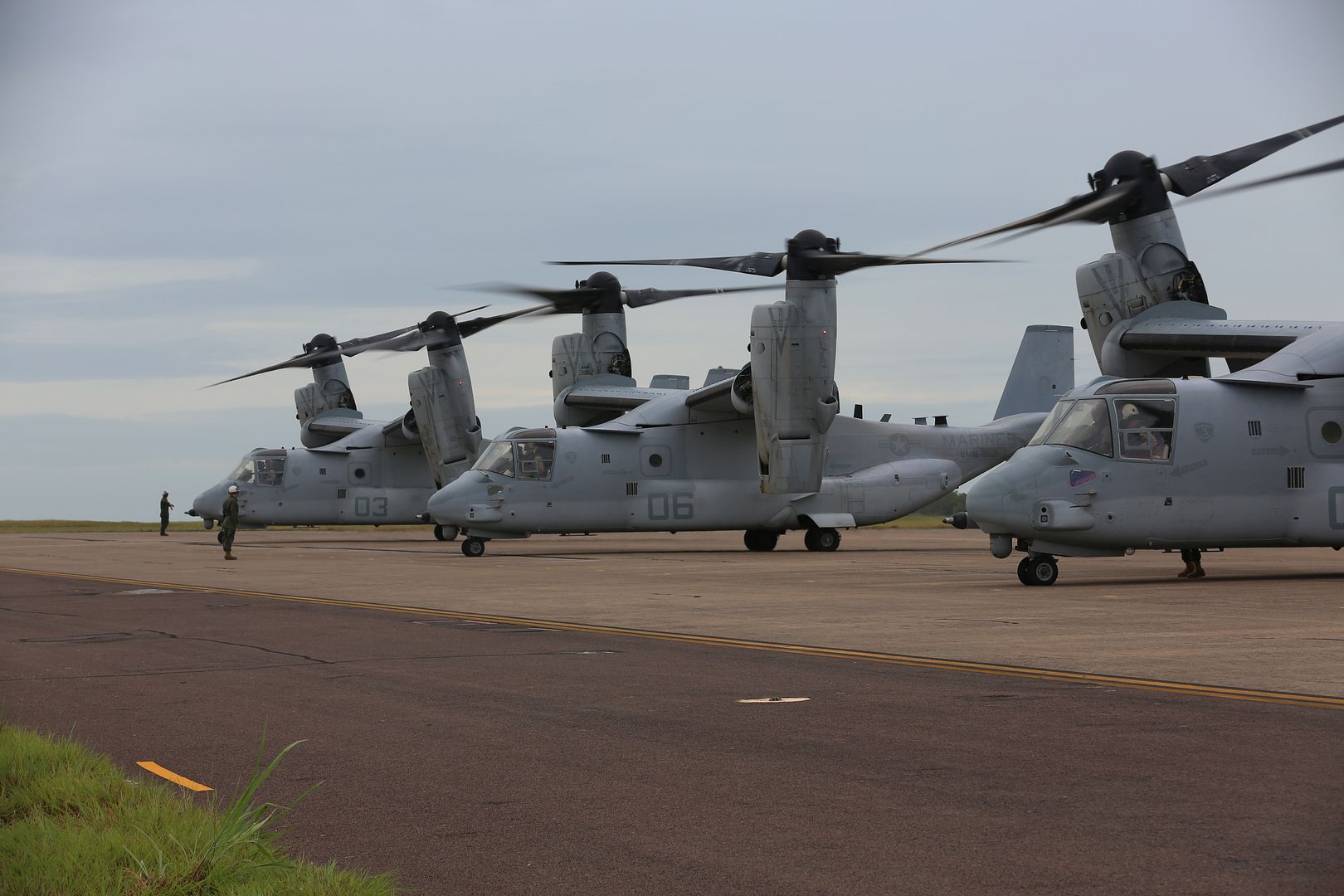
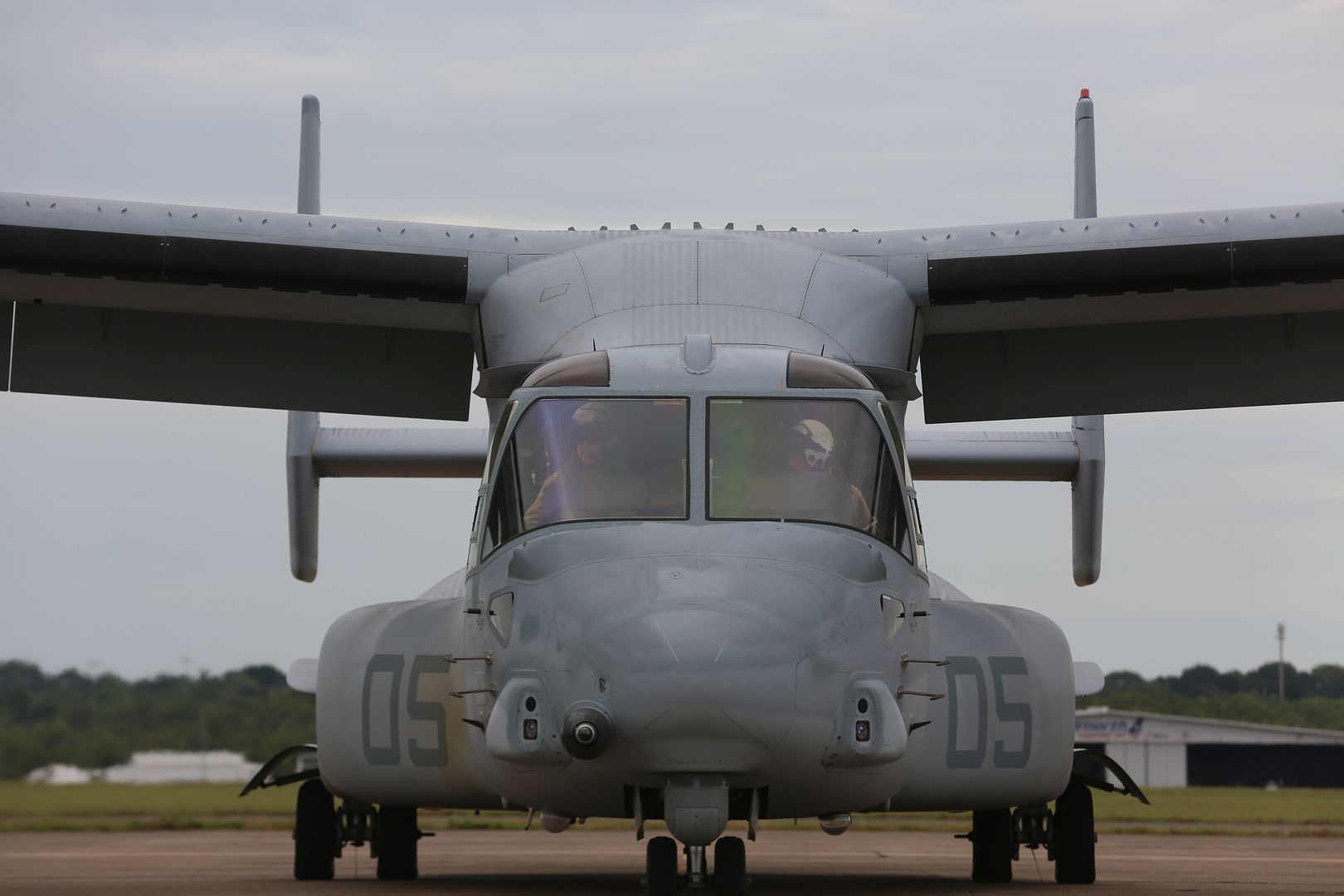
ROYAL AIR FORCE LAKENHEATH, England, -- The F-35A continues to prove itself a game changer as Airmen train together during the aircraft?s first overseas deployment.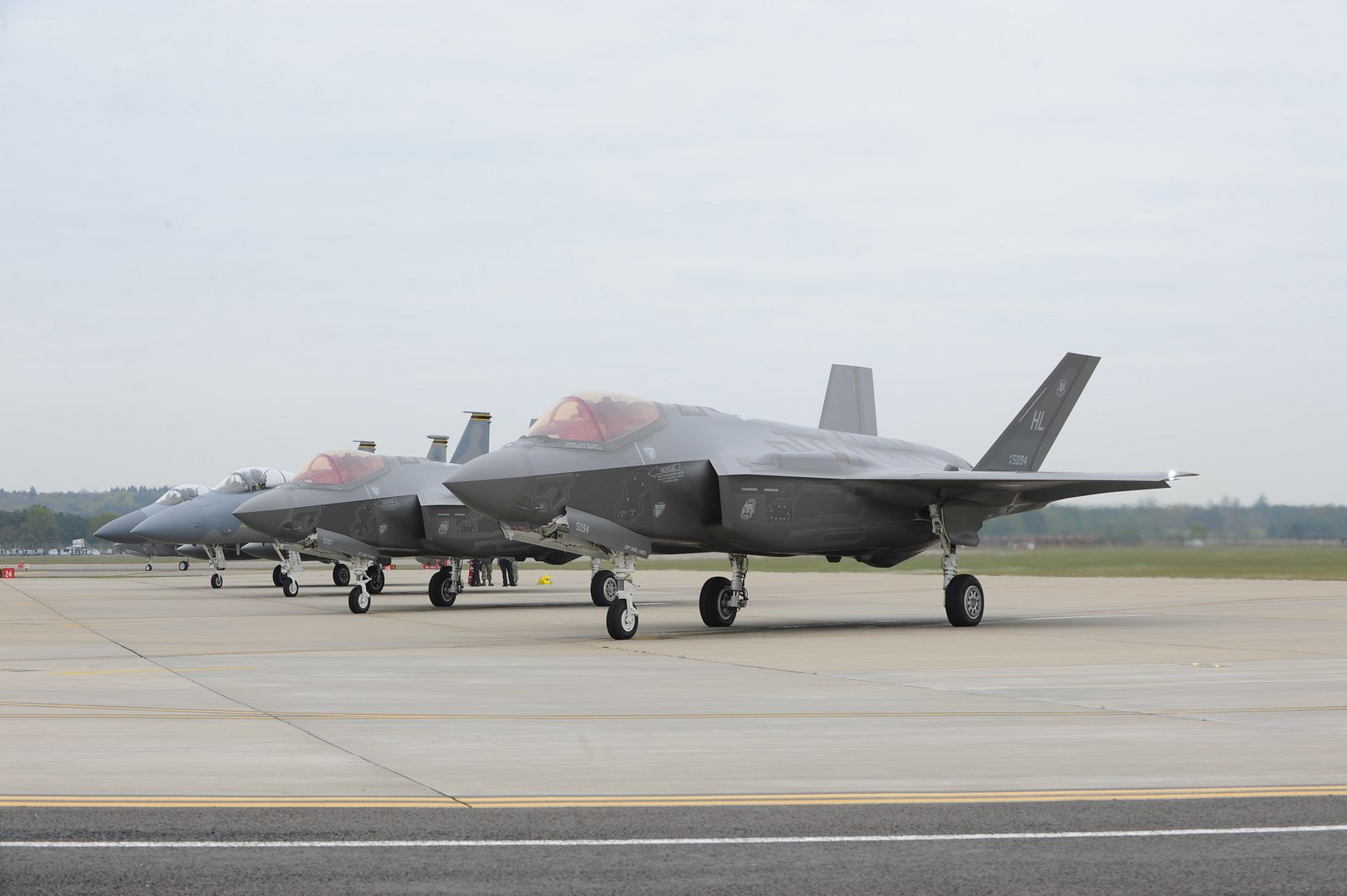
Eight F-35As and more than 200 Airmen from the active duty 388th and Reserve 419th Fighter Wings at Hill Air Force Base, Utah, deployed here April 15. Pilots and maintainers are generating roughly 10 sorties a day, training alongside F-15Cs and F-15Es from the 48th Fighter Wing, as well as the Royal Air Force and other NATO allies.
Integrating with the F-35 is a new experience for many of the F-15 pilots.
?The sensor fusion capability of the F-35A gives (our F-15s) unprecedented situation awareness which is invaluable when you?re fighting against a high-end threat,? said Lt. Col. Scott Taylor, F-15C pilot and director of operations at Lakenheath?s 493rd Fighter Squadron. ?The key is it allows us to make quicker, more accurate decisions on targets.?
The squadrons started the training deployment by flying simple missions and have progressed to more complex scenarios.
?We?ve been flying basic fighter maneuvers and air combat maneuvers, as well as air to ground missions,? said Lt. Col. George Watkins, F-35 pilot and 34th Fighter Squadron commander. ?We fight air-to-air to get to simulated ground targets and once we take them out, we fight air-to-air to get back to our designated ?safe? zone.?
Pilots say the F-35A?s stealth and sensor capabilities increase the survivability of fourth generation aircraft and fourth generation aircraft make the F-35A more lethal.
?The stealth ability of the aircraft allows us to go where other aircraft cannot and our sensors and communication allow us to identify targets so fourth generation aircraft can dominate the airspace,? Watkins said.
The squadrons have also been flying against each other. F-15Cs are well known for being an air-dominance platform, and the F-35A pilots are enjoying the unique opportunity to fly against other Airmen in a foreign country in airspace they?ve never before flown in with the F-35A.
?For me, it?s my first time dogfighting against an F-15,? said Maj. Luke Harris, an F-35A pilot with the 34th Fighter Squadron. ?Dogfighting is a test of pilot skill, but it?s also constrained by the aircraft?s capabilities and I?ve been really impressed by the flight control and maneuverability of the F-35.?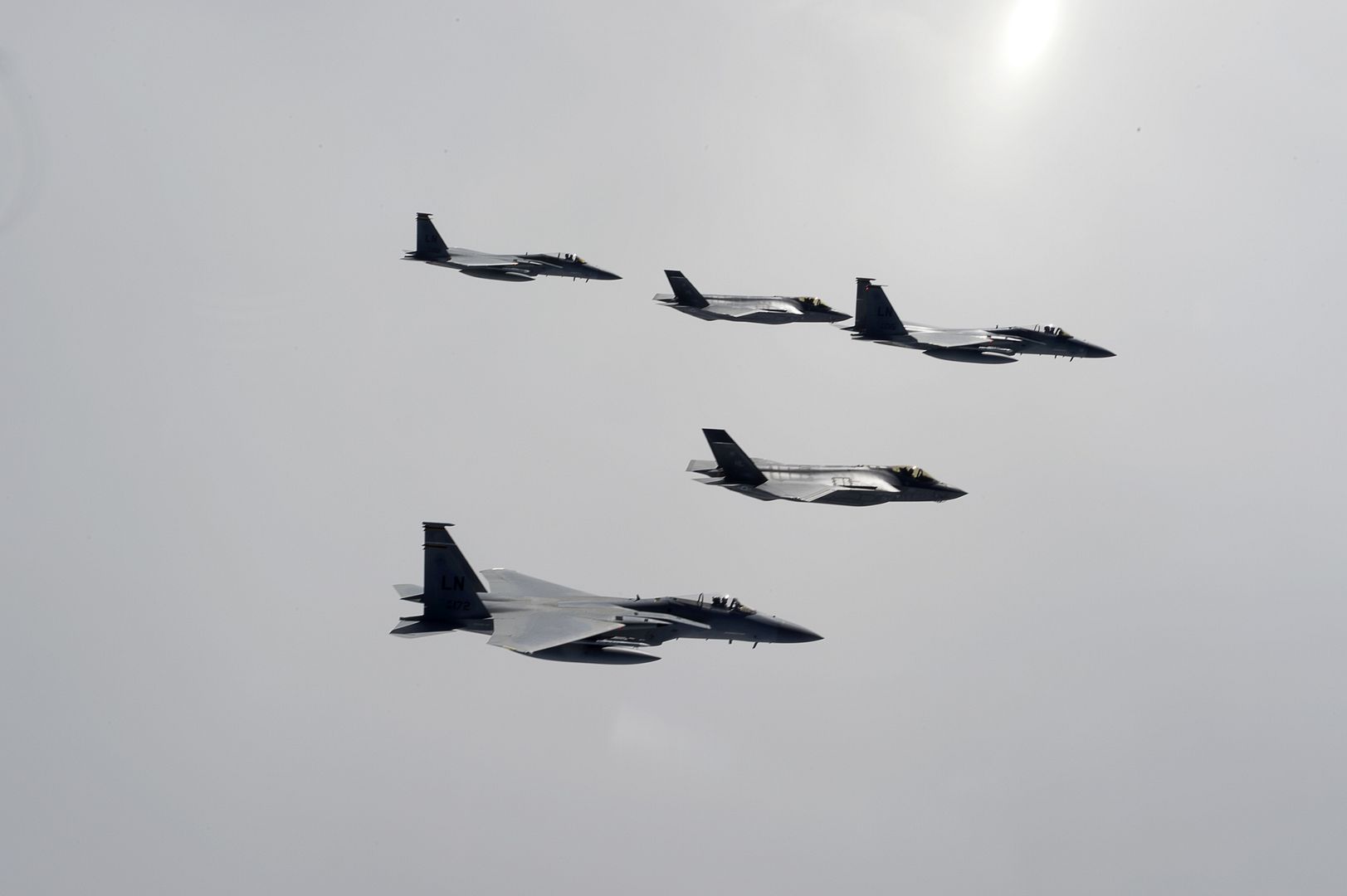
However, with the F-35A?s stealth capability Harris said dogfights aren?t likely. Stealth allows pilots to fly undetected to a ?visual merge? and engage air targets before enemies have time to react defensively, which is an advantage over the fourth-generation tactics he employed when he flew the F-16.
?All the guys we?ve flown with have said that having the F-35 in the fight has been an eye-opening experience and they?re glad that these capabilities are on their side,? Harris said.
The training scenarios have allowed fourth and fifth generation pilots to compare notes and better prepare for future air combat.
?We fight best when we fight together. We?ve had a lot of synergy in our training. When we come back and talk after missions, we can have that face-to-face interaction and review our tactics. That?s just going to improve the way we fight with the F-35A and has made this an outstanding deployment,? Taylor said.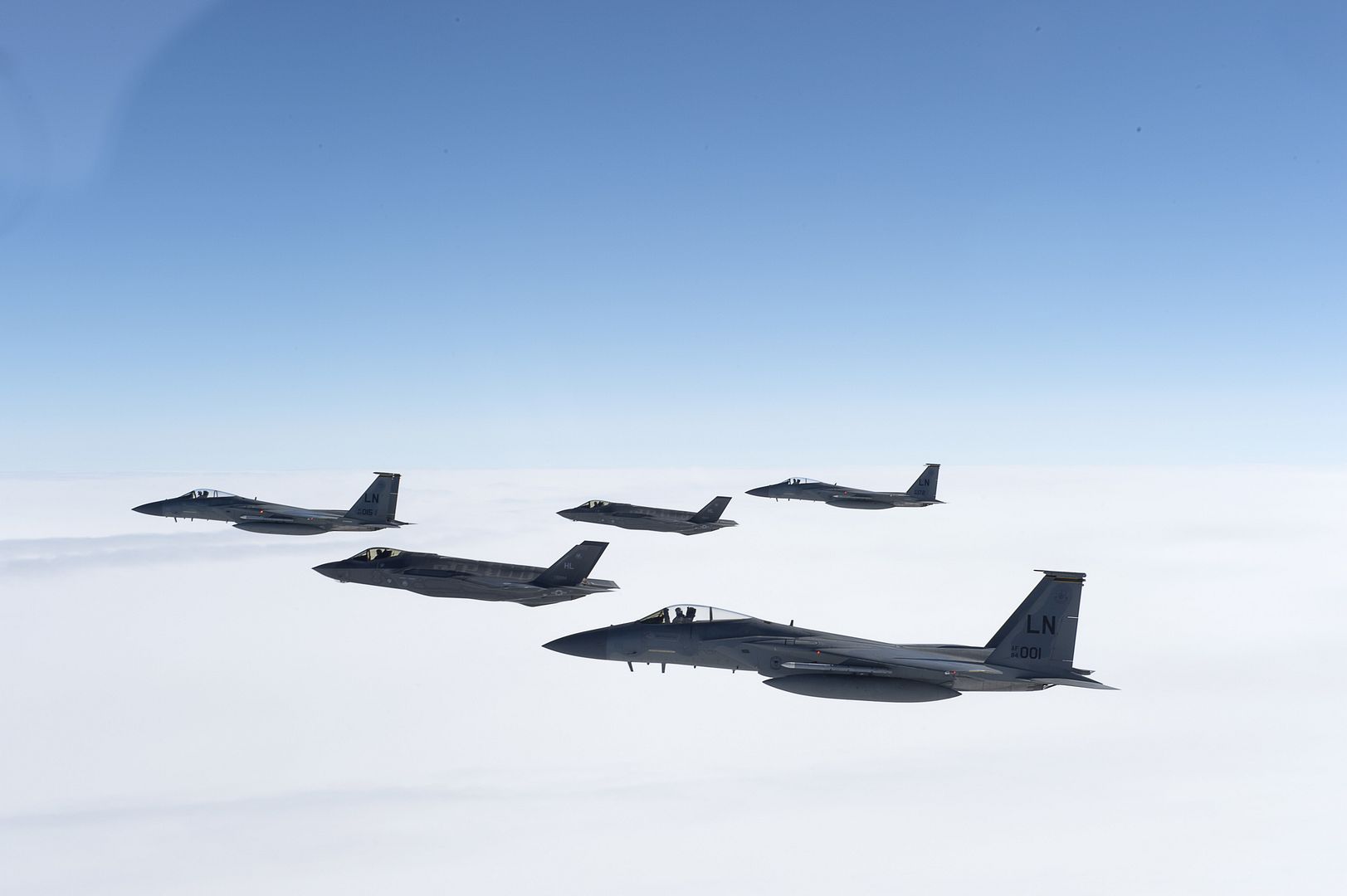
A U.S. Air Force F-22 Raptor aircraft assigned to Tyndall Air Force Base flies in formation with a World War II-era P-51 Mustang, April 22, 2017 over Panama City Beach, Fla. The aircraft flew in support of the opening ceremony of the Gulf Coast Salute Airshow at Tyndall. (U.S. Air Force photo by Staff Sgt. Jason Couillard)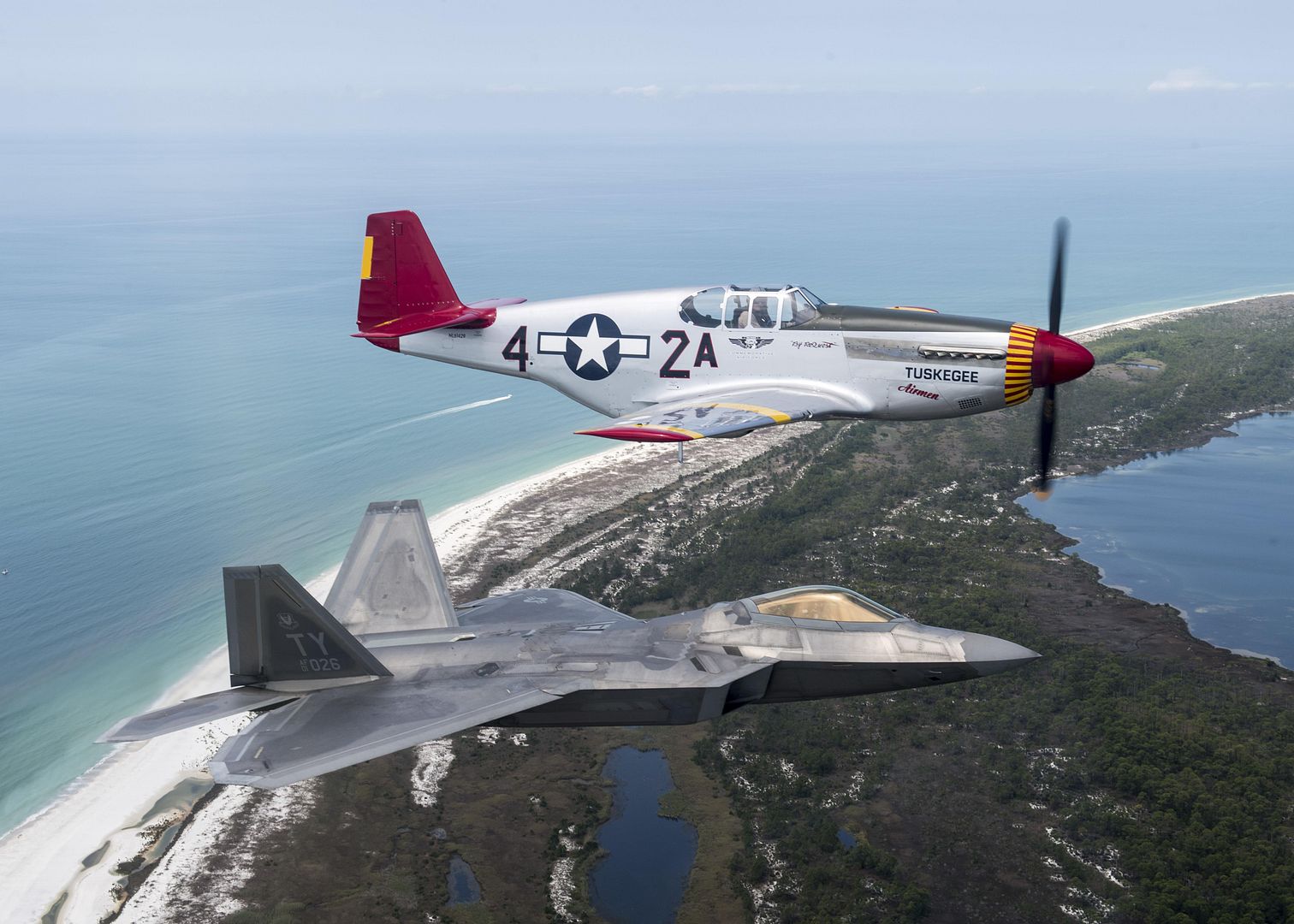
RAF TYPHOON DETACHMENT CERTIFIED FOR ENHANCED AIR POLICING IN ROMANIA
The RAF aircraft deployed to Romania are part of the UK?s contribution to reassurance measures to ensure the operational capability of NATO's eastern flank. The EAP mission demonstrates NATO?s flexible capabilities and readiness, underlining the commitment of Allies to each other.
-
 Main AdminA U.S. Marine Corps AH-1Z Cobra assigned to Marine Aviation Weapons and Tactics Squadron One (MAWTS-1) lands during the final exercise (FINEX) two as part of Weapons and Tactics Instructor course (WTI) 2-17 at Yuma Ariz., April 27, 2017. The FINEX exercise is designed to execute a simulated special operating forces raid while simultaneously supporting regimental combat team objectives and focusing on conducting all six functions of Marine Aviation. WTI is a seven-week training event hosted by MAWTS-1 cadre, which emphasizes operational integration of the six functions of Marine Corps aviation in support of a Marine Air Ground Task Force and provides standardized advanced tactical training and certification of unit instructor qualifications to support Marine Aviation Training and Readiness and assists in developing and employing aviation weapons and tactics. (U.S. Marine Corps photo by Cpl. AaronJames B. Vinculado.)
Main AdminA U.S. Marine Corps AH-1Z Cobra assigned to Marine Aviation Weapons and Tactics Squadron One (MAWTS-1) lands during the final exercise (FINEX) two as part of Weapons and Tactics Instructor course (WTI) 2-17 at Yuma Ariz., April 27, 2017. The FINEX exercise is designed to execute a simulated special operating forces raid while simultaneously supporting regimental combat team objectives and focusing on conducting all six functions of Marine Aviation. WTI is a seven-week training event hosted by MAWTS-1 cadre, which emphasizes operational integration of the six functions of Marine Corps aviation in support of a Marine Air Ground Task Force and provides standardized advanced tactical training and certification of unit instructor qualifications to support Marine Aviation Training and Readiness and assists in developing and employing aviation weapons and tactics. (U.S. Marine Corps photo by Cpl. AaronJames B. Vinculado.)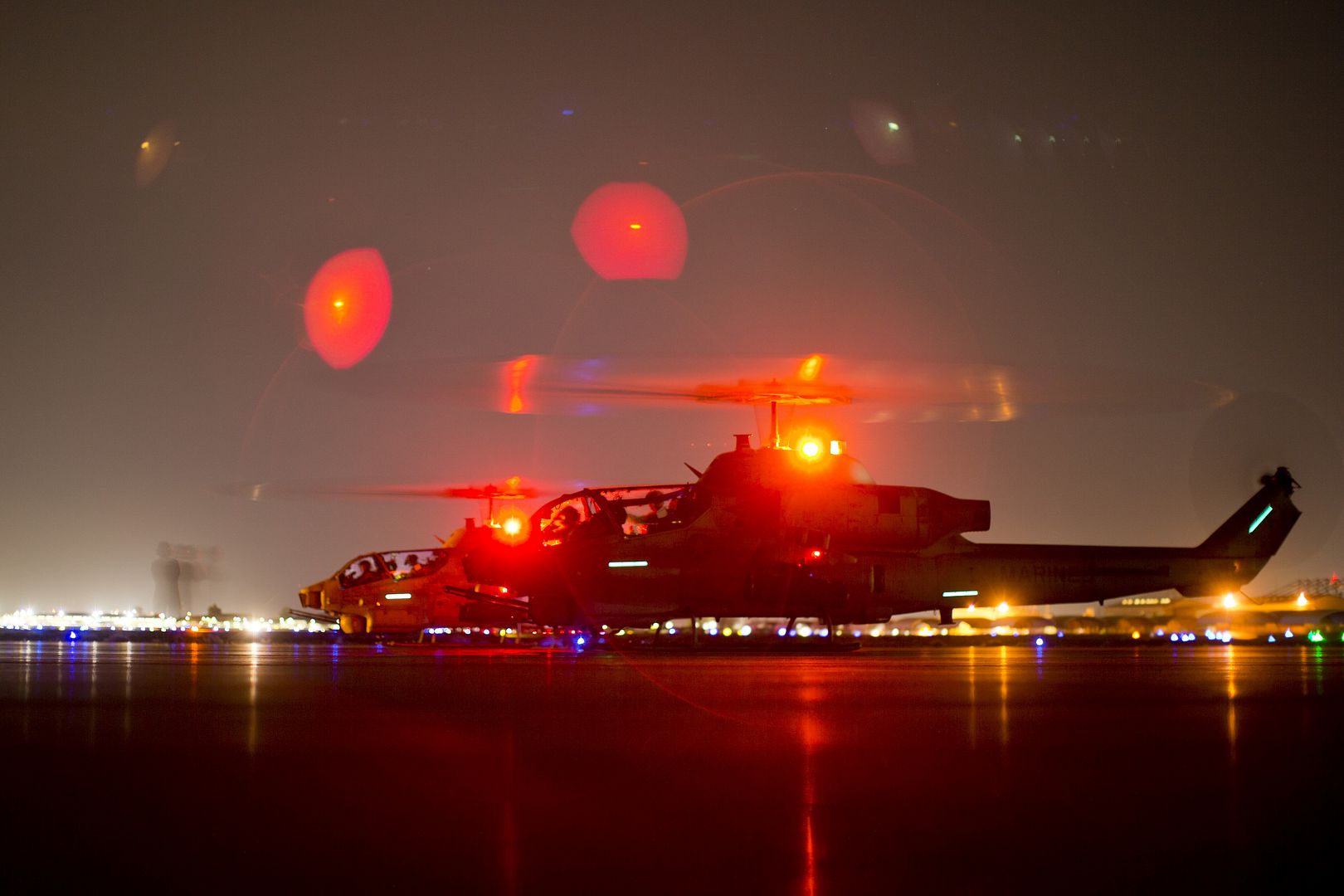
A U.S. Marine Corps UH-1Y Huey assigned to Marine Aviation Weapons and Tactics Squadron One (MAWTS-1) lands during the final exercise (FINEX) two as part of Weapons and Tactics Instructor course (WTI) 2-17 at Yuma Ariz., April 27, 2017. The FINEX exercise is designed to execute a simulated special operating forces raid while simultaneously supporting regimental combat team objectives and focusing on conducting all six functions of Marine Aviation. WTI is a seven-week training event hosted by MAWTS-1 cadre, which emphasizes operational integration of the six functions of Marine Corps aviation in support of a Marine Air Ground Task Force and provides standardized advanced tactical training and certification of unit instructor qualifications to support Marine Aviation Training and Readiness and assists in developing and employing aviation weapons and tactics. (U.S. Marine Corps photo by Cpl. AaronJames B. Vinculado)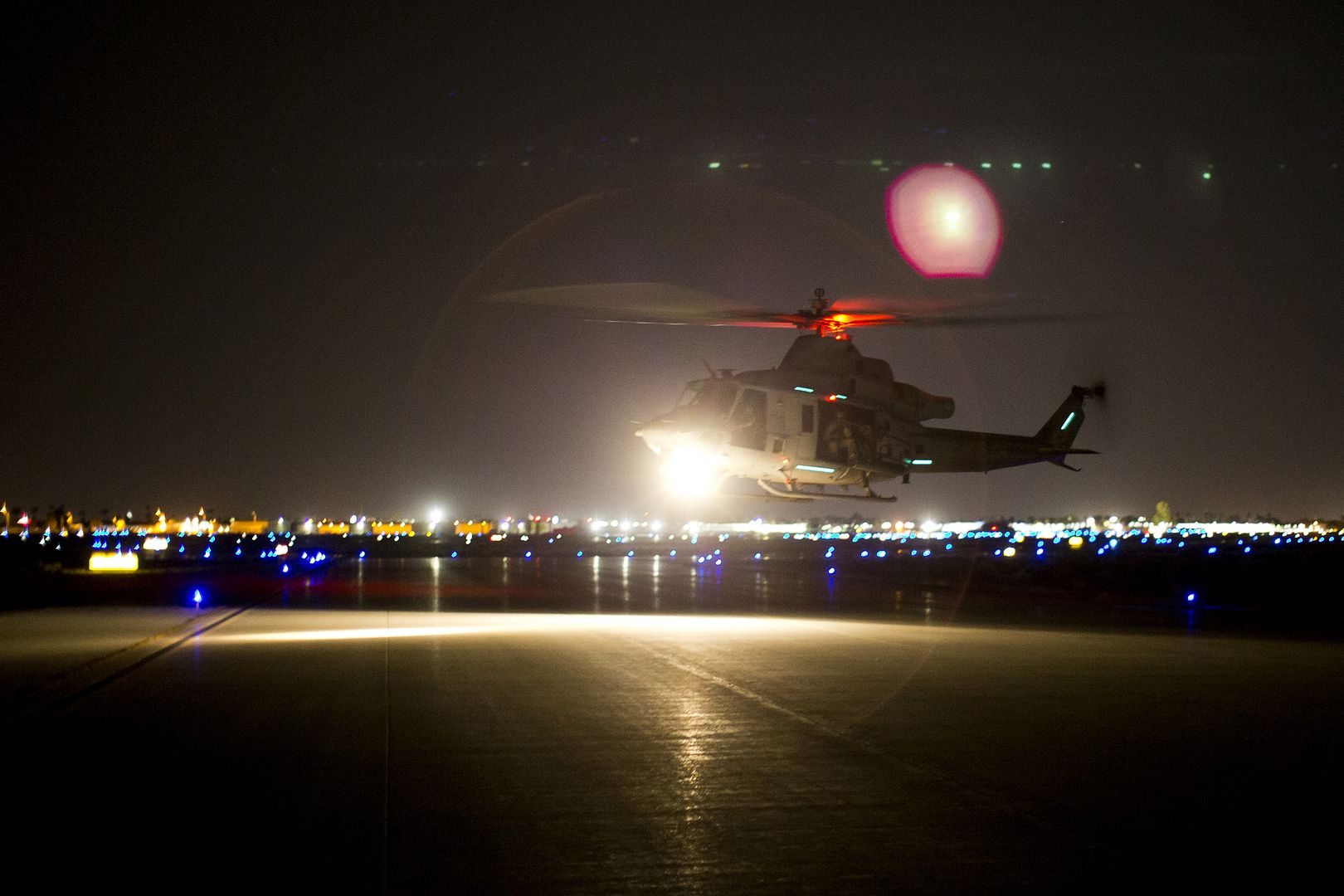
U.S. Marine Corps Capt. S. Bruggeman, a pilot with Marine Medium Tiltrotor Squadron (VMM) 162 observes as a C-130 refuels an MV-22B Osprey near the Salton Sea, Calif., April 27, 2017. This exercise is designed to execute a simulated special operating forces raid while simultaneously supporting regimental combat team objectives and focusing on conducting all six functions of Marine Aviation. WTI is a seven-week training event hosted by MAWTS-1 cadre, which emphasizes operational integration of the six functions of Marine Corps aviation in support of a Marine Air Ground Task Force and provides standardized advanced tactical training and certification of unit instructor qualifications to support Marine Aviation Training and Readiness and assists in developing and employing aviation weapons and tactics. (U.S. Marine Corps photo by Lance Cpl. Michaela R. Gregory)
Scott ?Scooter? Yoak returns from performing in his P-51D Mustang aircraft during the 2017 MCAS Beaufort Air Show aboard Marine Corps Air Station Beaufort, April 29. MCAS Beaufort holds air shows to promote the Marine Corps and Navy recruiting efforts, to demonstrate the full force and capabilities of our military and to show appreciation to all of the members of the surrounding communities who support the men and women who serve this nation and are stationed at the Air Station and in the Tri-Command area.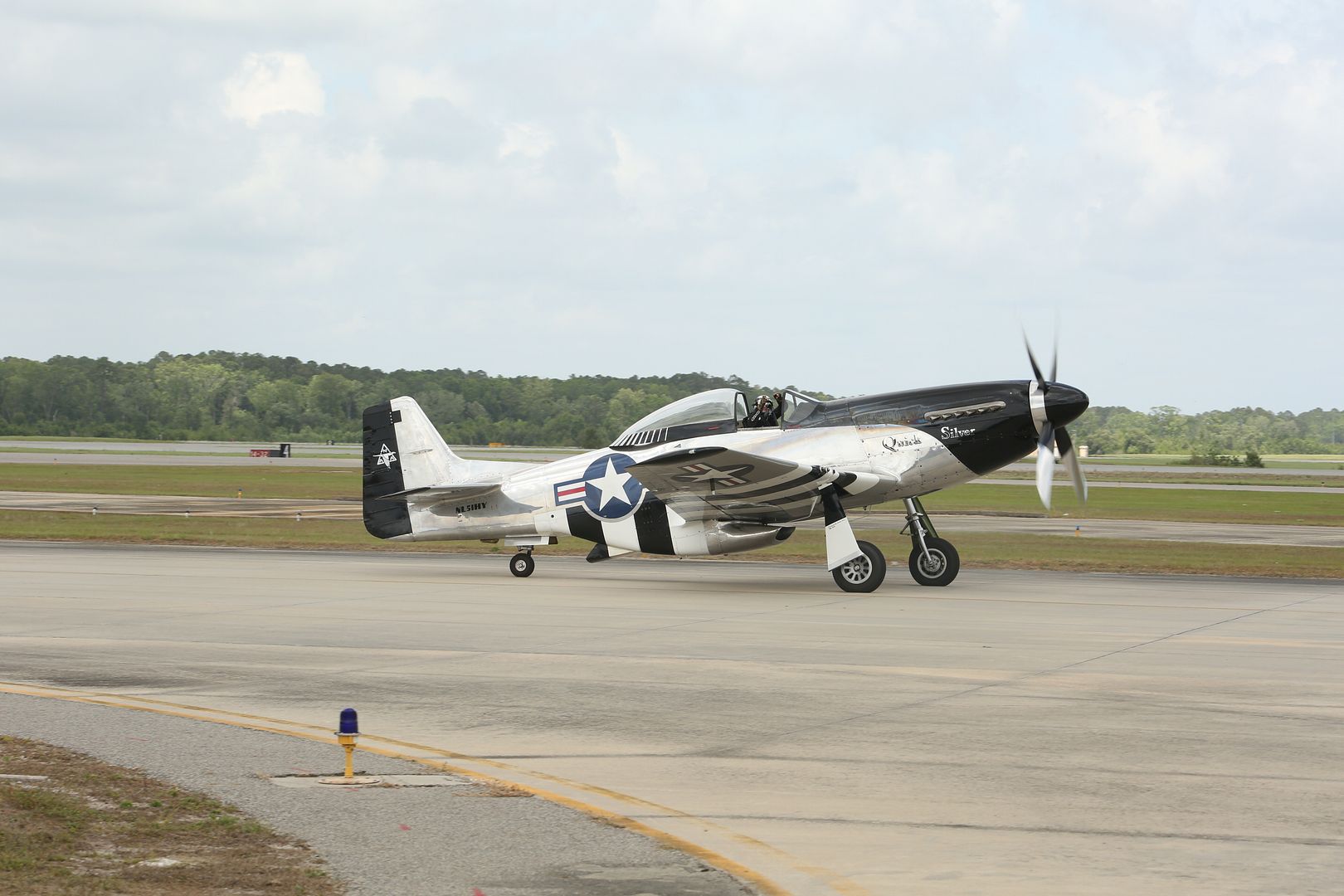
An AV-8B Harrier II flies over the 2017 Air Show aboard Marine Corps Air Station Beaufort, April 30. MCAS Beaufort hosts the air show in order to bring the community together and demonstrate U.S. Marine Corps Aviation Combat Element and Marine Air-Ground Task Force capabilities.
Photo by Lance Cpl. Benjamin McDonald.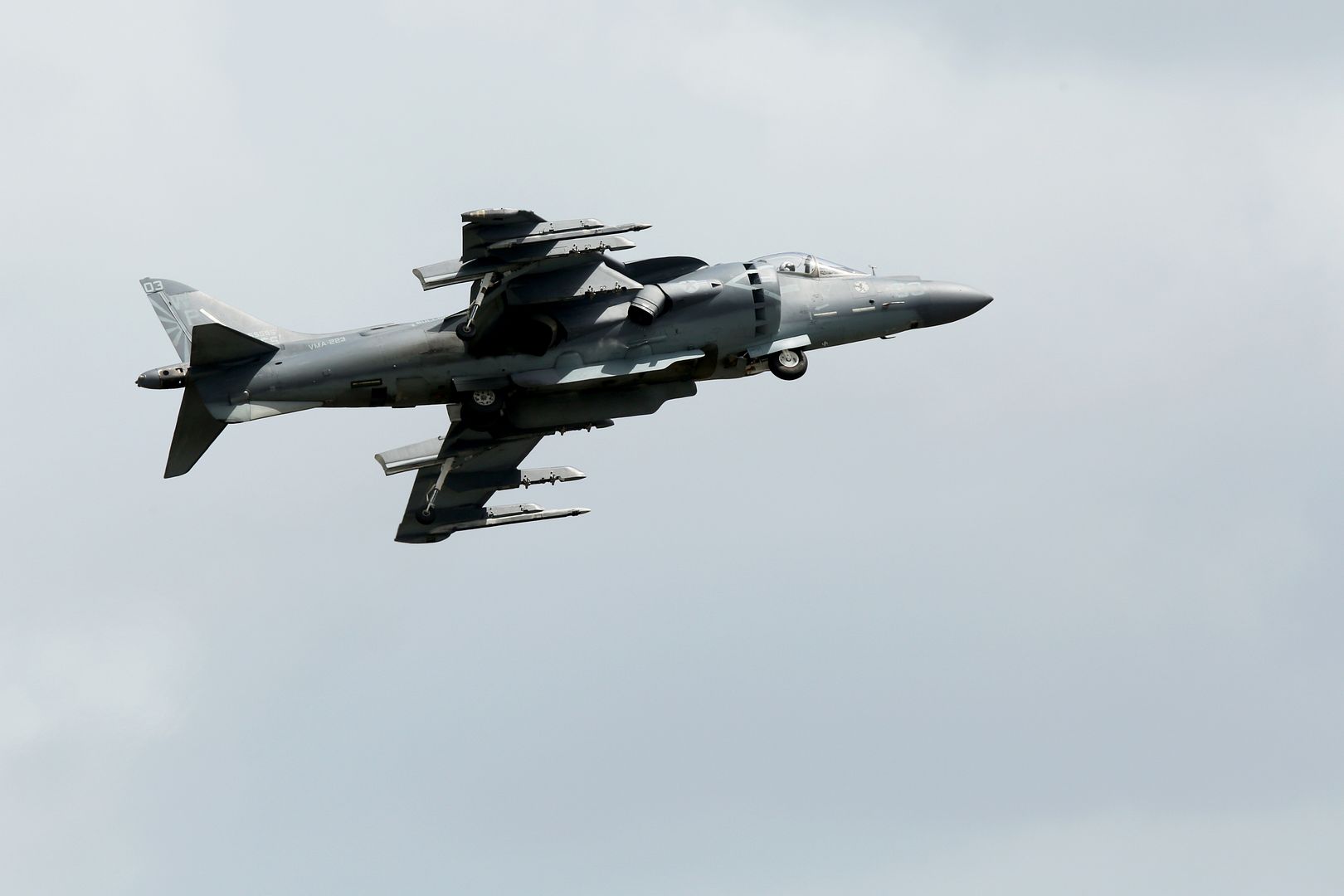
-
 Main AdminA U.S. Air Force F-35A Lightning II assigned to Hill Air Force Base, Utah, prepares to be refueled during a flight to Graf Ignatievo Air Base, Bulgaria, April 28, 2017. Eight F-35s deployed to Royal Air Force Lakenheath, England, on April 15 and two forward deployed to Bulgaria for a brief time which allowed the F-35s to engage in familiarization training within the European theater while reassuring allies and partners of U.S. dedication to the enduring peace and stability of the region. (U.S. Air Force photo/Staff Sgt. Kate Thornton)
Main AdminA U.S. Air Force F-35A Lightning II assigned to Hill Air Force Base, Utah, prepares to be refueled during a flight to Graf Ignatievo Air Base, Bulgaria, April 28, 2017. Eight F-35s deployed to Royal Air Force Lakenheath, England, on April 15 and two forward deployed to Bulgaria for a brief time which allowed the F-35s to engage in familiarization training within the European theater while reassuring allies and partners of U.S. dedication to the enduring peace and stability of the region. (U.S. Air Force photo/Staff Sgt. Kate Thornton)
Boeing B-52H Stratofortress, 60-0005, poses in front of Oklahoma City Air Logistics Complex Bldg. 3001 following major overhaul on May 1, 2017, Tinker Air Force Base, Oklahoma. OC-ALC is responsible for depot level maintenance of the B-52 fleet as well as the B-1B Lancer and KC-135 Stratotanker and a large portion of the work takes place in the almost one-mile long building. (U.S. Air Force photo/Greg L. Davis)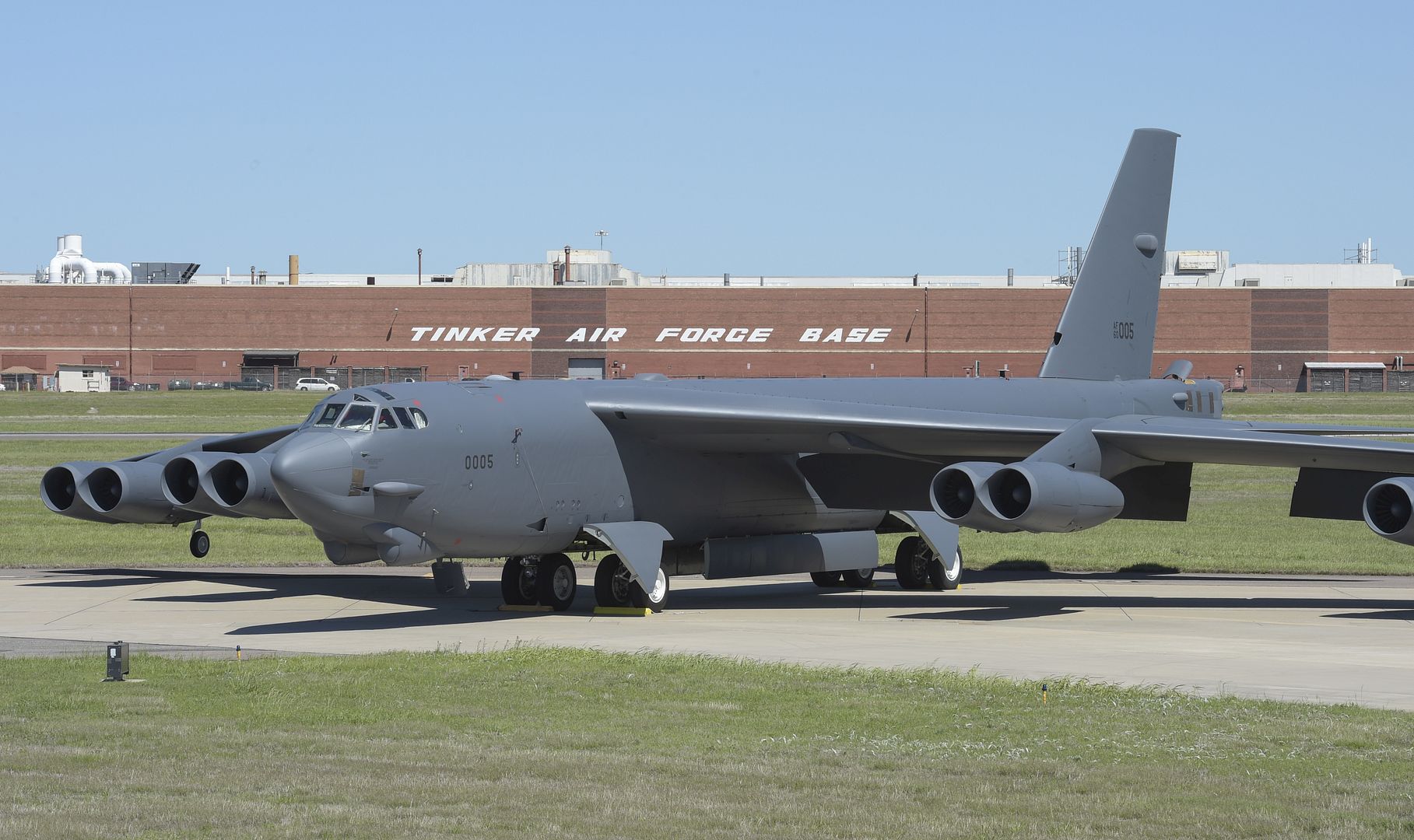
A U.S. Navy Growler of the Third Fleet, fly through the skies above Joint Base Elmendorf-Richardson, Alaska, for exercise Northern Edge 2017, May 2, 2017. This exercise is Alaska?s largest and premier joint training exercise designed to practice operations, techniques and procedures as well as enhance interoperability among the services. Approximately 6,000 U.S. military personnel and more than 200 military aircraft from the Marine Corps, Navy, Air Force, Army and Coast Guard are involved. (U.S. Marine Corps photo by Lance Cpl. Andy Martinez)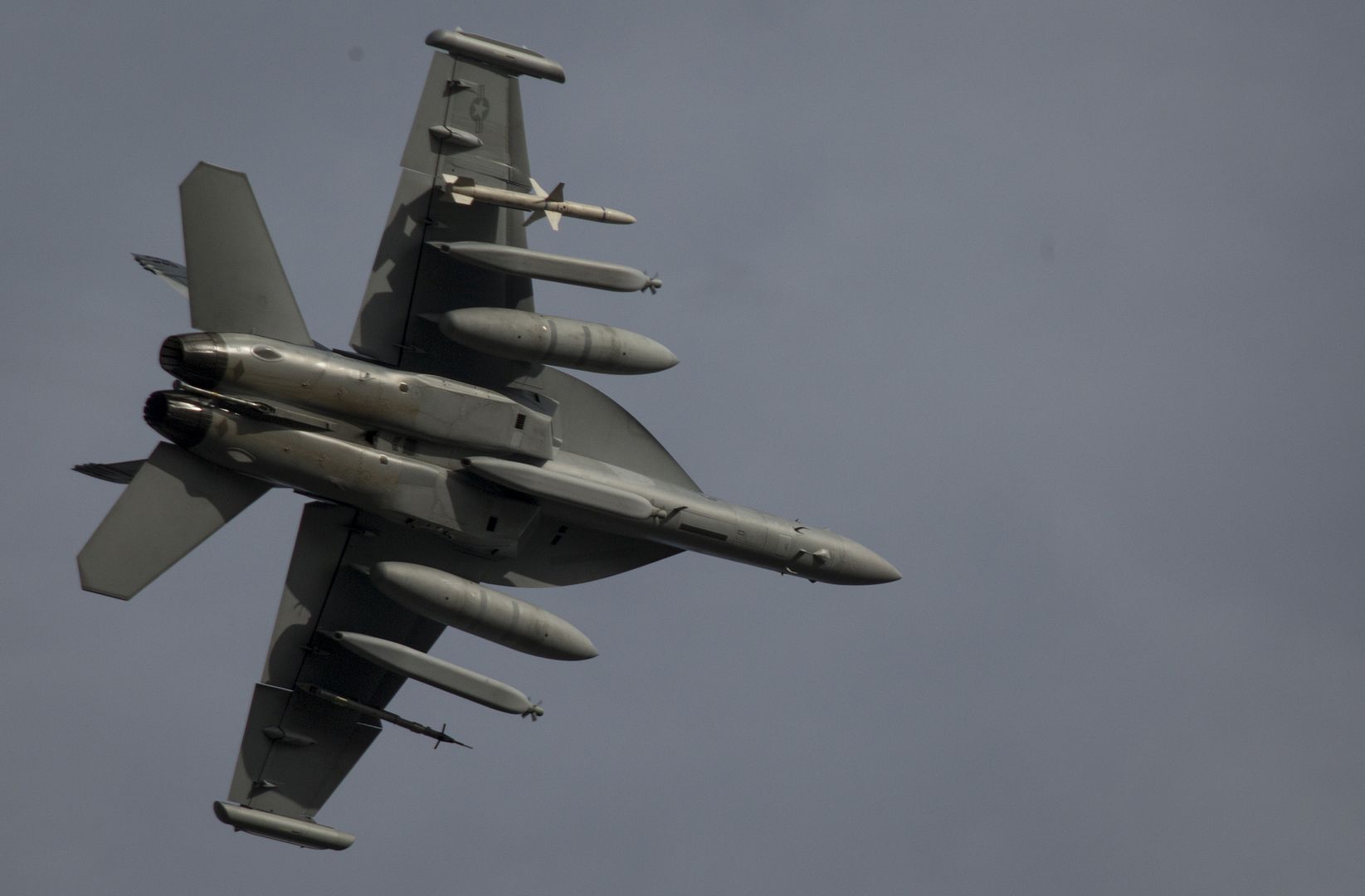
A U.S. Air Force F-15C Eagle aircraft fly through the skies above Joint Base Elmendorf-Richardson, Alaska, for exercise Northern Edge 2017, May 2, 2017. This exercise is Alaska?s largest and premier joint training exercise designed to practice operations, techniques and procedures as well as enhance interoperability among the services. Thousands of participants from all the services, Airmen, Soldiers, Sailors, Marines and Coast Guard personnel from active duty, Reserve and National Guard units are involved. (U.S. Marine Corps photo by Lance Cpl. Andy Martinez)
A U.S. Air Force F-22 Raptor aircraft with 3rd Wing, soars through the skies above Joint Base Elmendorf-Richardson, Alaska, for exercise Northern Edge 2017, May 2, 2017. This exercise is Alaska?s largest and premier joint training exercise designed to practice operations, techniques and procedures as well as enhance interoperability among the services. Thousands of participants from all the services, Airmen, Soldiers, Sailors, Marines and Coast Guard personnel from active duty, Reserve and National Guard units are involved. (U.S. Marine Corps photo by Lance Cpl. Andy Martinez)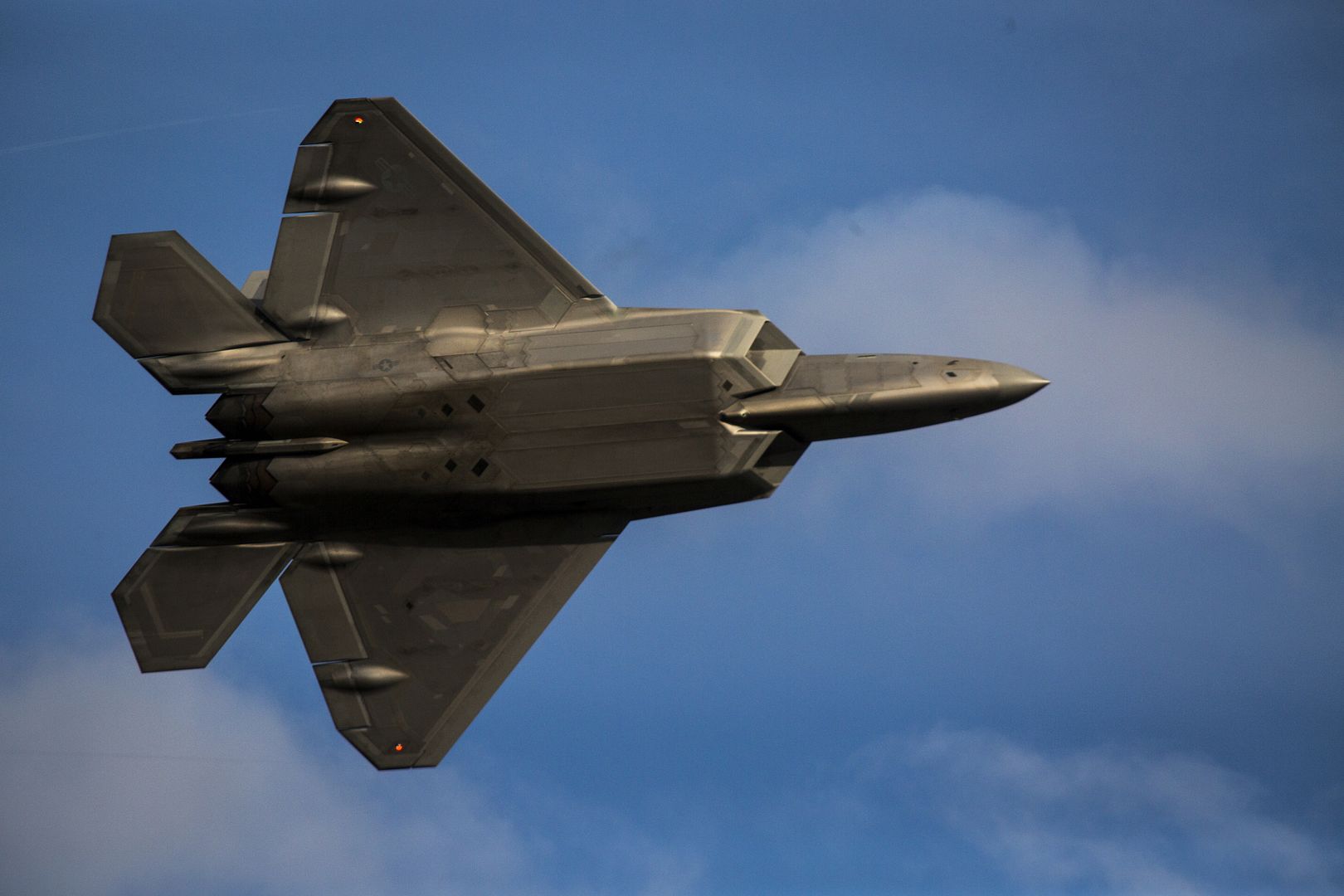
JOINT BASE ELMENDORF-RICHARDSON, Alaska ? A U.S. Navy Growler takes off during exercise Northern Edge 17, May 2, 2017. Northern Edge 2017 is Alaska?s premier joint training exercise designed to practice operations, techniques and procedures as well as enhance interoperability among the services. Thousands of participants from all the services, Airmen, Soldiers, Sailors, Marines and Coast Guardsmen from active duty, Reserve and National Guard units are involved. (U.S. Air Force photo by Staff Sgt. Westin Warburton)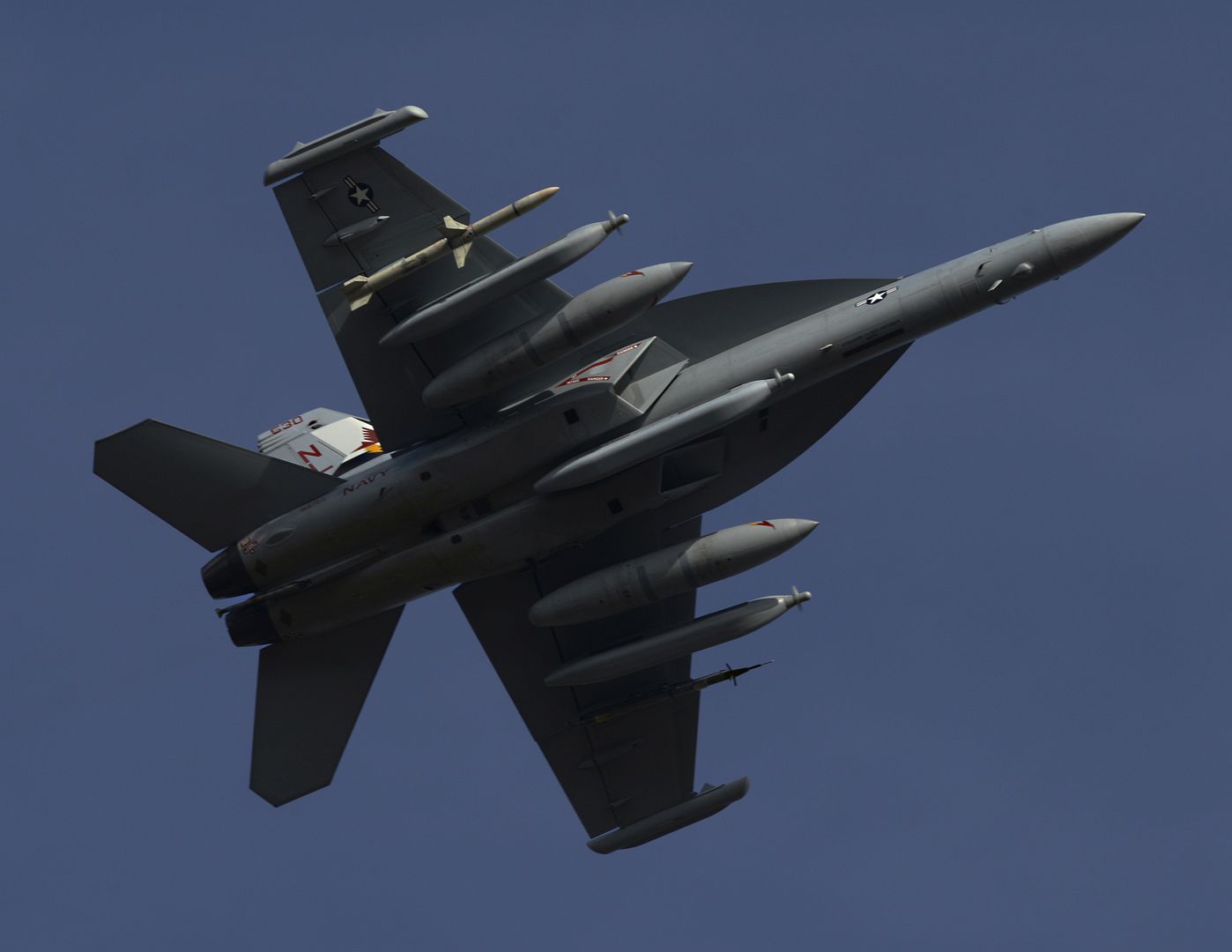
EIELSON AIR FORCE BASE, Alaska ? A U.S. Air Force F-16 Fighting Falcon aircraft assigned to the 18th Aggressor Squadron takes off for a sortie from Eielson Air Force Base, Alaska, May 1, 2017 during NORTHERN EDGE 2017 (NE17). NE17 is Alaska?s premier joint training exercise designed to practice operations, techniques and procedures as well as enhance interoperability among the services. Thousands of participants from all the services, Airmen, Soldiers, Sailors, Marines and Coast Guardsmen from active duty, Reserve and National Guard units are involved. (U.S. Air Force photo/Staff Sgt. Ashley Nicole Taylor)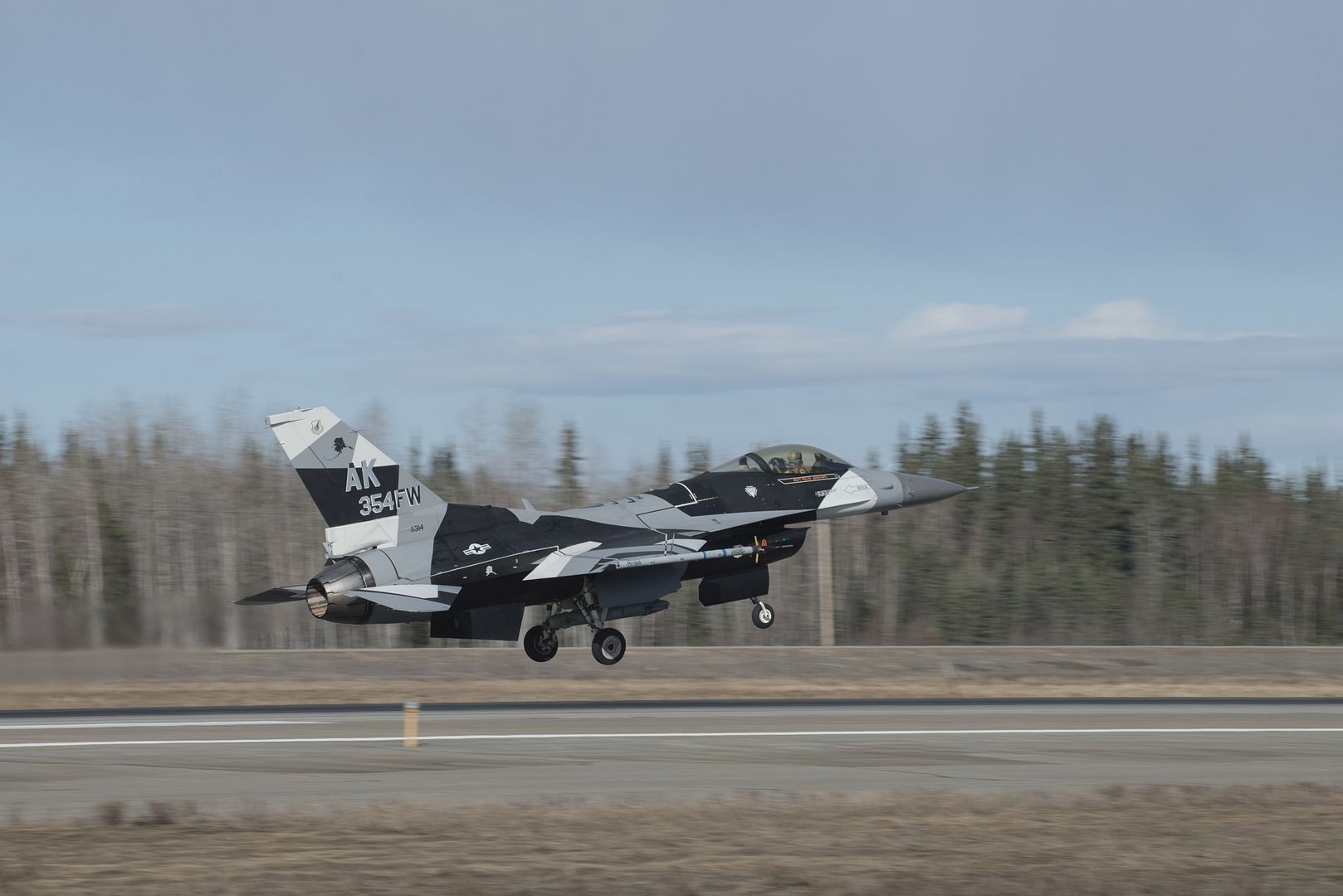
EIELSON AIR FORCE BASE, Alaska ? A U.S. Air Force F-15E Strike Eagle dual-role fighter aircraft assigned to the 335th Fighter Squadron, Seymour Johnson Air Force Base, N.C., takes off for a sortie from Eielson Air Force Base, Alaska, May 1, 2017 during NORTHERN EDGE 2017 (NE17). NE17 is Alaska?s premier joint training exercise designed to practice operations, techniques and procedures as well as enhance interoperability among the services. Thousands of participants from all the services, Airmen, Soldiers, Sailors, Marines and Coast Guardsmen from active duty, Reserve and National Guard units are involved. (U.S. Air Force photo/Staff Sgt. Ashley Nicole Taylor)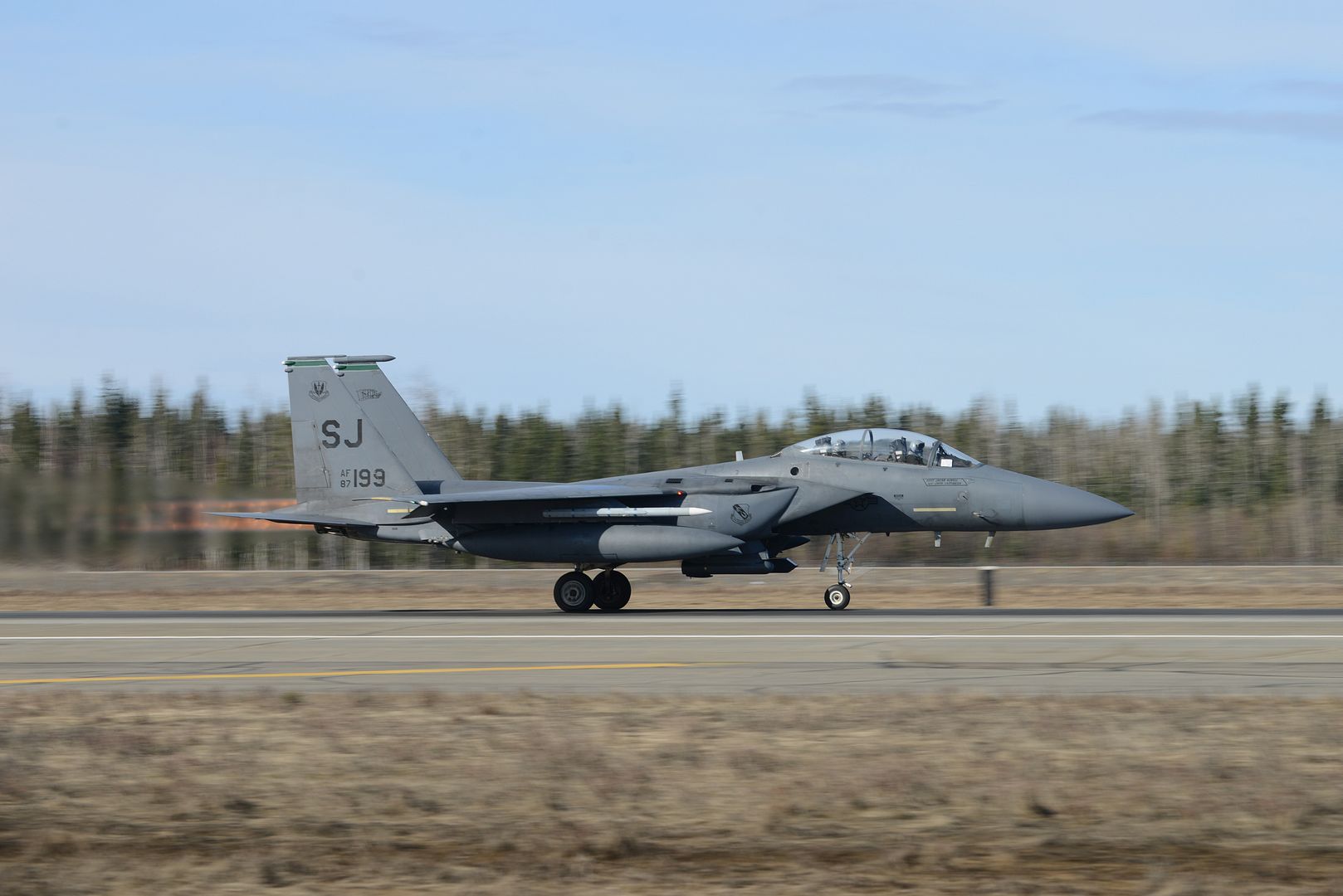
JOINT BASE ELMENDORF-RICHARDSON, Alaska -- An Air Force 3rd Wing F-22 Raptor based here takes off while a 67th Fighter Squadron, 18th Wing, F-15C Eagle, based out of Kadena Airbase, Japan, taxis out to takeoff position on the first day of Exercise Northern Edge 17. Northern Edge is a biennial joint training exercise involving approximately 6,000 personnel, that dates to 1975.
JOINT BASE ELMENDORF-RICHARDSON, Alaska - An EA-18G Growler attached to Electronic Attack Squadron 134 from Whidbey Island Naval Air Station, Washington, taxis across the runway before taking off for a training exercise May 1, 2017. Northern Edge 2017 is Alaska's premiere joint-training exercise designed to practice operations, techniques, and procedures as well as enhance interoperability among the services. Thousands of participants from all the services; Airmen, Soldiers, Sailors, Marines, and Coast Guard personnel from active duty, Reserve and National Guard units, are involved. (U.S. Navy photo by Mass Communications Specialist 2nd Class Travis Litke/Released)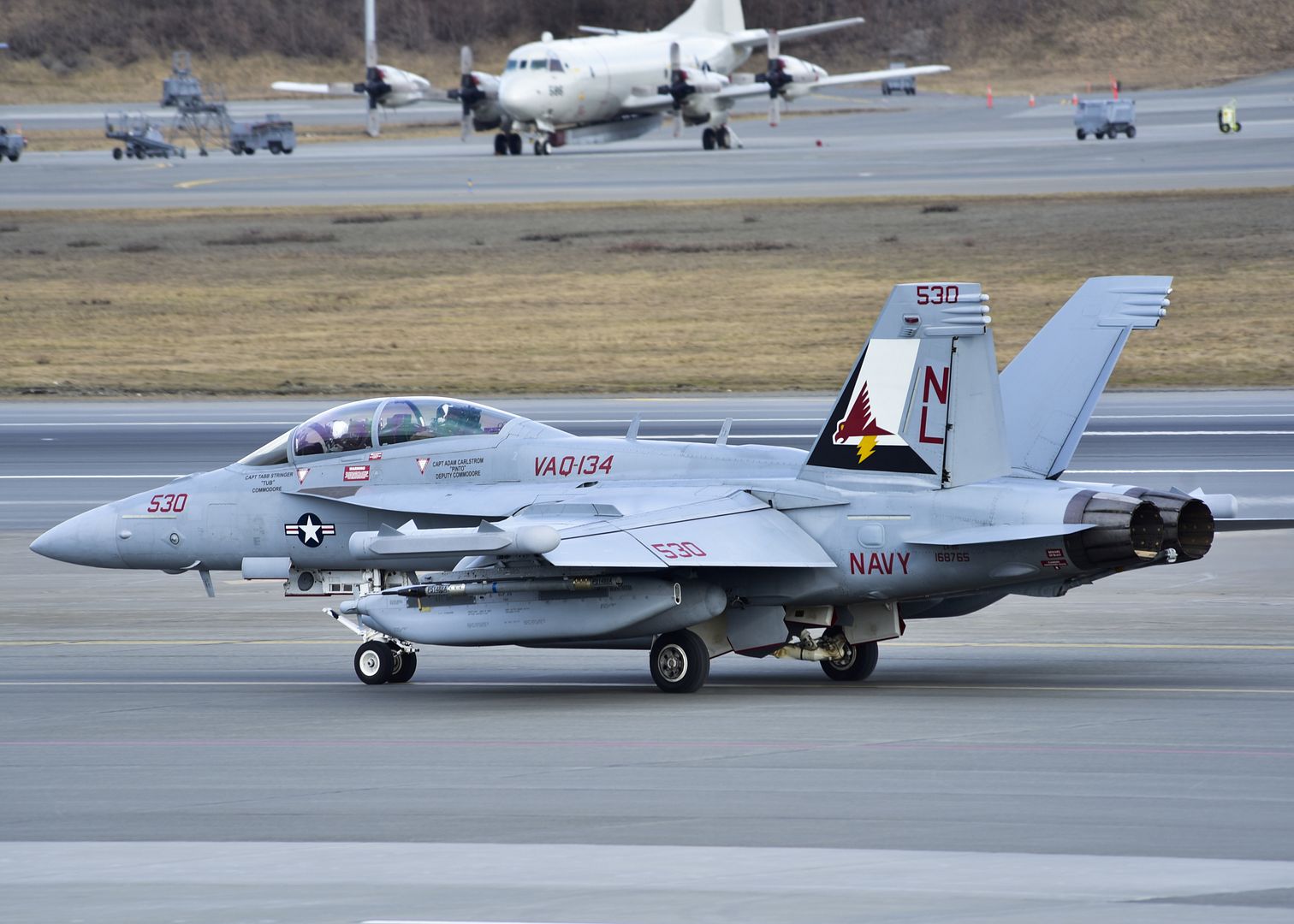
-
 Main AdminA U.S. Marine Corps MV-22B Osprey conducts assault support during final exercise three (FINEX 3) as part of Weapons and Tactics Instructors Course (WTI) 2-17, near Chocolate Mountain Aerial Gunnery Range, Calif., April 29, 2017. FINEX 3 was designed to execute a simulated special operating forces raid while simultaneously supporting regimental combat team objectives and focusing on conducting all six functions of Marine Aviation. WTI is a seven-week training event hosted by Marine Aviation Weapons and Tactics Squadron one (MAWTS-1) cadre, which emphasizes operational integration of the six functions of Marine Corps aviation in support of a Marine Air Ground Task Force and provides standardized advanced tactical training and certification of unit instructor qualifications to support Marine Aviation Training and Readiness and assists in developing and employing aviation weapons and tactics. (U.S. Marine Corps photo by Lance Cpl. Clare J. Shaffer)
Main AdminA U.S. Marine Corps MV-22B Osprey conducts assault support during final exercise three (FINEX 3) as part of Weapons and Tactics Instructors Course (WTI) 2-17, near Chocolate Mountain Aerial Gunnery Range, Calif., April 29, 2017. FINEX 3 was designed to execute a simulated special operating forces raid while simultaneously supporting regimental combat team objectives and focusing on conducting all six functions of Marine Aviation. WTI is a seven-week training event hosted by Marine Aviation Weapons and Tactics Squadron one (MAWTS-1) cadre, which emphasizes operational integration of the six functions of Marine Corps aviation in support of a Marine Air Ground Task Force and provides standardized advanced tactical training and certification of unit instructor qualifications to support Marine Aviation Training and Readiness and assists in developing and employing aviation weapons and tactics. (U.S. Marine Corps photo by Lance Cpl. Clare J. Shaffer)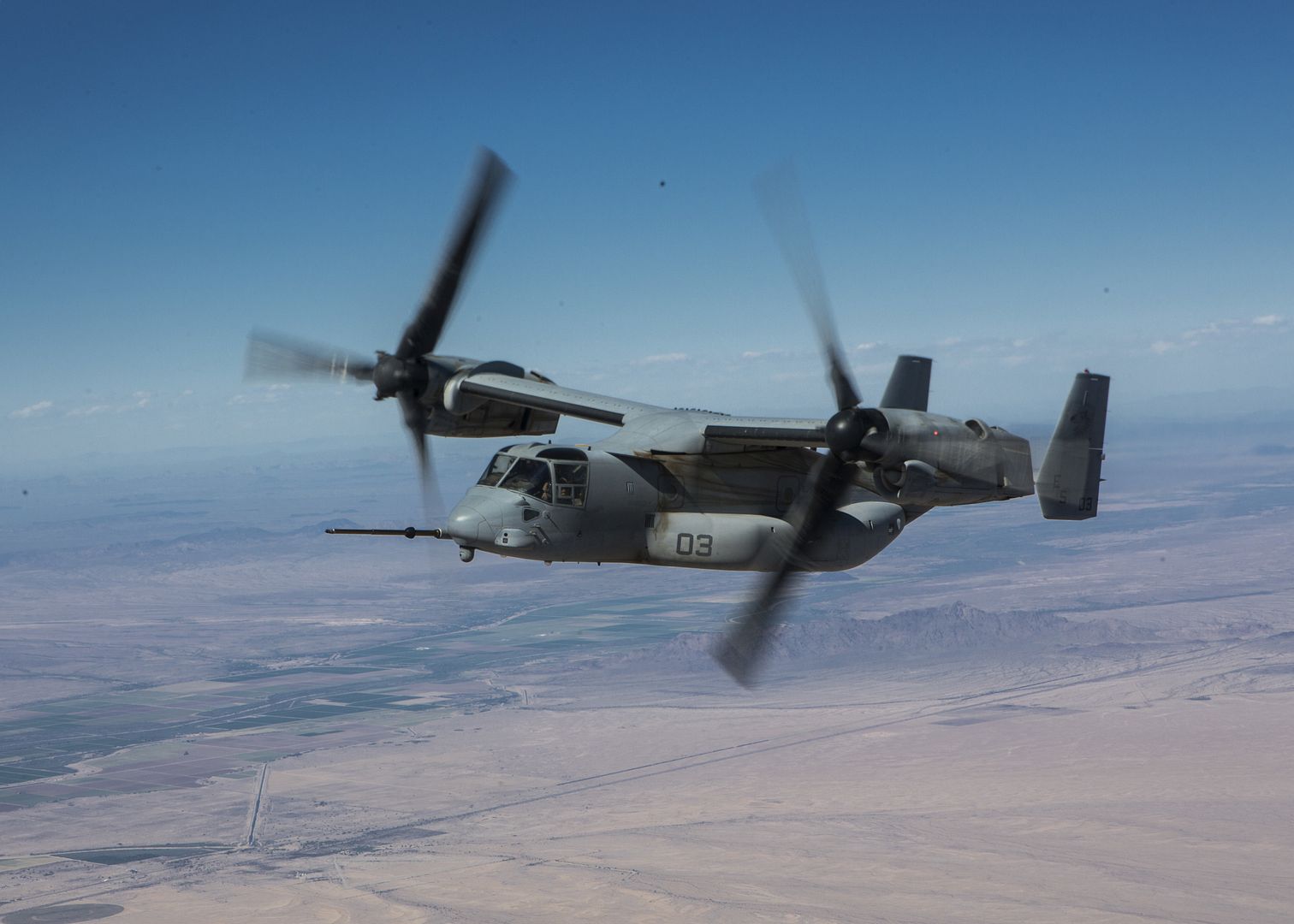
U.S. Marine Corps MV-22B Osprey refuels from a KC-130J Super Hercules during final exercise three (FINEX 3) as part of Weapons and Tactics Instructors Course (WTI) 2-17, near Chocolate Mountain Aerial Gunnery Range, Calif., April 29, 2017. FINEX 3 was designed to execute a simulated special operating forces raid while simultaneously supporting regimental combat team objectives and focusing on conducting all six functions of Marine Aviation. WTI is a seven-week training event hosted by Marine Aviation Weapons and Tactics Squadron one (MAWTS-1) cadre, which emphasizes operational integration of the six functions of Marine Corps aviation in support of a Marine Air Ground Task Force and provides standardized advanced tactical training and certification of unit instructor qualifications to support Marine Aviation Training and Readiness and assists in developing and employing aviation weapons and tactics. (U.S. Marine Corps photo by Lance Cpl. Clare J. Shaffer)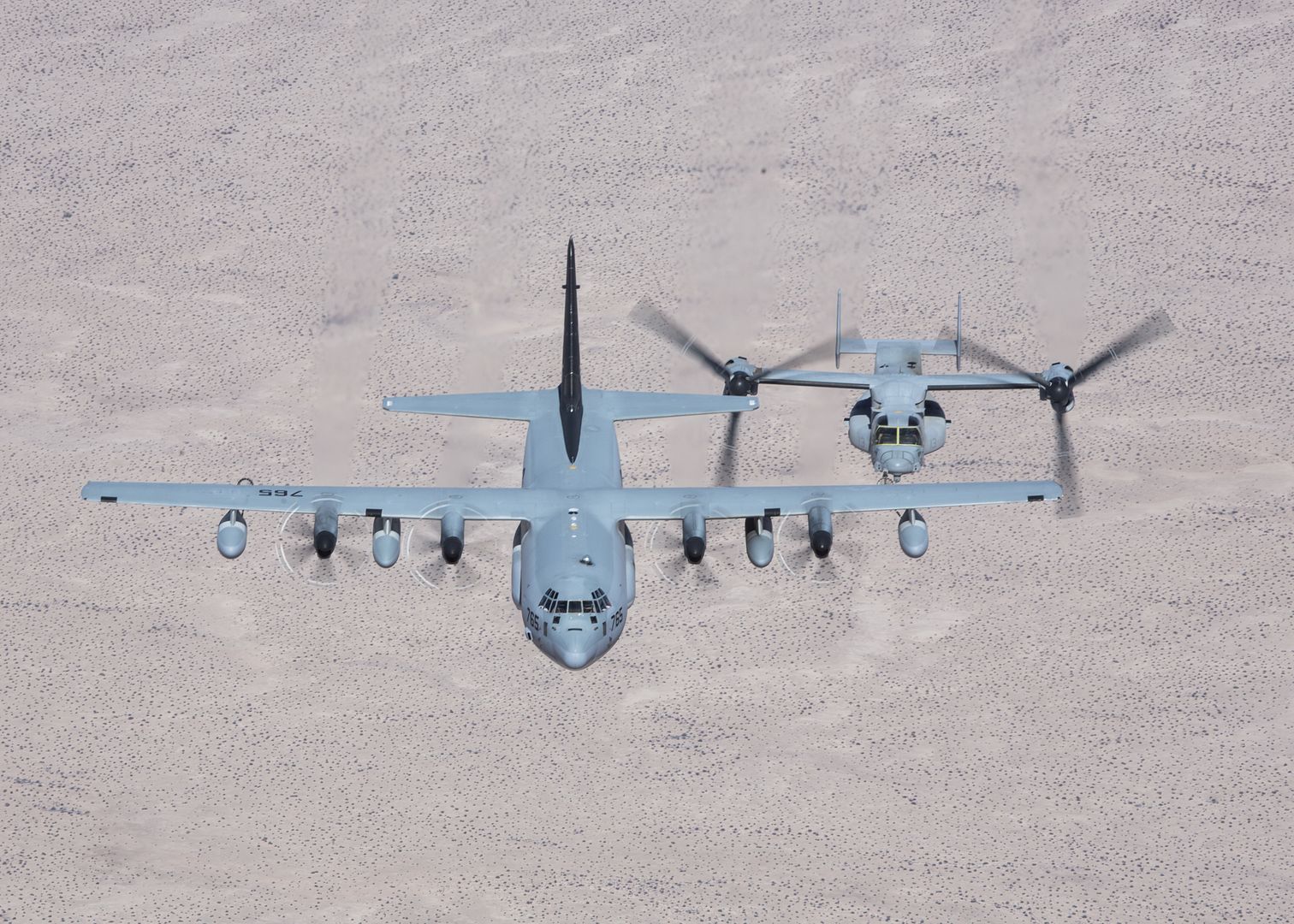
An F-16 Fighting Falcon's from the 53rd Wing at Nellis Air Force Base, Nev., depart the runway at Joint Base Elmendorf-Richardson, Alaska, May 2 during Exercise Northern Edge 2017. Northern Edge is Alaska?s largest and premier joint training exercise designed to practice operations, techniques and procedures as well as enhance interoperability among the services. Thousands of participants from all the services?Airmen, Soldiers, Sailors, Marines and Coast Guard personnel from active duty, Reserve and National Guard units?are involved. (U.S. Air Force photo's/Master Sgt. John Gordinier)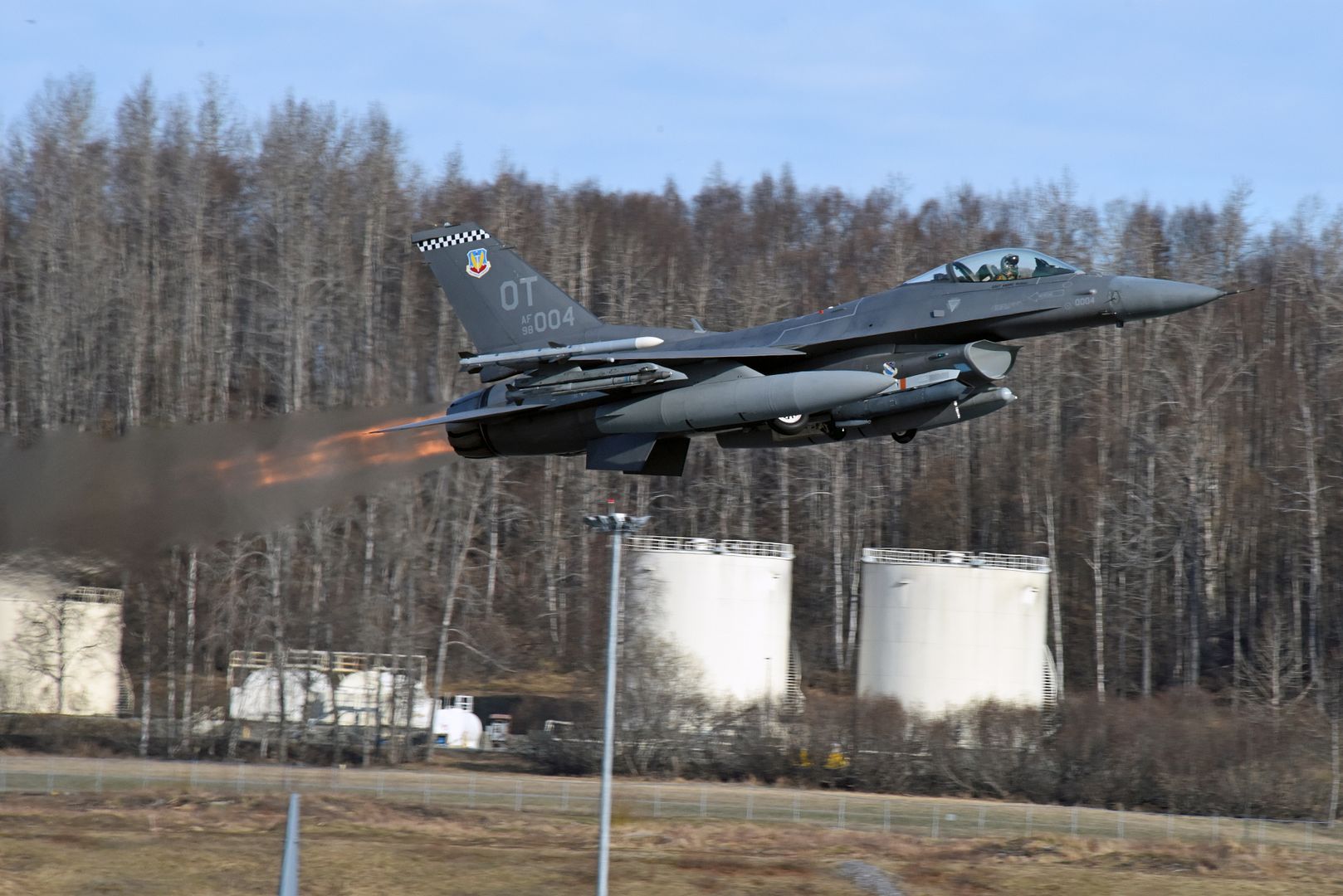
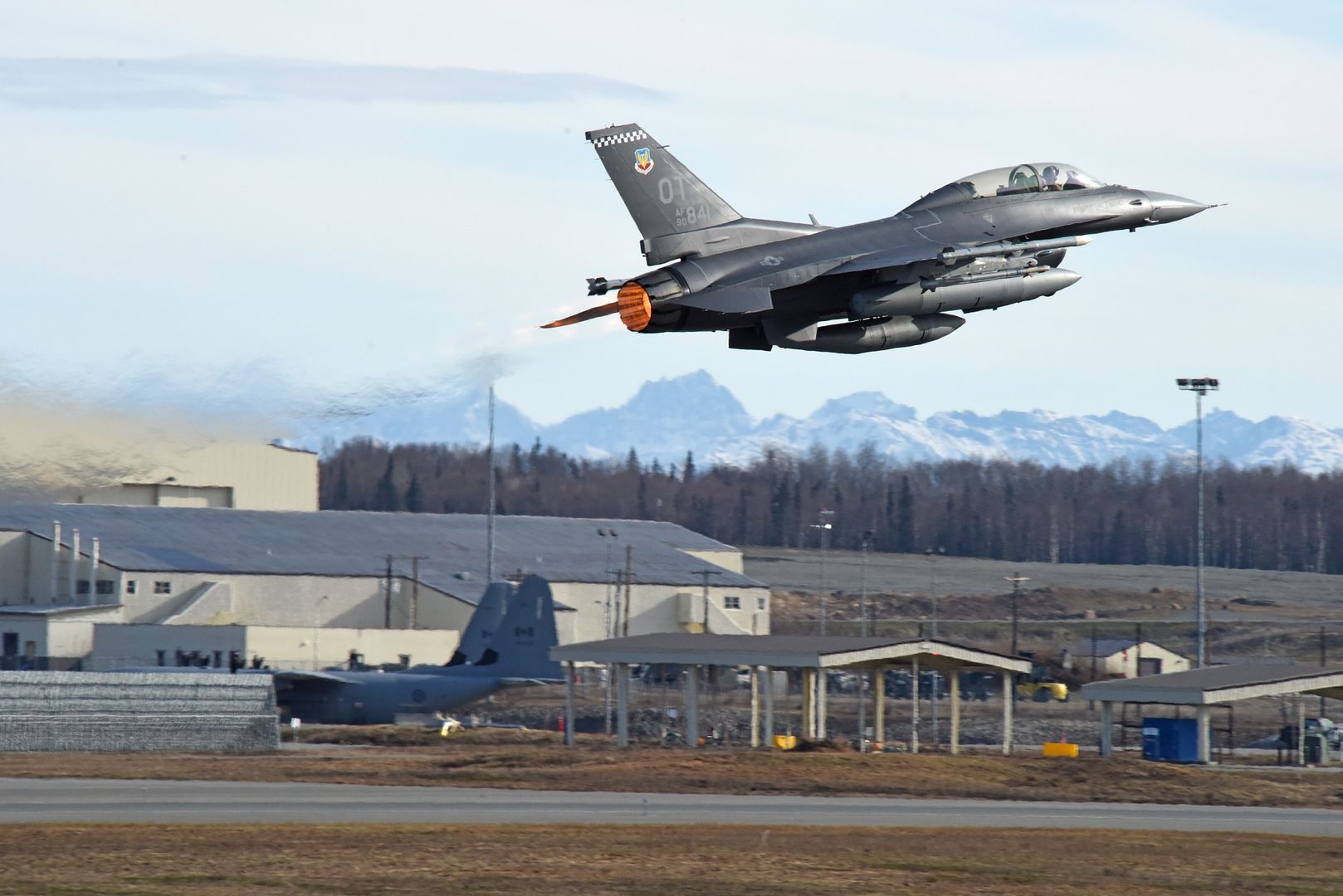
EVERETT, Wash., May 2, 2017 ? Boeing [NYSE: BA] now has six aircraft in its KC-46 tanker test program, expanding its ability to complete ground and flight-test activities as it progresses toward first deliveries to the U.S. Air Force.
The newest KC-46 aerial refueling aircraft, the second low-rate initial production plane, completed its first flight April 29. Its test activities will help ensure the KC-46 can safely operate through electromagnetic fields produced by radars, radio towers and other systems.
?Adding another tanker will help us to become even more efficient and significantly improve our ability to complete test points going forward,? said Jeanette Croppi, Boeing KC-46A tanker test team director. ?We are also re-configuring one of our 767-2C aircraft into a tanker, which means we soon will have four KC-46 tankers in test.?
?This first flight is another important step for the KC-46 program toward verifying the aircraft?s operational capabilities,? said Col. John Newberry, Air Force KC-46 System program manager. "Adding this aircraft brings key capabilities to the test fleet and helps move us closer to delivering operational aircraft to the warfighter."
To date, the program?s test aircraft have completed 1,600 flight hours and more than 1,200 ?contacts? during refueling flights with F-16, F/A-18, AV-8B, C-17, A-10 and KC-10 aircraft.
The KC-46 is derived from Boeing?s commercial 767 airframe. The company expects to build 179 tankers in its Everett factory.
The KC-46A is a multirole tanker that can refuel all allied and coalition military aircraft compatible with international aerial refueling procedures and can carry passengers, cargo and patients.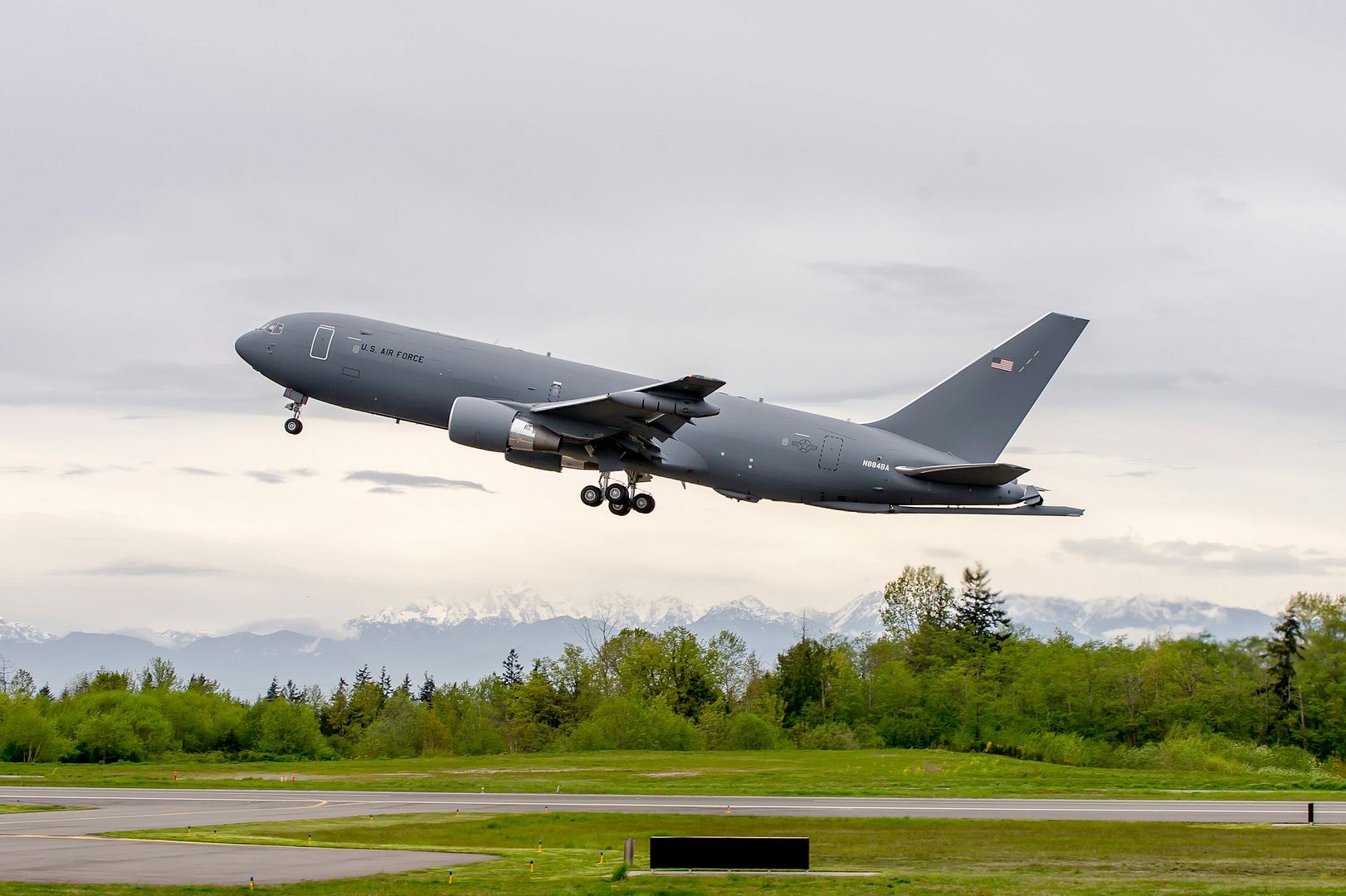
-
 Main AdminJOINT BASE ELEMENDORF-RICHARDSON, Alaska -- Air Force Capt. Jason Shank, a pilot with the 67th Fighter Squadron out of Kadena Airbase, taxis his F-15C Eagle during the morning "Go" May 3 as part of Exercise Northern Edge 17. Exercise NE17 is a joint exercise utilizing Alaska's massive range area and is composed of more than 6,000 service members across all service branches.
Main AdminJOINT BASE ELEMENDORF-RICHARDSON, Alaska -- Air Force Capt. Jason Shank, a pilot with the 67th Fighter Squadron out of Kadena Airbase, taxis his F-15C Eagle during the morning "Go" May 3 as part of Exercise Northern Edge 17. Exercise NE17 is a joint exercise utilizing Alaska's massive range area and is composed of more than 6,000 service members across all service branches.
Photo by Sgt. 1st Class Joel Gibson.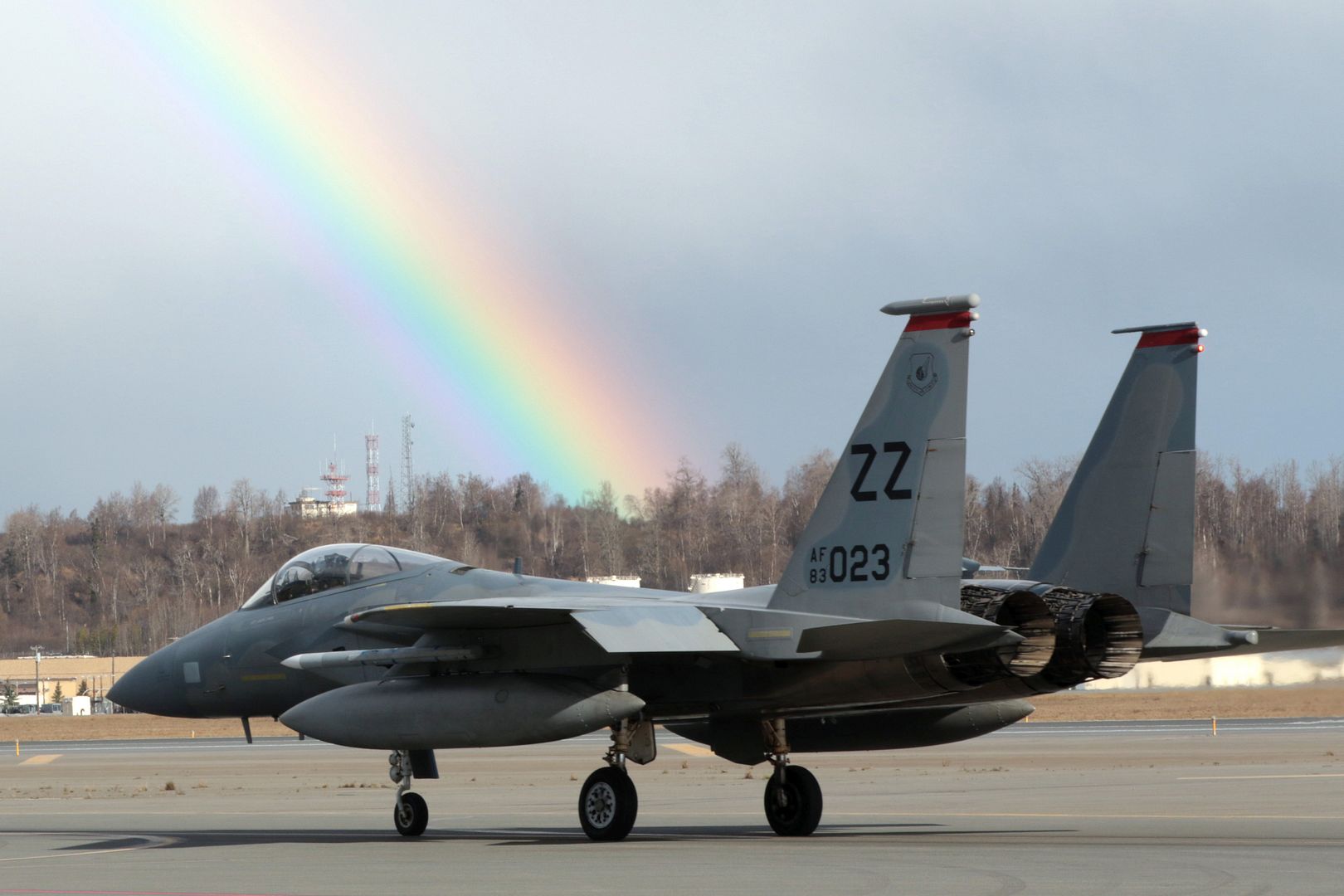
PACIFIC OCEAN (May 2, 2017) ? A F/A-18F Super Hornet assigned to the Mighty Shrikes of Strike Fighter Attack Squadron (VFA) 94 flys over the flight deck of the aircraft carrier USS Theodore Roosevelt (CVN 71). Theodore Roosevelt is currently underway conducting a Group Sail training unit exercise (GRUSL) with the Theodore Roosevelt Carrier Strike Group (TRCSG). GRUSL is the first step in the Theodore Roosevelt integrated training phase and aims to enhance mission-readiness and warfighting capabilities between the ships, airwing and the staffs of the TRCSG through simulated real-world scenarios. (U.S. Navy Photo by Mass Communication Specialist Seaman Nicholas R. Burgains/Released)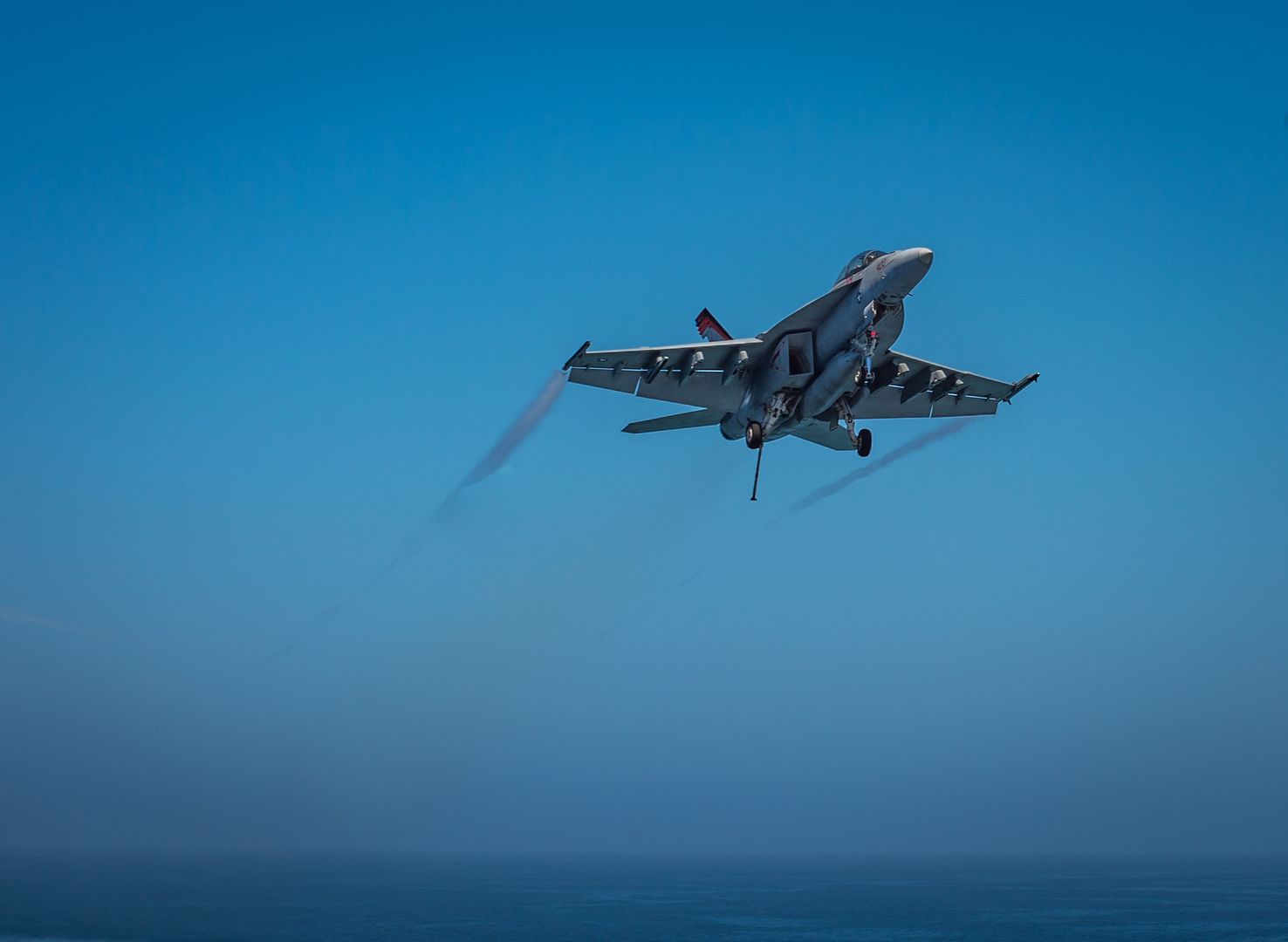
A U.S. Air Force F-16 Fighting Falcon aircraft assigned to the 13th Fighter Squadron, Misawa Air Base, Japan, is cleared out during Exercise Northern Edge 2017, at Eileson Air Force Base, Alaska, May 4, 2017. Northern Edge is Alaska?s largest and premier joint training exercise designed to practice operations, techniques and procedures as well as enhance interoperability among the services. Thousands of participants from all the services?Airmen, Soldiers, Sailors, Marines and Coast Guard personnel from active duty, Reserve and National Guard units?are involved. (U.S. Marine Corps photo/ Sgt. Laura Gauna)
BOSSIER CITY, La - (May 3, 2017) Navy Flight Demonstration Team, the ?Blue Angels,? #7 Pilot Lt. Brandon Hempler and Bossier City Sheriff?s Detective Mike Lombardino prepare for take off before the detective?s backseat ride Wed., May 3, at Barksdale Air Force Base. Lombardino was among a handful of ?key influencers? selected for the rare honor prior to the 2017 Defenders of Liberty Air Show scheduled May 5-7. The Blue Angels will serve as the lead performers for an anticipated 120,000 spectators. The Blue Angels are dedicated to representing the Navy and Marine Corps? pride and professionalism, and to inspire a culture of excellence and service to country. (U.S. Navy photo by Mass Communication Specialist 1st Class Chris Fahey/RELEASED).
A U.S. Marine Corps F/A-18C Hornet flies through the skies above Joint Base Elmendorf-Richardson, Alaska, May 3, 2017. Northern Edge is Alaska?s largest and premier joint training exercise designed to practice operations, techniques and procedures, as well as enhance interoperability among the services. The exercise provides real-world proficiency in detection and tracking of units at sea, in the air and on land and response to multiple crises in the Indo-Asia-Pacific region. The F/A-18C is part of Marine Fighter Attack Squadron 232, Marine Aircraft Group 11, 3rd Marine Aircraft Wing. VMFA-232 is currently on a six-month rotation as part of the Unit Deployment Program with MAG-12, Marine Corps Air Station Iwakuni, Japan. (U.S. Marine Corps photo by Lance Cpl. Andy Martinez)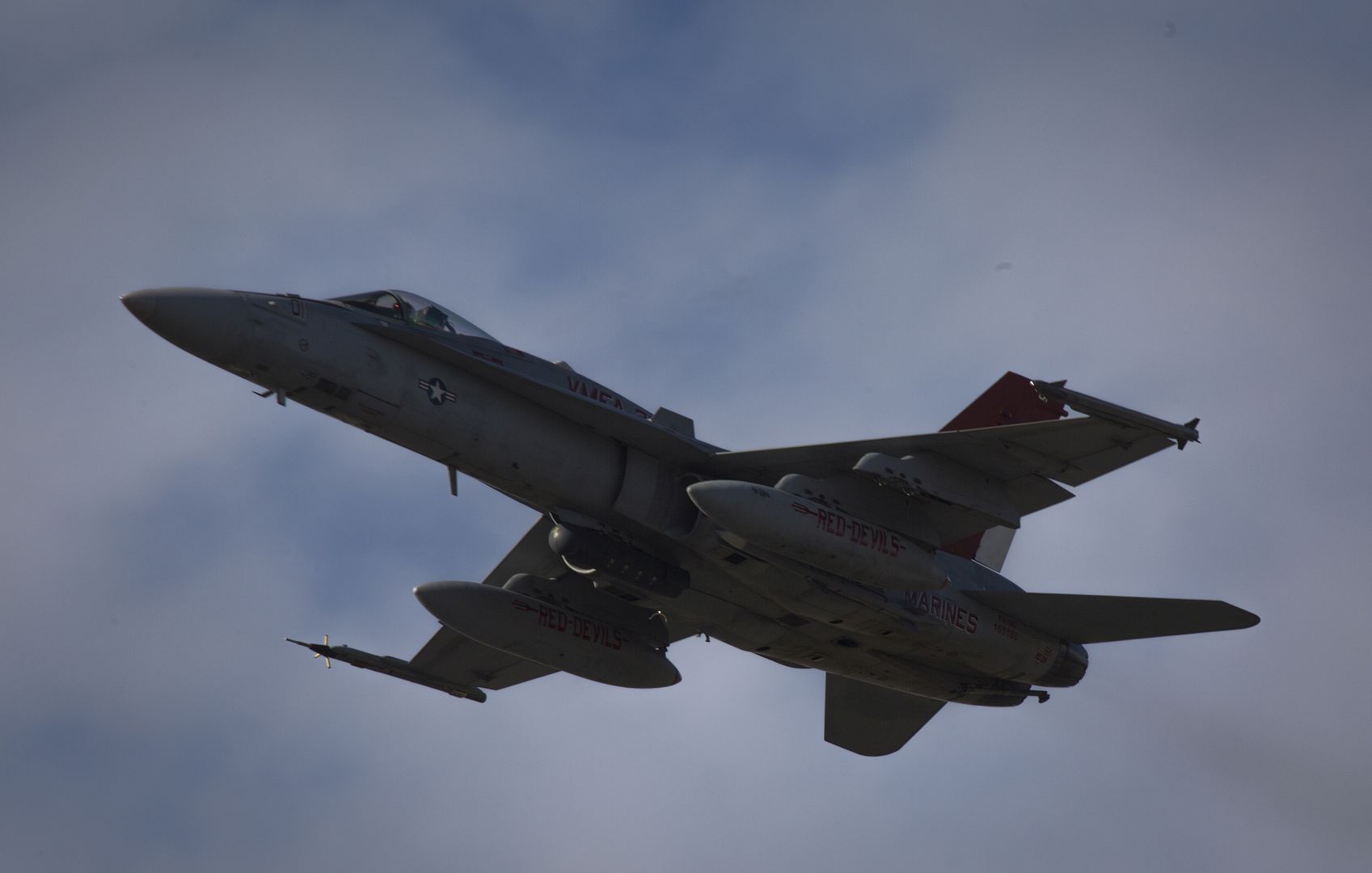
A U.S. Marine Corps F-35B Lightning II aircraft taxies onto the runway on Joint Base Elmendorf-Richardson, Alaska, May 3, 2017. Northern Edge is Alaska?s largest and premier joint training exercise designed to practice operations, techniques and procedures as well as enhance interoperability among the services. The exercise provides real-world proficiency in detection and tracking of units at sea, in the air and on land and response to multiple crises in the Indo-Asia-Pacific region. The F-35B is stationed out of Marine Corps Air Station Iwakuni, Japan with Marine Fighter Attack Squadron 121, Marine Aircraft Group 12, 1st Marine Aircraft Wing, III Marine Expeditionary Force. (U.S. Marine Corps photo by Lance Cpl. Andy Martinez)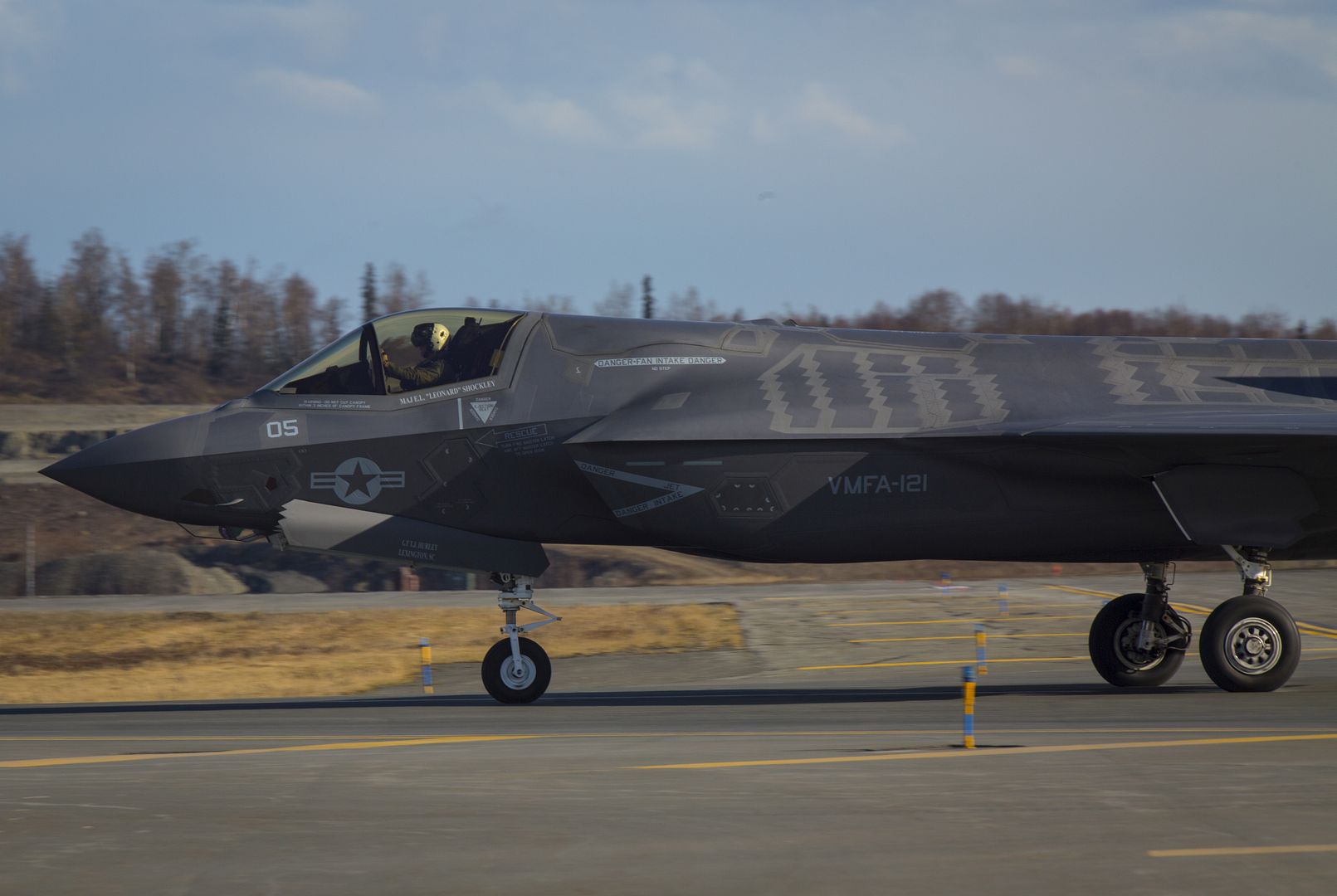
A U-2 Dragon Lady from Beale Air Force Base, Calif., departs the runway at Joint Base Elmendorf-Richardson, Alaska, May 3, 2017, in support of Exercise Northern Edge 2017. Northern Edge is Alaska?s largest and premier joint training exercise designed to practice operations, techniques and procedures, as well as enhance interoperability among the services. Thousands of participants from all the services, Airmen, Soldiers, Sailors, Marines and Coast Guard personnel from active duty, Reserve and National Guard units?are involved. (U.S. Air Force photo/Master Sgt. John Gordinier)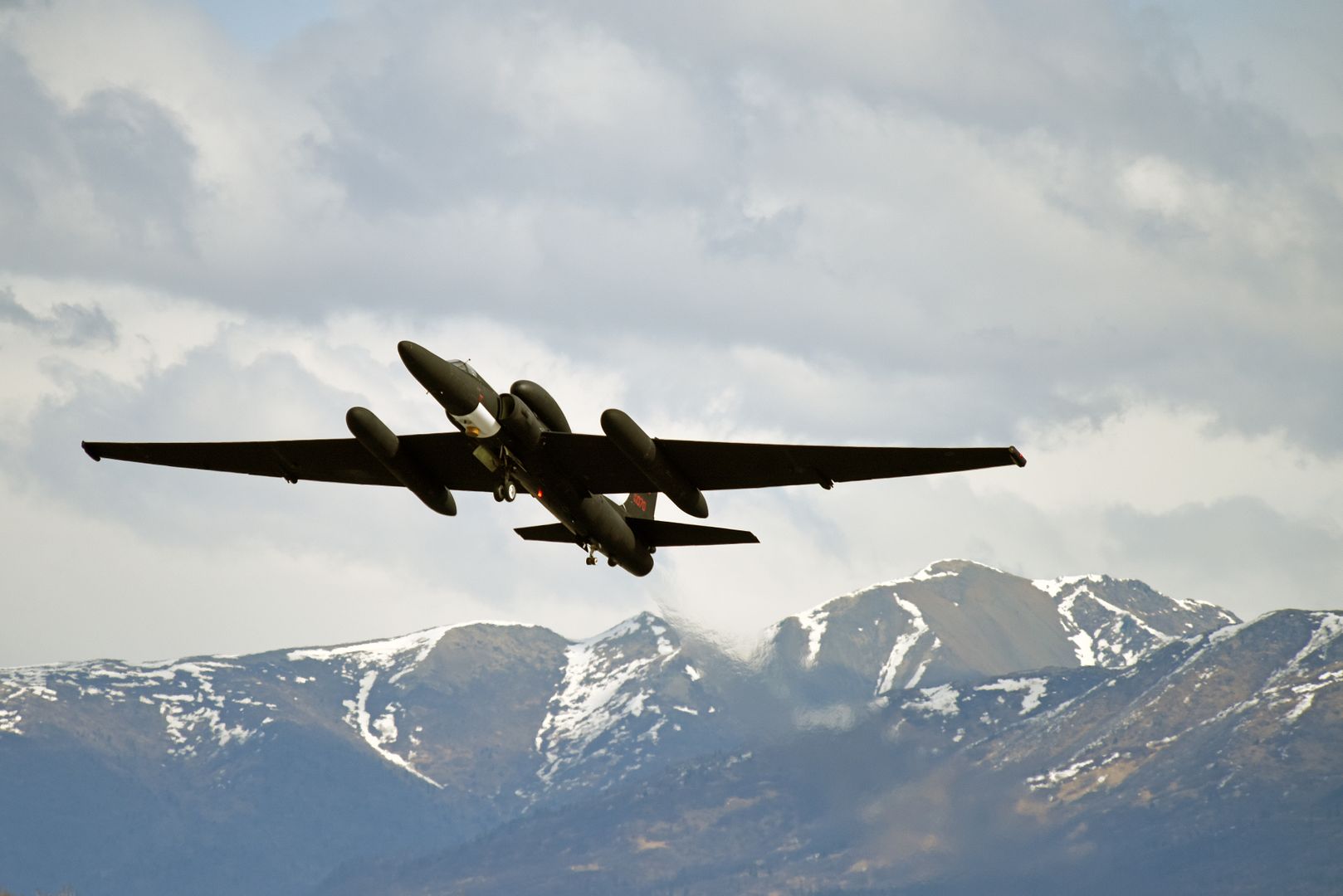
PACIFIC OCEAN (May 2, 2017) An F/A-18E Super Hornet from the ?Golden Dragons? of Strike Fighter Squadron (VFA) 192 takes off from the Nimitz-class aircraft carrier USS Carl Vinson (CVN 70) during flight operations in the western Pacific Ocean. The U.S. Navy has patrolled the Indo-Asia-Pacific routinely for more than 70 years promoting regional peace and security. (U.S. Navy photo by Mass Communication Specialist 3rd Class Matthew Granito/Released)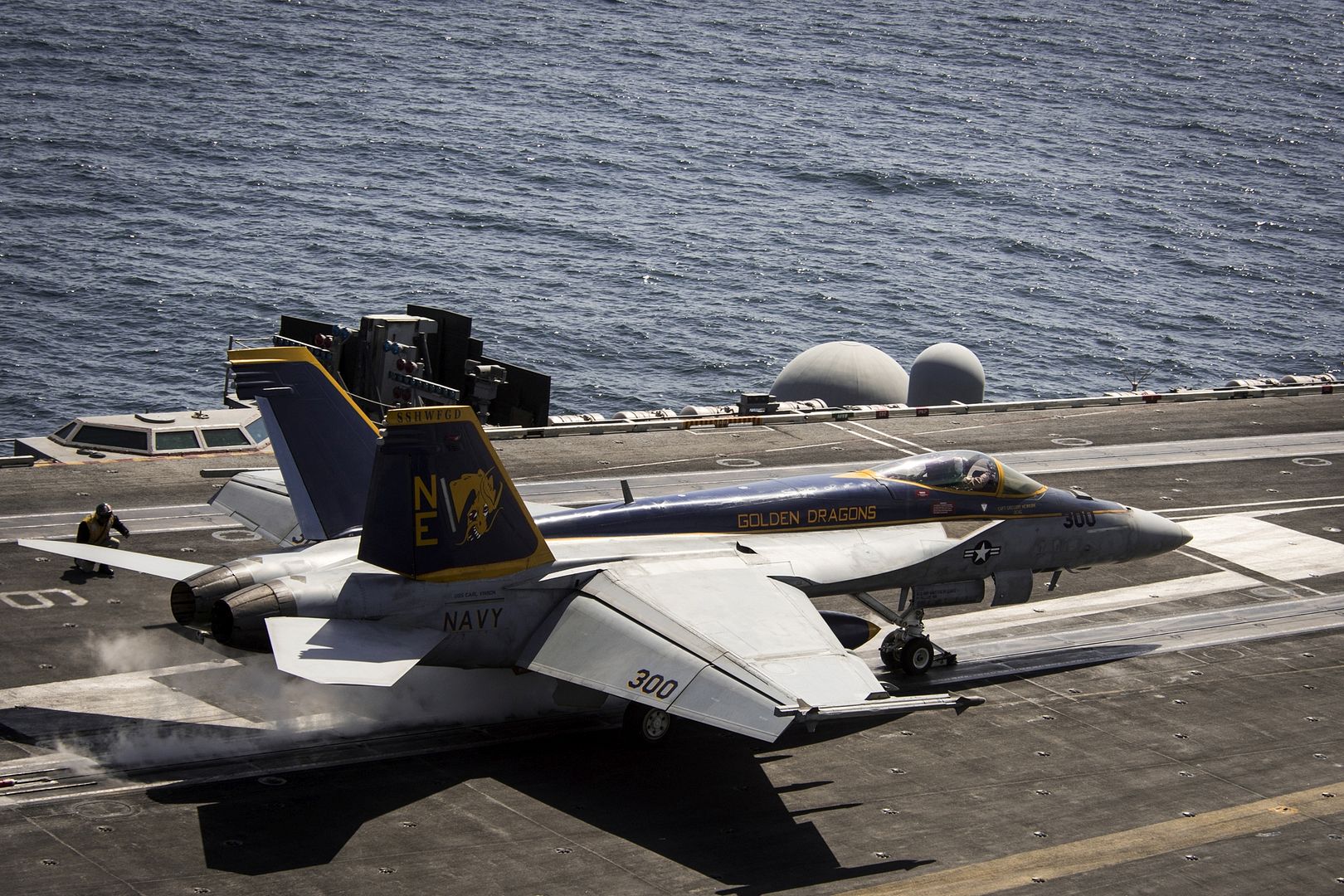
Poland took the lead of NATO?s Baltic Air Policing mission on Tuesday (2 May 2017), succeeding the Royal Netherlands Air Force at ?iauliai airbase in Lithuania. Spain will replace the German Air Force in supporting the mission from Estonia?s ?mari airbase.
The Polish Air Force will carry out the mission with four F-16 fighter aircraft, while the Spanish Air Force is deploying five F-18 fighter jets. Poland has now led the mission six times, while Spain is also a regular contributor.
Since 2004, seventeen Allies have participated in 44 rotations of NATO?s Baltic Air Policing. The mission is a standing peacetime activity, helping ensure the integrity of the airspace over Estonia, Latvia and Lithuania. The next scheduled rotation is foreseen for September.
(Source: North Atlantic Treaty Organization; issued May 02, 2017)
-
7 years agoSat May 06 2017, 04:06pm
 Main AdminU.S. Marines from Marine Fighter Attack Squadron 121 perform preflight operational checks on a U.S. Marine Corps F-35B Lightning II aircraft at Joint Base Elmendorf-Richardson, Alaska, May 4, 2017. Northern Edge, Alaska?s largest and premier joint training exercise, is designed to enhance interoperability among the services and ensure service members are ready for deployment. The exercise provides real-world proficiency in detection and tracking of units at sea, in the air and on land and response to multiple crises in the Indo-Asia-Pacific region. The Marines are with VMFA-121, Marine Aircraft Group 12, 1st Marine Aircraft Wing, III Marine Expeditionary Force. (U.S. Marine Corps photo by Lance Cpl. Andy Martinez)
Main AdminU.S. Marines from Marine Fighter Attack Squadron 121 perform preflight operational checks on a U.S. Marine Corps F-35B Lightning II aircraft at Joint Base Elmendorf-Richardson, Alaska, May 4, 2017. Northern Edge, Alaska?s largest and premier joint training exercise, is designed to enhance interoperability among the services and ensure service members are ready for deployment. The exercise provides real-world proficiency in detection and tracking of units at sea, in the air and on land and response to multiple crises in the Indo-Asia-Pacific region. The Marines are with VMFA-121, Marine Aircraft Group 12, 1st Marine Aircraft Wing, III Marine Expeditionary Force. (U.S. Marine Corps photo by Lance Cpl. Andy Martinez)
FORT IRWIN, Calif. ? A UH-72 Lakota Helicopter provides combat air support to Troopers from Assassin Troop, 1st Squadron, 11th Armored Cavalry Regiment, during their assault on an objective held by elements of the 2nd Armored Brigade Combat Team, 1st Infantry Division, near the village of Nur in the National Training Center, May 4, 2017. The purpose of this phase of NTC Rotation 17-06 challenged the Dagger Brigade?s competence in defending an objective against a hybrid-force consisting of conventional and non-conventional forces. (U.S. Army photo by Pfc. Austin Anyzeski, 11th ACR)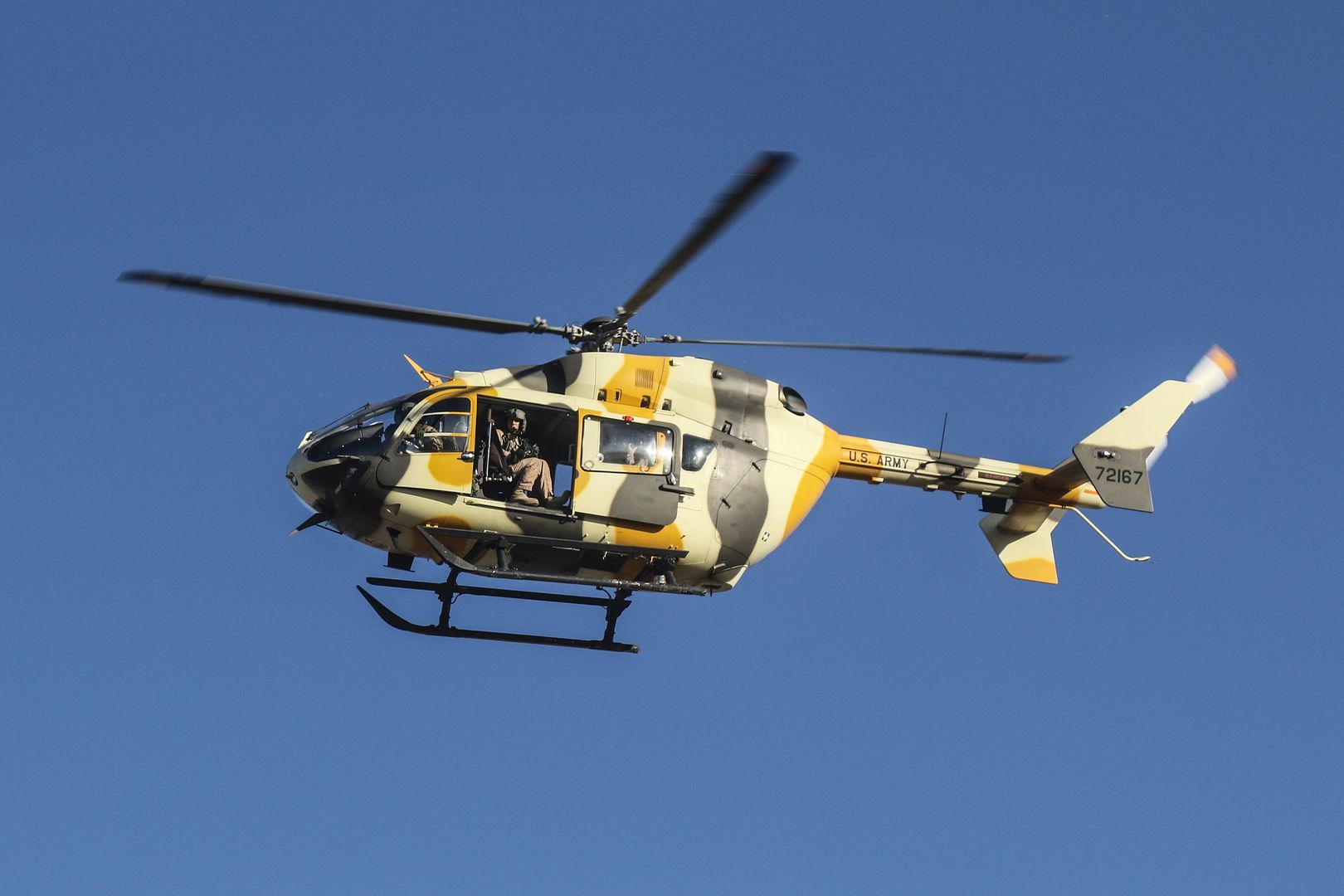
The United States Air Force Thunderbirds arrive at Travis Air Force Base, Calif., May 4, 2017. The Thunderbirds will perform aerial demonstrations during the two day ?Wings over Solano Air Show?, May 6-7. (U.S. Air Force photo by Heide Couch)
An F-15 Eagle from Eglin Air Force Base, Fla. takes off at Joint Base Elmendorf-Richardson, Alaska, during exercise Northern Edge 17, May 3, 2017. Northern Edge is Alaska?s premier joint training exercise designed to practice operations, techniques and procedures as well as enhance interoperability among the services. Thousands of participants from all the services ? Airmen, Soldiers, Sailors, Marines and Coast Guardsmen from active duty, Reserve and National Guard units ? are involved. (U.S. Air Force photo by Airman 1st Class Javier Alvarez)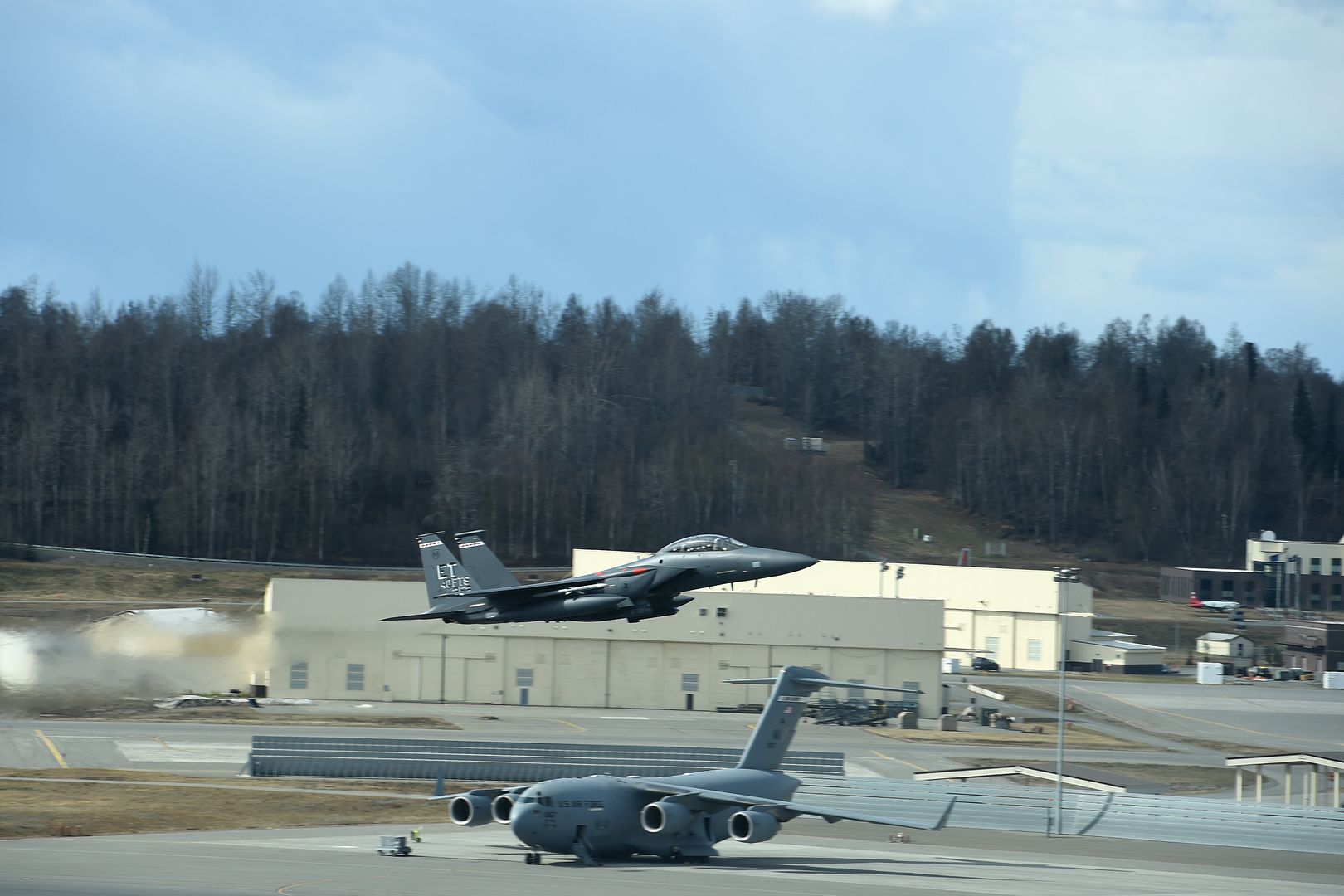
A U.S. Marine Corps Growler aircraft taxi after landing at the flightline at Joint Base Elmendorf-Richardson, Alaska, during exercise Northern Edge 17, May 3, 2017. Northern Edge is Alaska?s premier joint training exercise designed to practice operations, techniques and procedures as well as enhance interoperability among the services. Thousands of participants from all the services ? Airmen, Soldiers, Sailors, Marines and Coast Guardsmen from active duty, Reserve and National Guard units ? are involved. (U.S. Air Force photo by Airman 1st Class Javier Alvarez)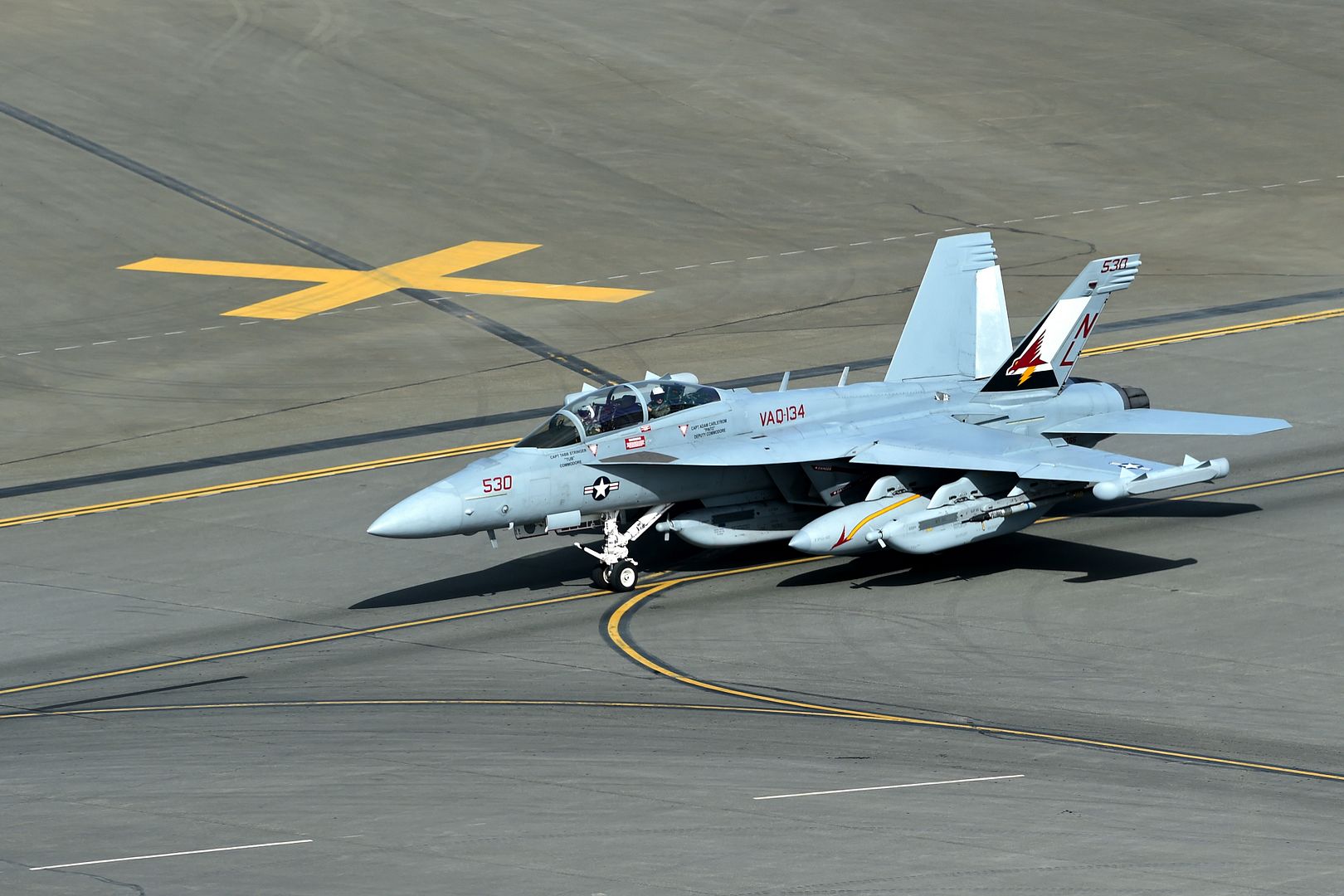
U.S. Marine Corps CH-53E Sea Stallion with Marine Heavy Helicopter (HMH) Squadron 361, Marine Aircraft Group 16, 3d Marine Aircraft Wing, carries a Bambi Bucket during flight on Marine Corps Base Camp Pendleton, San Diego, Calif., May 4, 2017. This exercise was conducted to simulate immediate response action drills according to established procedures during a fire event. (U.S. Marine Corps photo by Lance Cpl. Ariana Acosta/Released)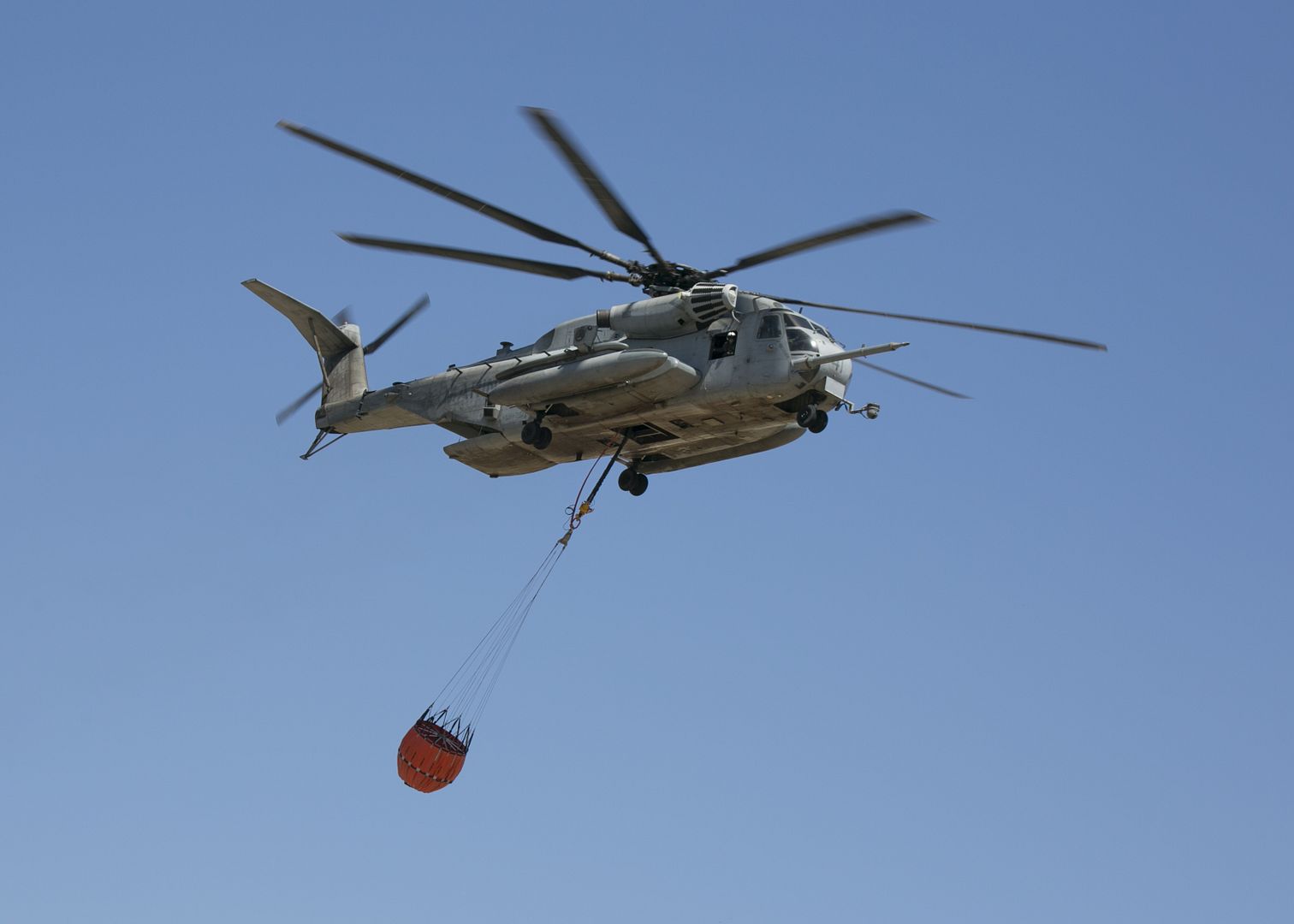
An F-22A Raptor with the 27th Expeditionary Fighter Squadron rests on the flight line after flying in support of Combined Joint Task Force- Operation Inherent Resolve at an undisclosed location in Southwest Asia, May 3, 2017. The 27 EFS, currently deployed with the 380th Air Expeditionary Wing, will celebrate its centennial May 8, 2017. This squadron is one of the oldest and most famous fighter squadrons in American history and carries on its long legacy of airpower in the fight against ISIS. (U.S. Air Force photo by Staff Sgt. Marjorie A. Bowlden)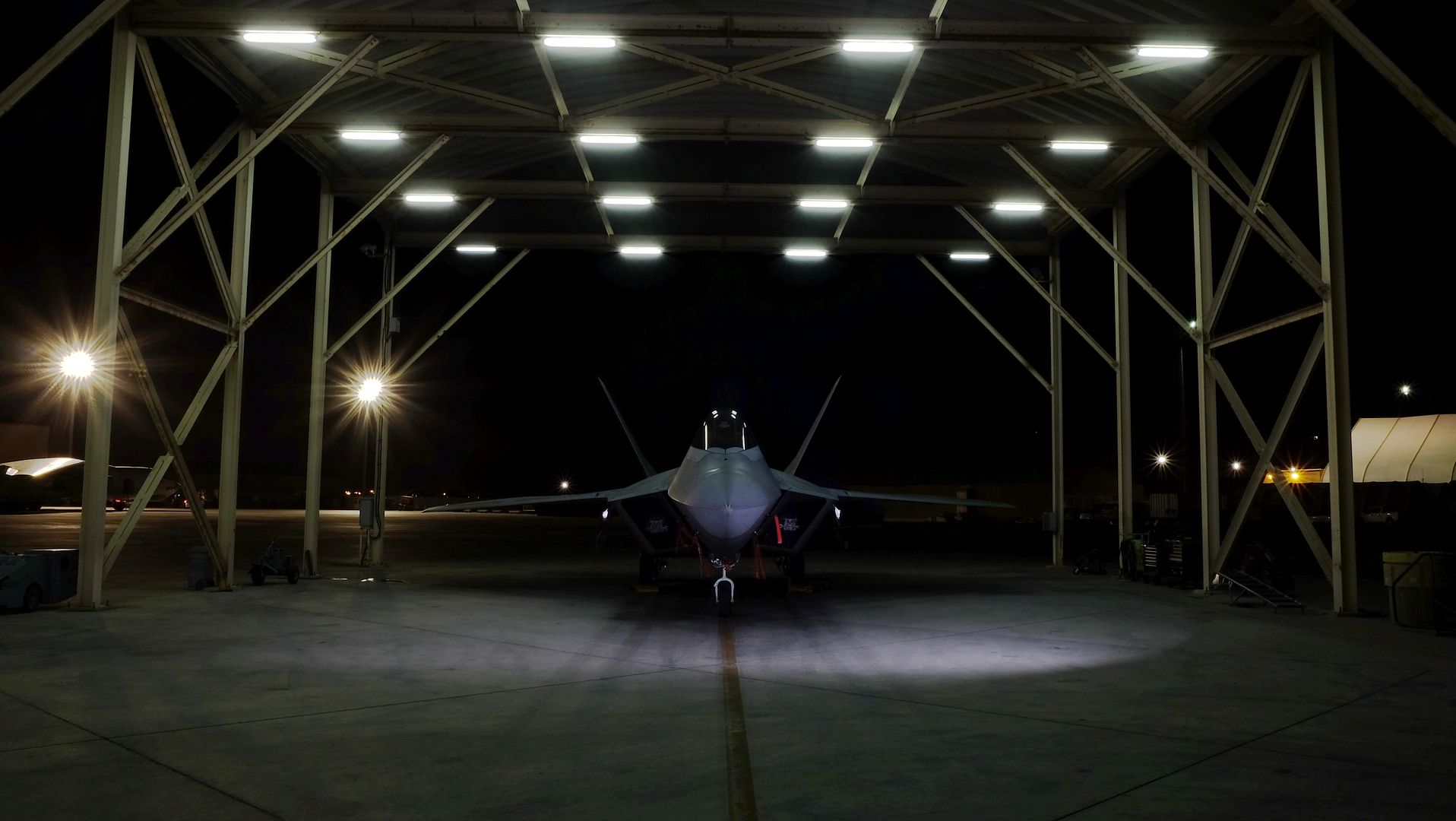
EDWARDS AIR FORCE BASE, Calif. --
F-22 Raptors from the 411th Flight Test Squadron completed developmental tests of air-to-air missiles against an aerial target April 18 at the Utah Test and Training Range as part of a major capability upgrade.
The Raptors launched inert AIM-9 and AIM-120 missiles against multiple BQM-167A sub-scale aerial targets, marking a significant effort along the 3.2B developmental test and evaluation upgrade timeline.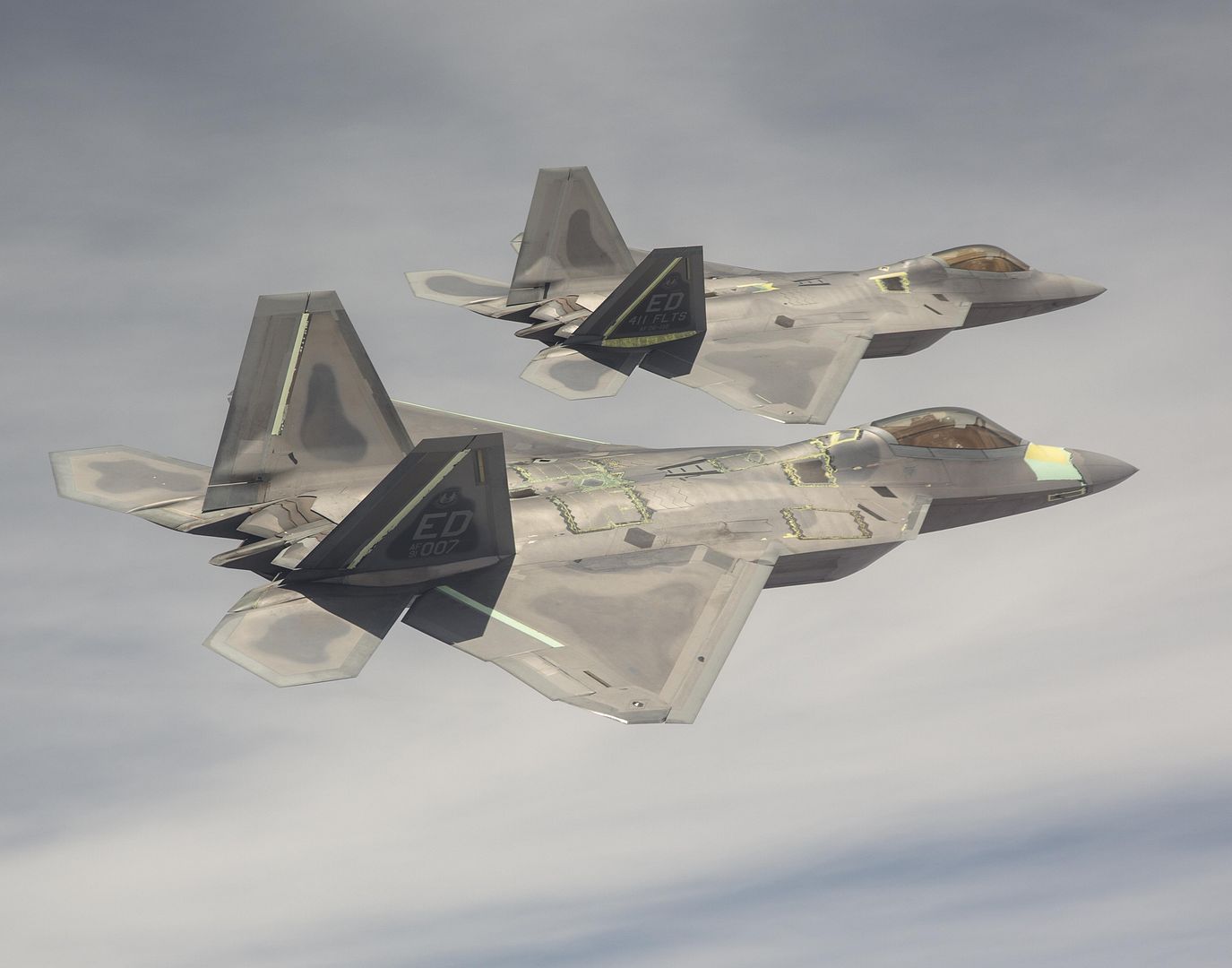
?The shots at UTRR were the graduation live fire event of a two-year long 3.2B upgrade,? said Lt. Col. Randel Gordon, 411th FLTS commander. ?The achievement of those shots is a huge technical accomplishment for the 412th Test Wing and 411th FLTS.?
The 3.2B modernization update to the F-22 is the fighter jet?s biggest capability upgrade since reaching Initial Operating Capability in December 2005, according to the testers. Once fielded, it will add capability boosts to U.S. Air Force air superiority and further support coalition efforts overseas.
Gordon praised the coordination with the 82nd Aerial Targets Squadron, which deployed from the 53rd Weapons Evaluation Group at Tyndall Air Force Base, Florida to provide the flying targets in the missile tests.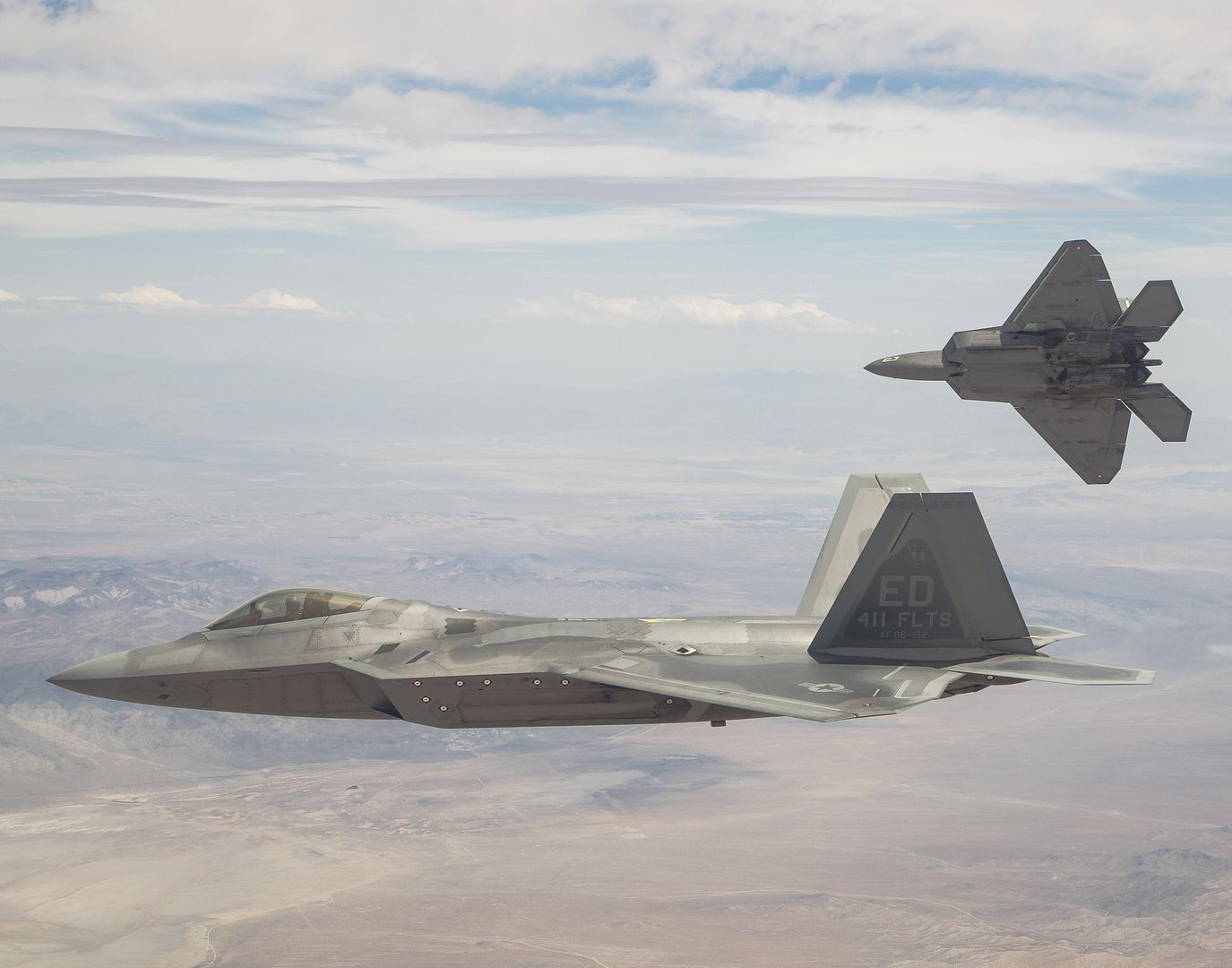
The BQM-167A is a high-performance, remotely-controlled subscale aerial target used to provide a threat-representative target drone to support the Air-to-Air Weapon System Evaluation Program and other Air Force and Department of Defense air-to-air test and evaluation programs.
"We deployed a group of 15 active duty members, government civilians and contractors to launch, fly and recover up to eight BQM-167A targets over three days,? said Lt. Col. Matthew Garrison, 82nd ATRS commander. "Because we are the only Air Force unit with the aerial target mission, we take our responsibility for developmental and operational flight testers very seriously, including deployments to meet them on their local ranges.?
Gordon added that live-fire missile shot events at the 411th FLTS are named after 1980s? movie action stars as an informal way to keep track of the test milestones. Because of the importance of this past test, the event was named after ?the biggest action star of the 80s.?
?We saved the best for last. This was the Chuck Norris shot,? said Gordon. ?It was really a technically challenging shot and a graduation shot following two years of hard work. I?m deeply proud of those people in my squadron who made this happen.?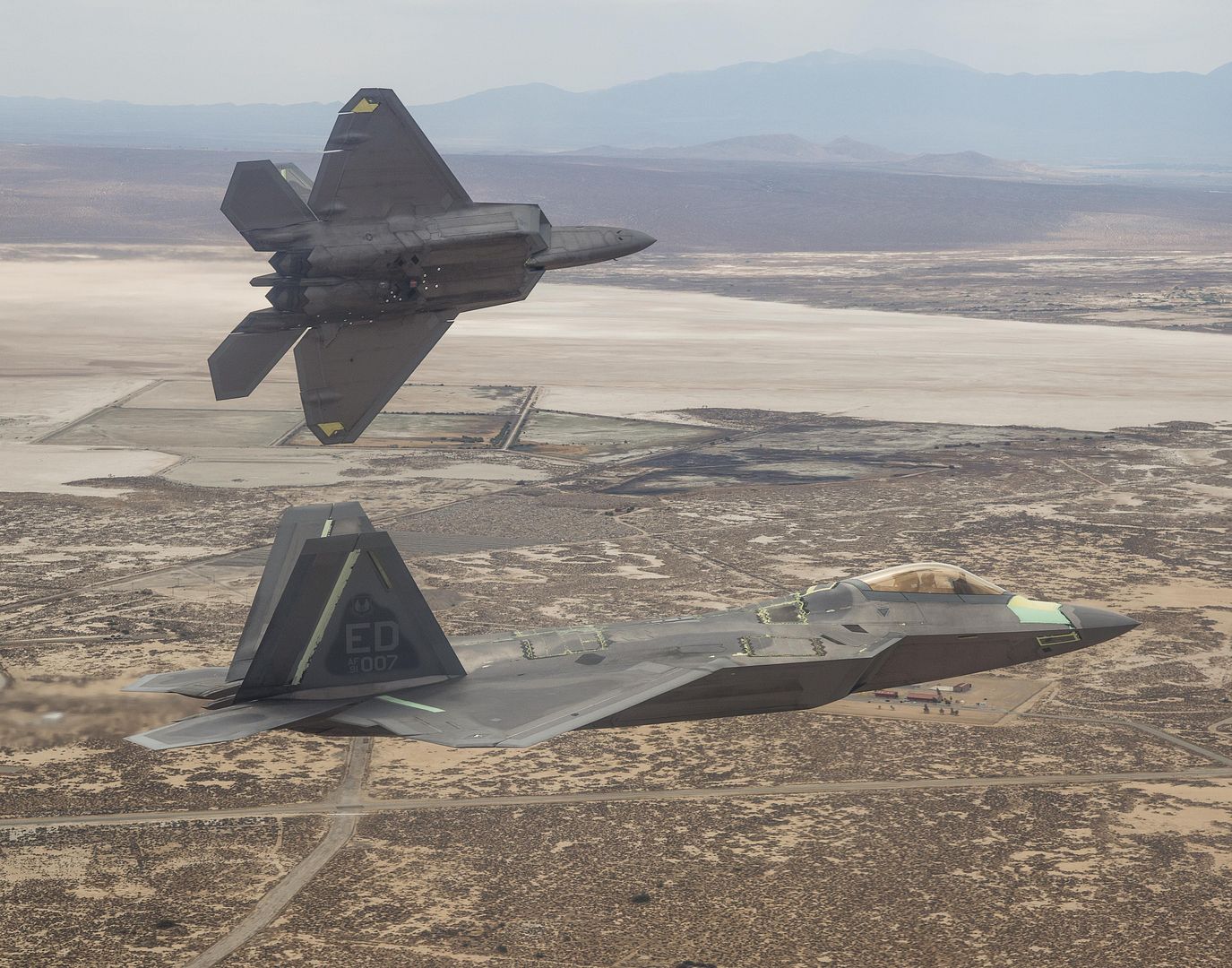
PACIFIC OCEAN (May 3, 2017)
An F/A-18E Super Hornet from the "Kestrels" of Strike Fighter Squadron (VFA) 137 lands on the flight deck of the Nimitz-class aircraft carrier USS Carl Vinson (CVN 70) as the Ticonderoga-class guided-missile cruiser USS Lake Champlain (CG 57), left, and the Arleigh Burke-class guided-missile destroyer USS Wayne E. Meyer (DDG 108) transit the western Pacific Ocean. The U.S. Navy has patrolled the Indo-Asia-Pacific routinely for more than 70 years promoting regional peace and security. U.S. Navy photo by Mass Communication Specialist 2nd Class Z.A. Landers (Released)
5 May 2017 Press Release
Cardiff ? Airbus? A350-1000 test aircraft MSN071 has completed fuel system and engine tests in Cardiff, Wales between 3 and 4 May as part of its type certification flight test campaign.
Fuel test engineers from Airbus? site at Filton, Bristol, were on hand to support testing of the fuel systems that were designed in the UK. The objective of the test is to simulate operational conditions in hot countries and check how global fuel management system and engines behave with hot fuel (over 43?C).
The early results demonstrate that the fuel management system efficiently handles various fuel densities and temperatures, as well as fuel flow to engines and between tanks while airborne offering the best operational performance. The A350-1000 is ready for hot conditions operations from Entry Into Service later this year.
The A350-1000, just as the -900, has a simplified fuel system with only three tanks and fewer pumps and valves. This contributes to a 25% advantage in operating costs and is another example of the high level of commonality within the A350 XWB family.
Fuel systems tests are part of standard tests for all new aircraft and major modifications such as new engines. The aircraft was fuelled twice a day and then the flight test team performed a number of required engine and systems flight tests with hot fuel.
The site at Filton, Bristol is Airbus?s worldwide centre of expertise for fuel systems design and testing, which is why these fuel tests for the A350-1000 - as for all Airbus aircraft such as A320neo, A380, A350-900, and A400M - have been carried out in the UK.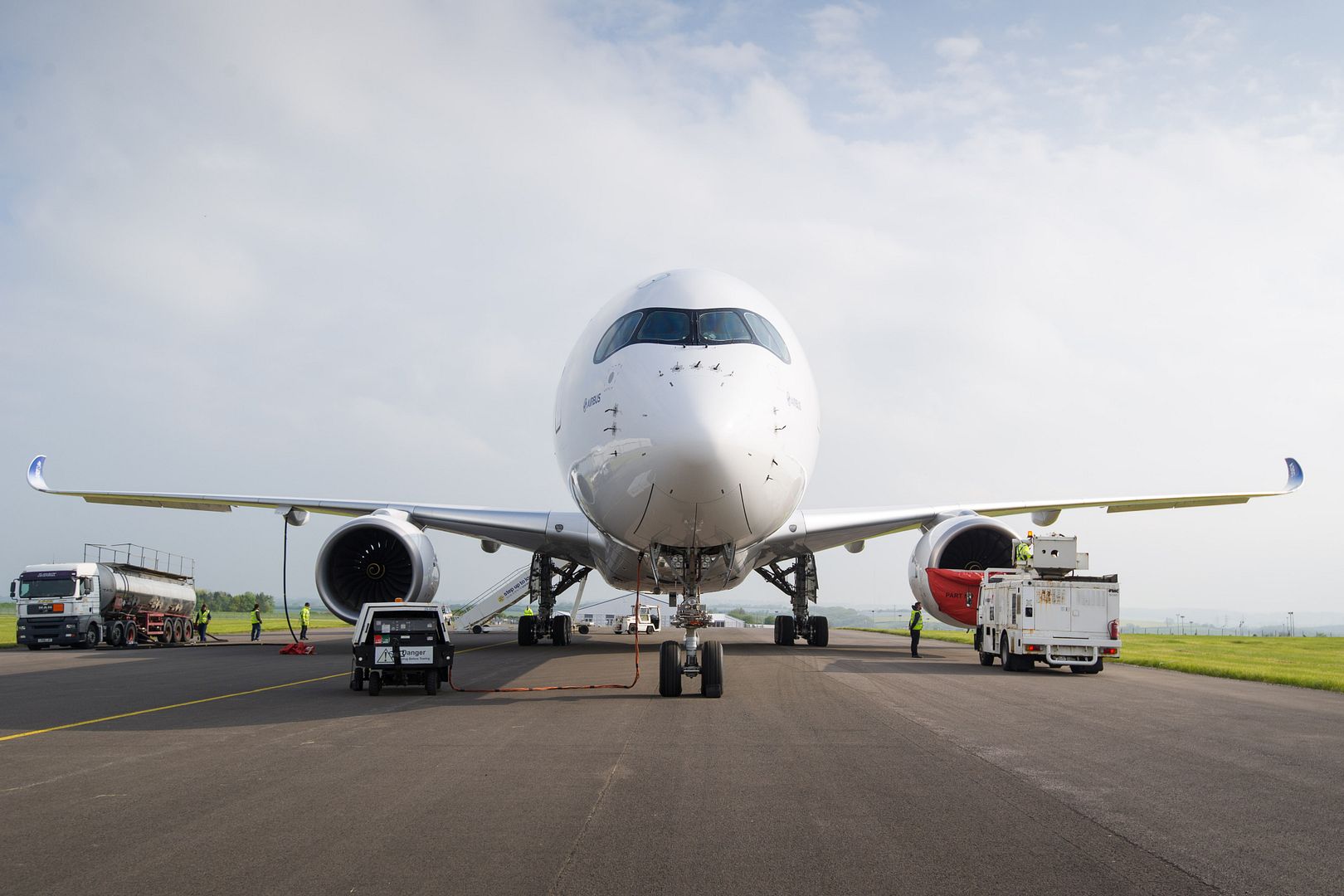
The A350-1000 is the latest member of the Airbus leading widebody family, together with the A330neo, offering unprecedented levels of operating efficiency, low noise and true long-range capability. As well as having a longer fuselage to accommodate 40 more passengers than the A350-900, the A350-1000 also features a modified wing trailing-edge, new six-wheel main landing gears and more powerful Rolls-Royce Trent XWB-97 engines. The A350-1000 embodies all of the fuel efficiency and ?Airspace? cabin comfort of the original A350-900 ? but with extra size perfectly tailored for our customers on some of their busiest long-haul routes. To date 12 customers from five continents have placed orders for a total of 211 A350-1000s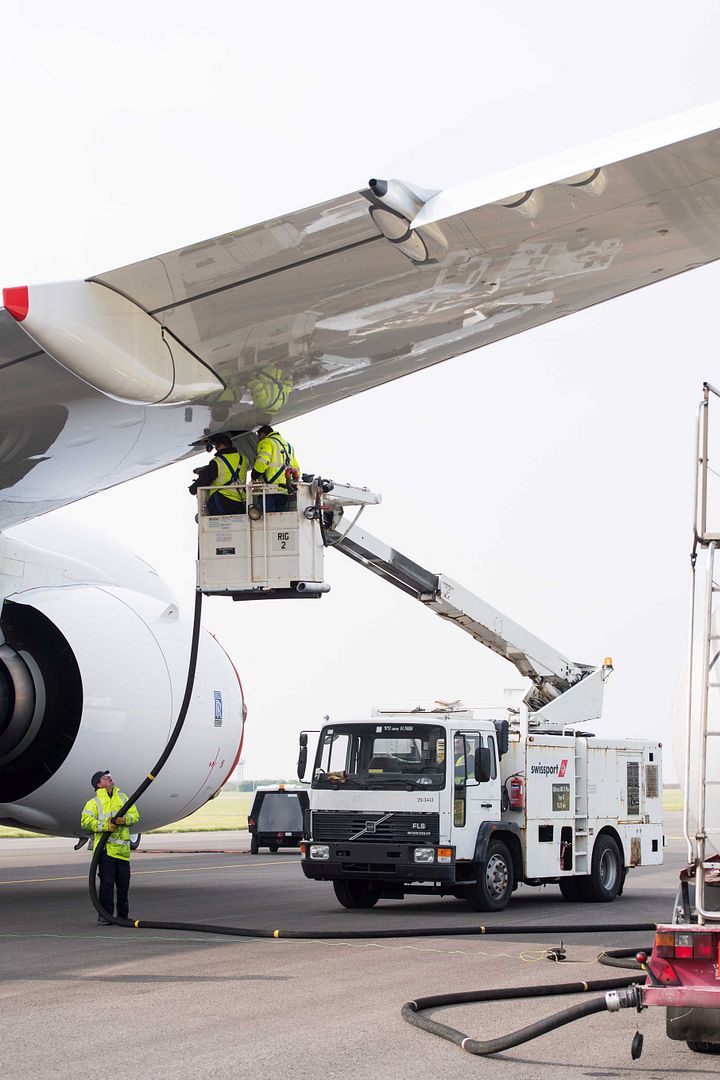
Melbourne, Florida, USA, May 4, 2017 - Embraer delivered today its 1,100th business jet. The milestone aircraft is the industry?s best-selling Phenom 300, and the customer is NetJets, the world?s largest private aviation company, with a portfolio of services that includes fractional ownership, jet cards, aircraft management and charter.
?Embraer scored the four-digit mark in business jet deliveries in an impressively short period of time. NetJets has been integral to our success story by co-creating a premium product to meet the discerning tastes of their distinguished Owners,? said Michael Amalfitano, President & CEO of Embraer Executive Jets. ?We are committed to delivering the most value to our customers, with superior products that offer a unique combination of comfort, performance and operating costs, coupled with an unmatched experience throughout their journey, including the best customer support in the industry.?
With over 670 customers flying 1,100 aircraft in more than 70 countries, Embraer?s business aviation division has accumulated a compound annual growth rate (CAGR) of 19% since 2002, when the first executive jet model was delivered. In 2016, Embraer?s market share represented 18% of the industry?s global deliveries.
?The Phenom is one of the most outstanding light cabin jets in the industry. It meets our Owners? and our own high standards for performance and safety, and offers custom enhancements for well-appointed travel,? said Adam Johnson, Chairman and CEO, NetJets. ?We are proud to have Phenoms in our fleet, and we?re excited to celebrate this milestone delivery with our industry partner.?
Embraer?s broad product portfolio is uniquely positioned in terms of the overall value proposition, combining comfort, technology, performance, economics and reliability. Its fleet is supported by the top-ranked service solutions, as confirmed by independent market surveys.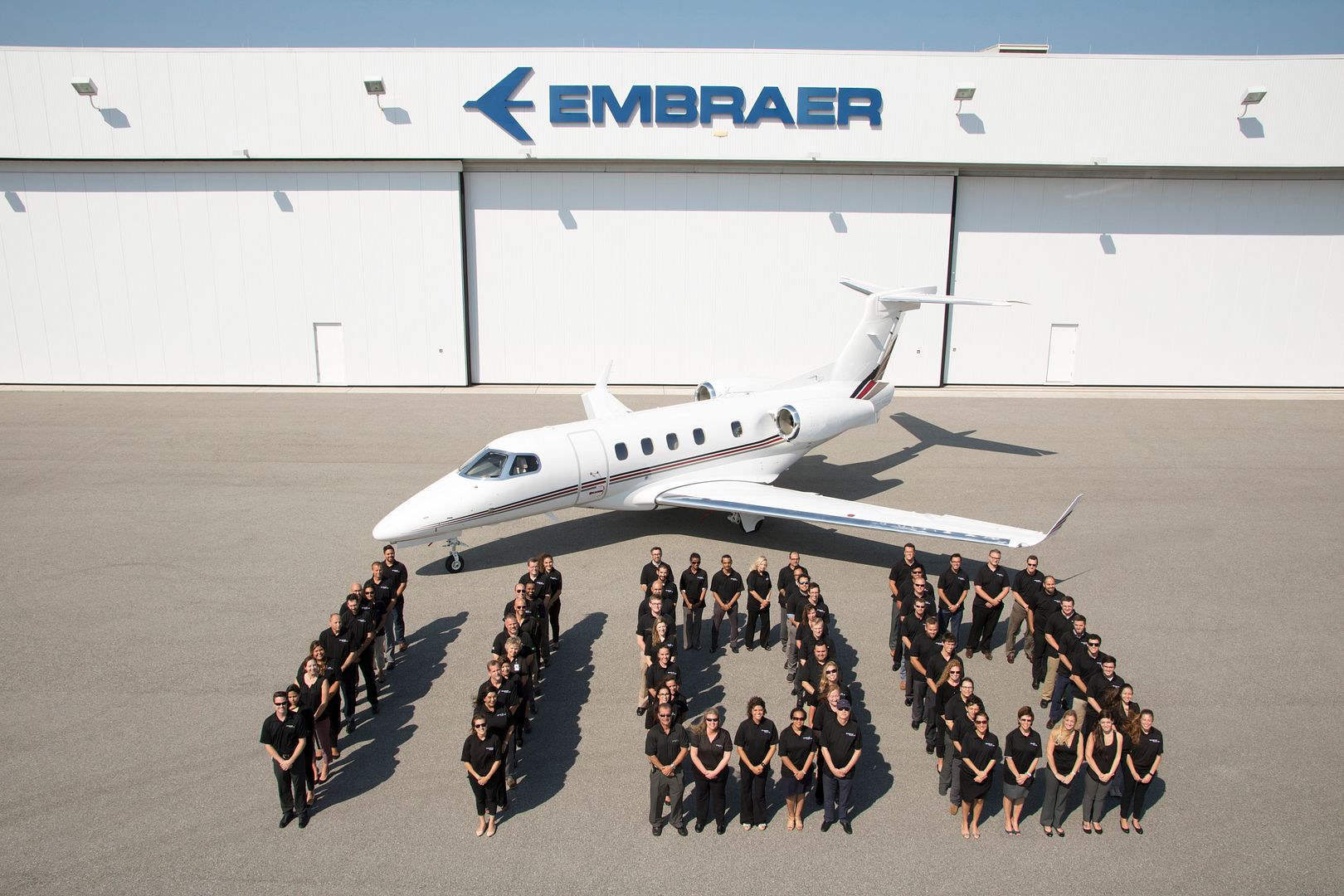
-
7 years agoSat May 06 2017, 04:05pm
 Main AdminJim Tobul maneuvers an F4U-4 Corsair during the South Carolina National Guard Air and Ground Expo at McEntire Joint National Guard Base, South Carolina, May 5, 2017. This expo is a combined arms demonstration showcasing the abilities of South Carolina National Guard Airmen and Soldiers while saying thank you for the support of fellow South Carolinians and the surrounding community. (U.S. Air Force photo by Airman 1st Class Kathryn R.C. Reaves)
Main AdminJim Tobul maneuvers an F4U-4 Corsair during the South Carolina National Guard Air and Ground Expo at McEntire Joint National Guard Base, South Carolina, May 5, 2017. This expo is a combined arms demonstration showcasing the abilities of South Carolina National Guard Airmen and Soldiers while saying thank you for the support of fellow South Carolinians and the surrounding community. (U.S. Air Force photo by Airman 1st Class Kathryn R.C. Reaves)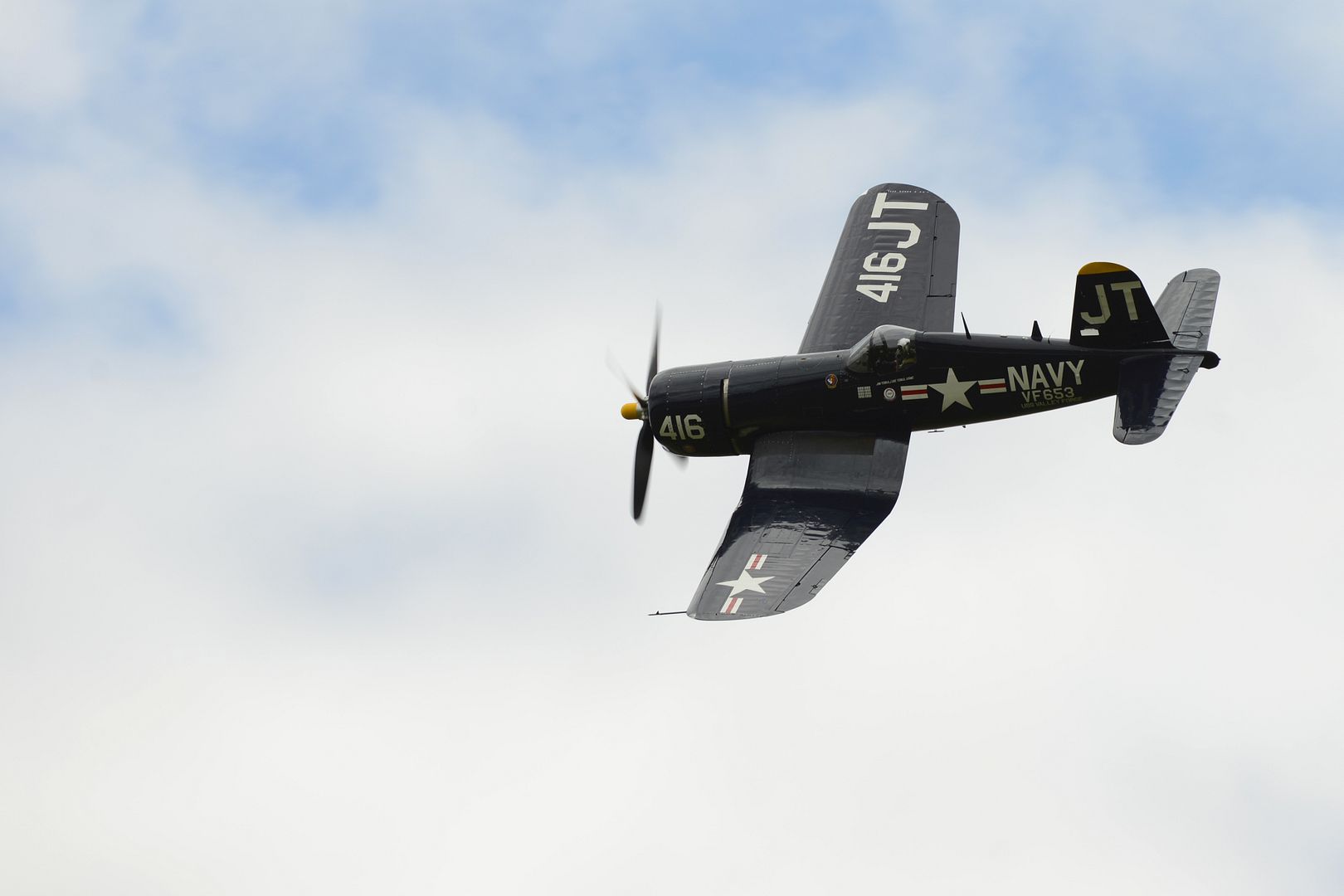
A pilot maneuvers an F-86 Sabre during the South Carolina National Guard Air and Ground Expo at McEntire Joint National Guard Base, South Carolina, May 5, 2017. This expo is a combined arms demonstration showcasing the abilities of South Carolina National Guard Airmen and Soldiers while saying thank you for the support of fellow South Carolinians and the surrounding community. (U.S. Air Force photo by Airman 1st Class Kathryn R.C. Reaves)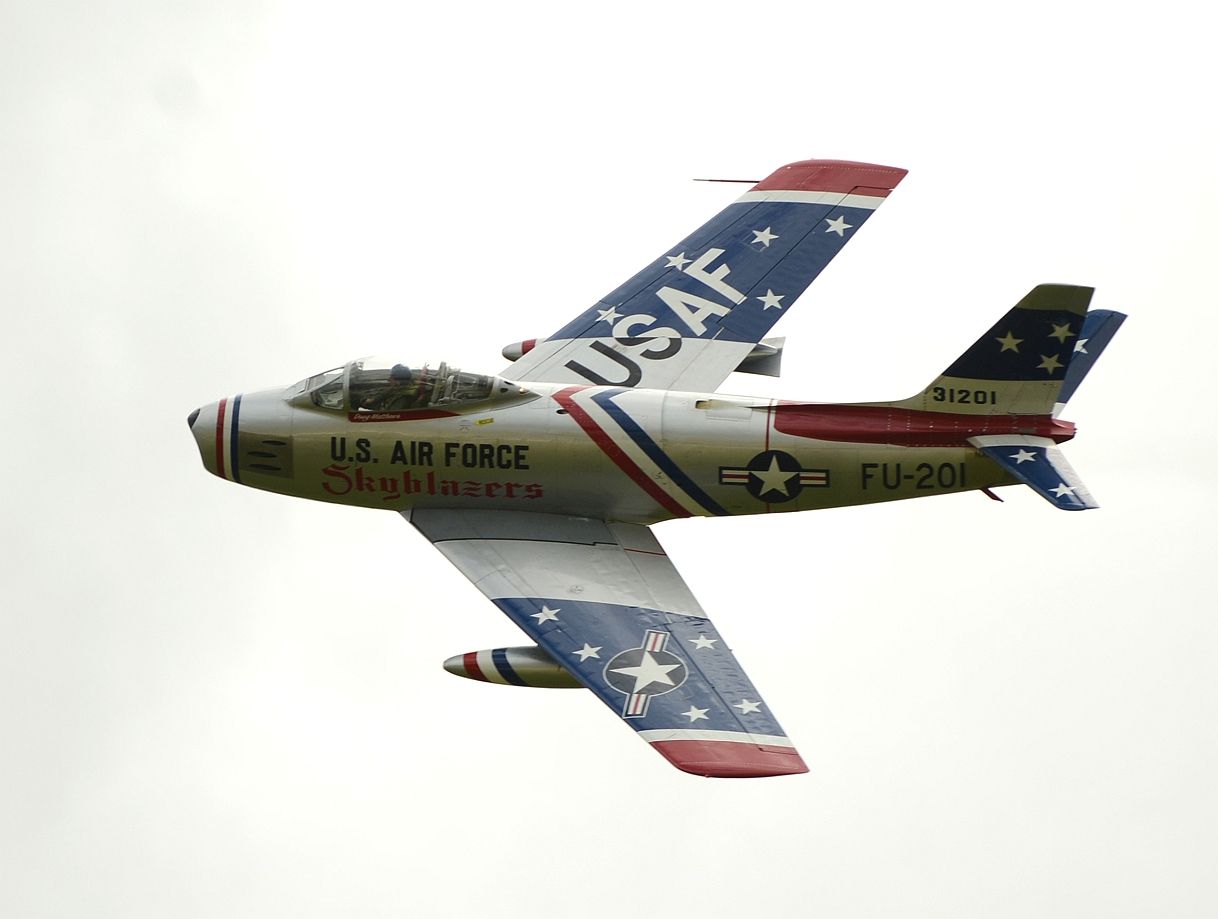
Service members from the Air Force, Navy and Marine Corps service more than 60 aircraft after the morning sortie May 5,2017, during Exercise Northern Edge 2017(NE17). NE17 provides comprehensive, realistic training for approximately 6,000 service members across all military branches.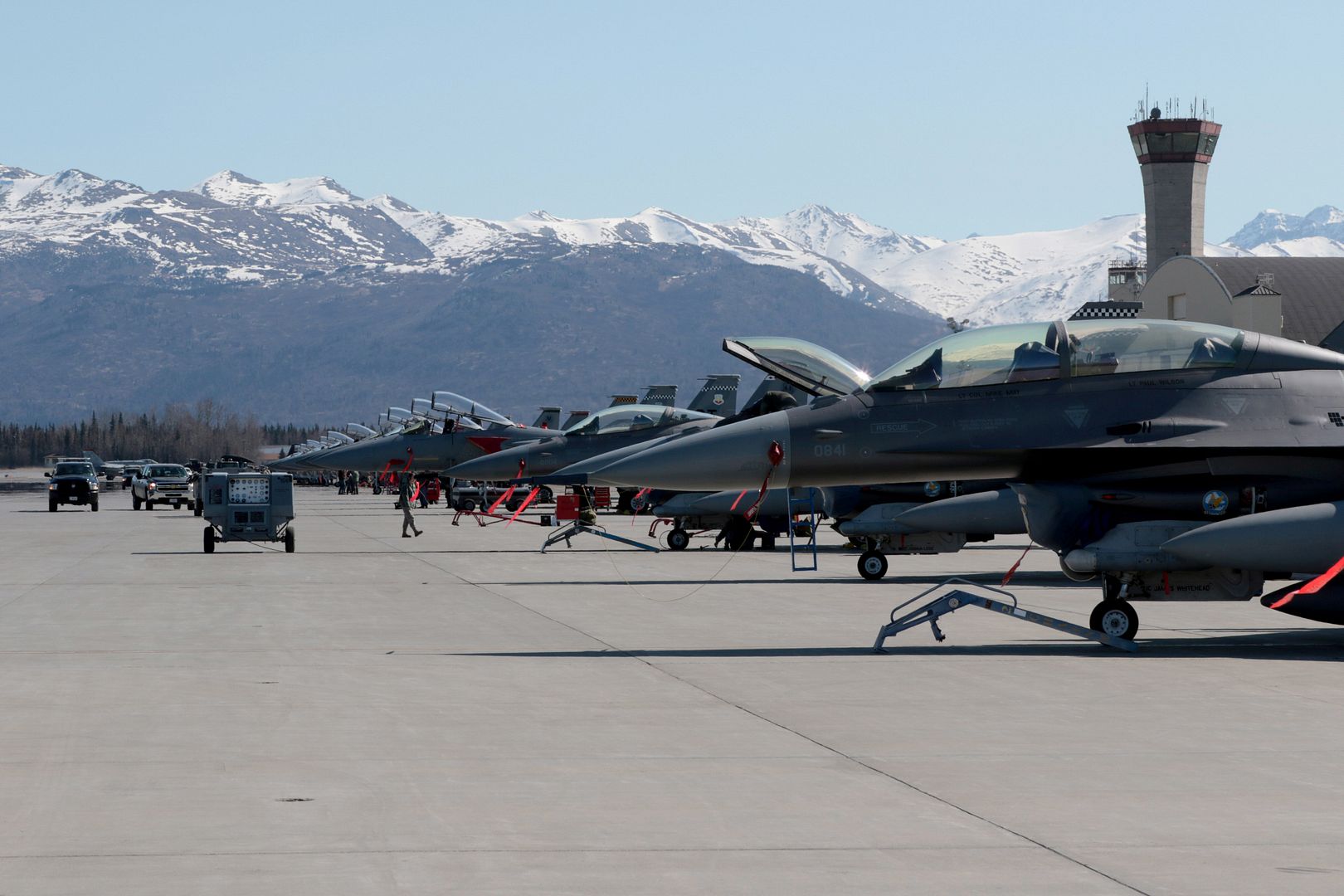
The United States Air Force Thunderbirds perform an aerial demonstration practice at Travis Air Force Base, Calif., May 5, 2017. The Thunderbirds will be performing in the Wings Over Solano air show at Travis AFB. The two-day event will feature performances by the U.S. Army Golden Knights parachute team, flyovers, and static displays. (U.S. Air Force photo by Louis Briscese)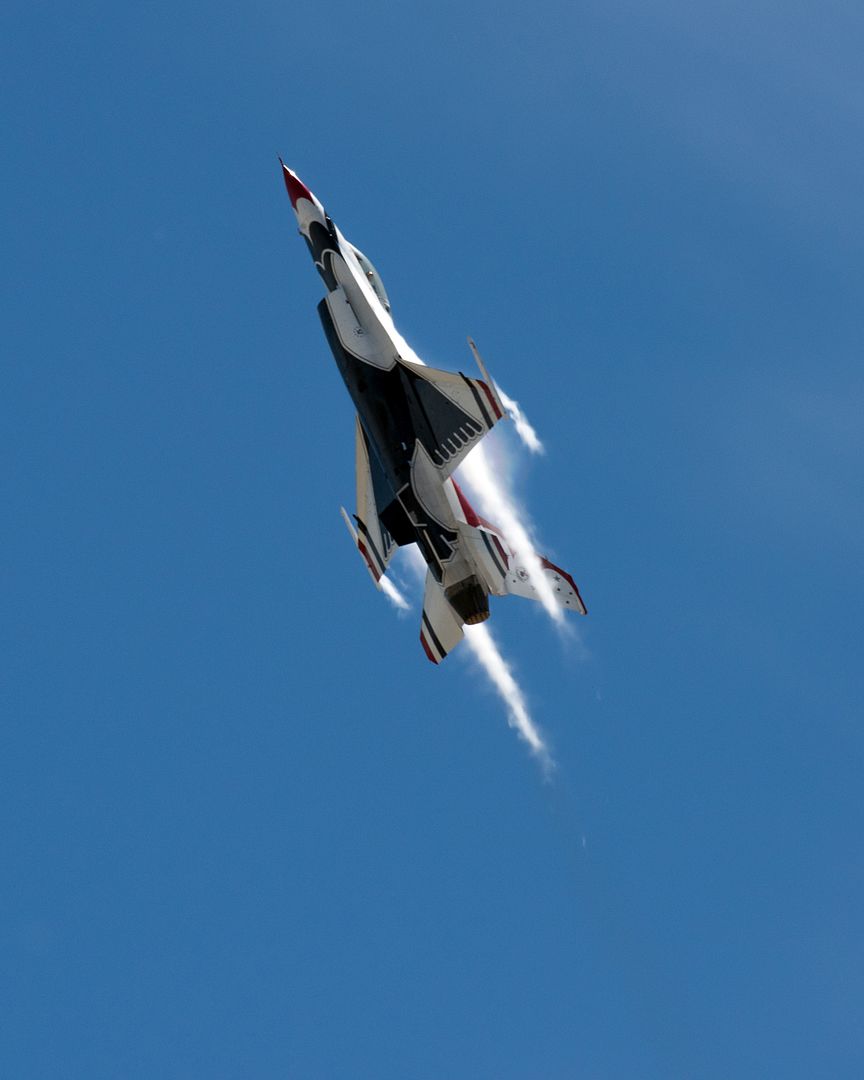
EIELSON AIR FORCE BASE, Alaska ? A U.S. Air Force F-16 Fighting Falcon aircraft assigned to the 13th Fighter Squadron, Misawa Air Base, Japan, takes off for a sortie from Eielson Air Force Base, Alaska, May 4, 2017 during NORTHERN EDGE 2017 (NE17). NE17 is Alaska?s premier joint training exercise designed to practice operations, techniques and procedures as well as enhance interoperability among the services. Thousands of participants from all the services, Airmen, Soldiers, Sailors, Marines and Coast Guardsmen from active duty, Reserve and National Guard units are involved. (U.S. Air Force photo/Staff Sgt. Ashley Nicole Taylor)
EIELSON AIR FORCE BASE, Alaska ? U.S. Air Force pilots assigned to the 335th Fighter Squadron and Airmen assigned to the 335th Aircraft Maintenance Unit, Seymour Johnson Air Force Base, N.C., prepare to launch F15E Strike Eagle dual-role fighter aircraft for a sortie during NORTHERN EDGE 2017 (NE17), May 4, 2017, at Eielson Air Force Base, Alaska. NE17 is Alaska?s premier joint training exercise designed to practice operations, techniques and procedures as well as enhance interoperability among the services. Thousands of participants from all the services, Airmen, Soldiers, Sailors, Marines and Coast Guardsmen from active duty, Reserve and National Guard units are involved. (U.S. Air Force photo/Staff Sgt. Ashley Nicole Taylor)
EIELSON AIR FORCE BASE, Alaska ? U.S. Air Force F-15 Strike Eagle aircraft assigned from Seymour Johnson Air Force Base, North Carolina, taxis down the flight line during NORTHERN EDGE 2017 (NE17), May 4, 2017, at Eielson Air Force Base, Alaska. NE17 is Alaska?s premier joint training exercise designed to practice operations, techniques and procedures as well as enhance interoperability among the services. Thousands of participants from all the services, Airmen, Soldiers, Sailors, Marines and Coast Guardsmen from active duty, Reserve and National Guard units are involved. (U.S. Air Force photo by Airman 1st Class Isaac Johnson)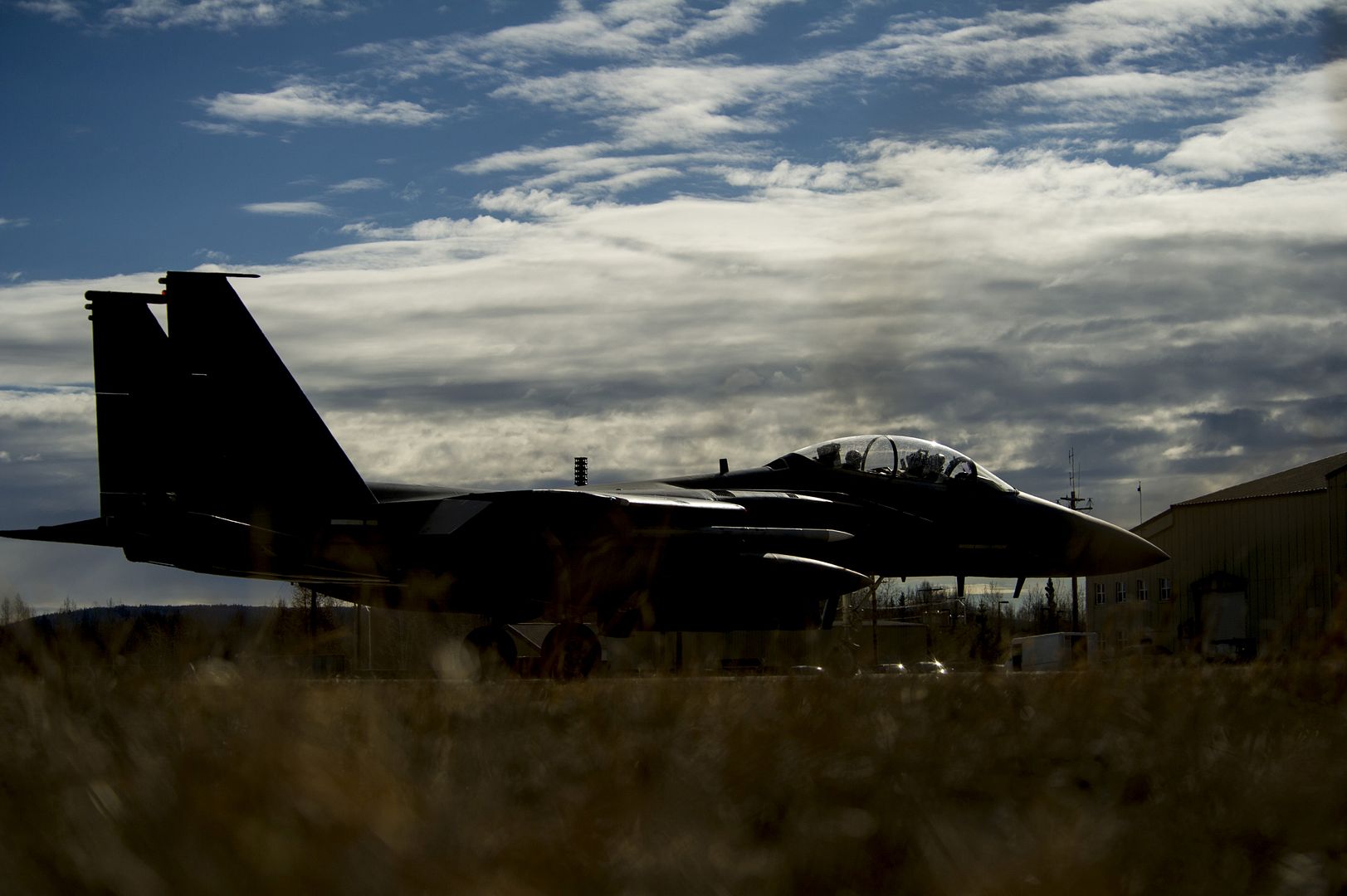
EIELSON AIR FORCE BASE, Alaska ? A U.S. Air Force F-16 Fighting Falcon aircraft assigned to the 18th Aggressor Squadron takes off for a sortie from Eielson Air Force Base, Alaska, May 4, 2017 during NORTHERN EDGE 2017 (NE17). NE17 is Alaska?s premier joint training exercise designed to practice operations, techniques and procedures as well as enhance interoperability among the services. Thousands of participants from all the services, Airmen, Soldiers, Sailors, Marines and Coast Guardsmen from active duty, Reserve and National Guard units are involved. (U.S. Air Force photo by Airman Eric M. Fisher)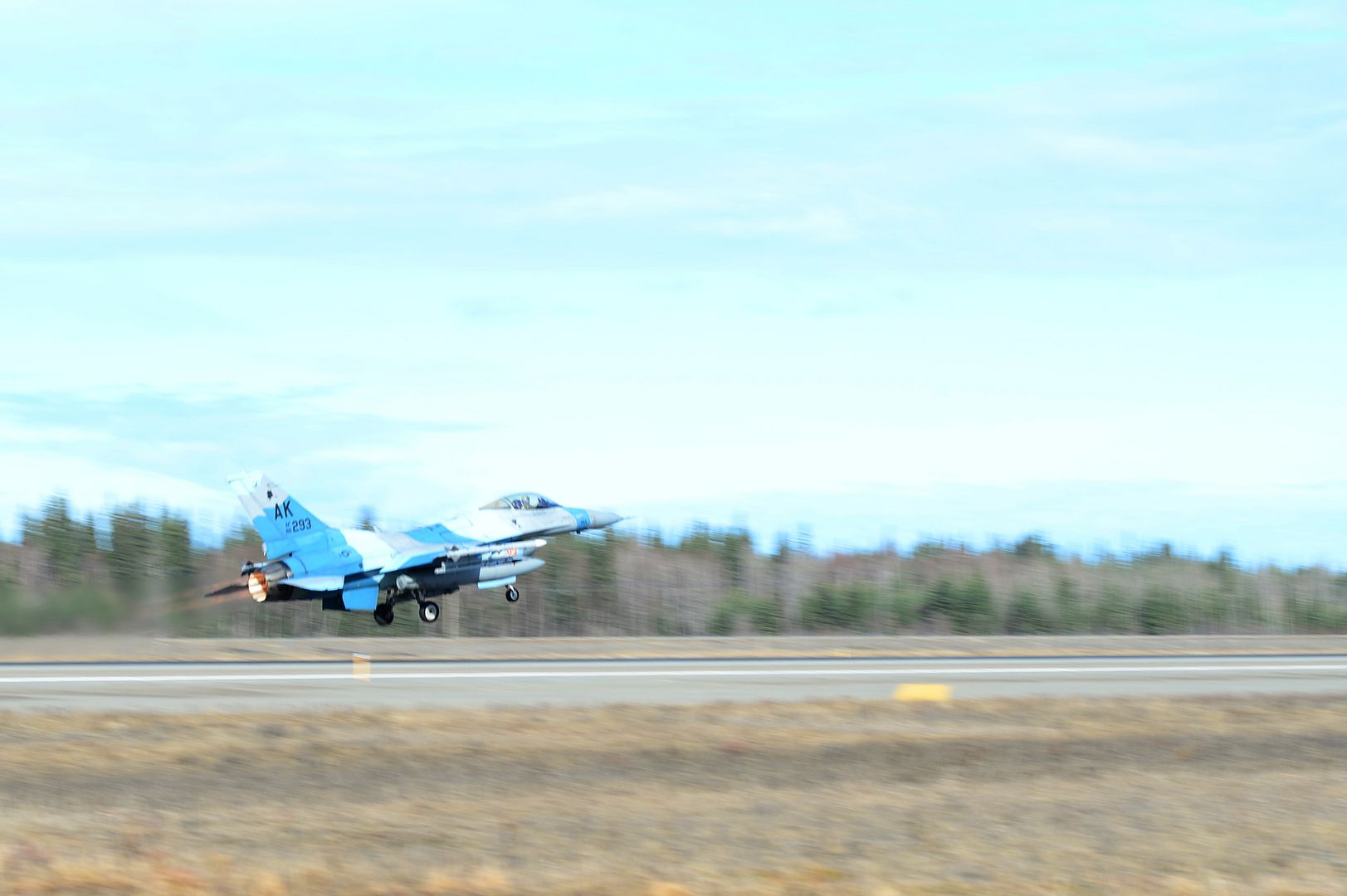
EIELSON AIR FORCE BASE, Alaska ? A U.S. Air Force F-15E Strike Eagle dual-role fighter aircraft assigned to the 335th Fighter Squadron, Seymour Johnson Air Force Base, N.C., takes off for a sortie from Eielson Air Force Base, Alaska, May 4, 2017 during NORTHERN EDGE 2017 (NE17). NE17 is Alaska?s premier joint training exercise designed to practice operations, techniques and procedures as well as enhance interoperability among the services. Thousands of participants from all the services, Airmen, Soldiers, Sailors, Marines and Coast Guardsmen from active duty, Reserve and National Guard units are involved. (U.S. Air Force photo by Airman Eric M. Fisher)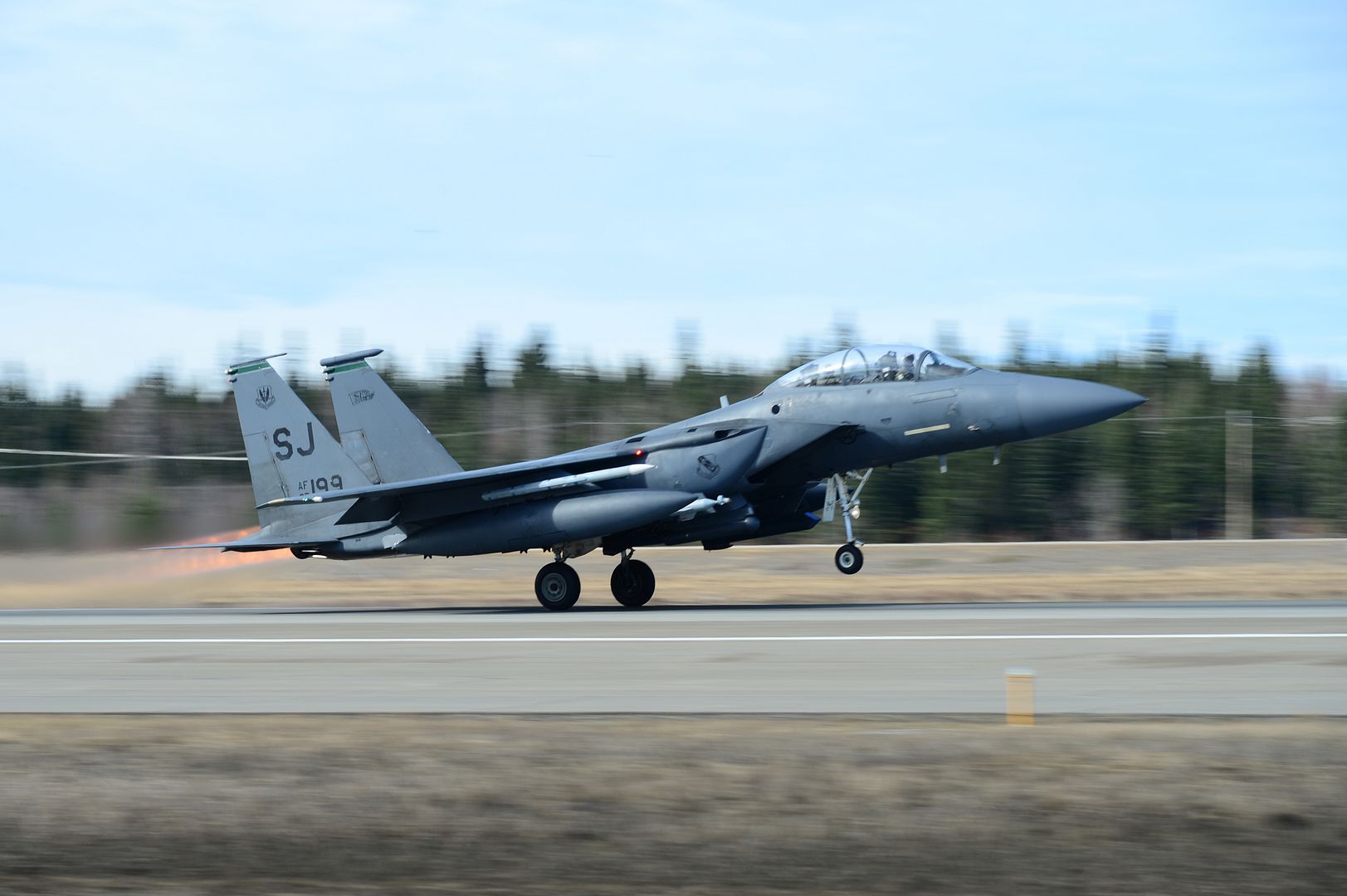
Lt. Col. Shell, 27th Fighter Squadron commander, pilots an F-22A Raptor toward a KC-10 Extender boom May 2, 2017, over an undisclosed location in southwest Asia. The 27 EFS reaches its 100th anniversary May 8, 2017. (U.S. Air Force photo's by Senior Airman Preston Webb)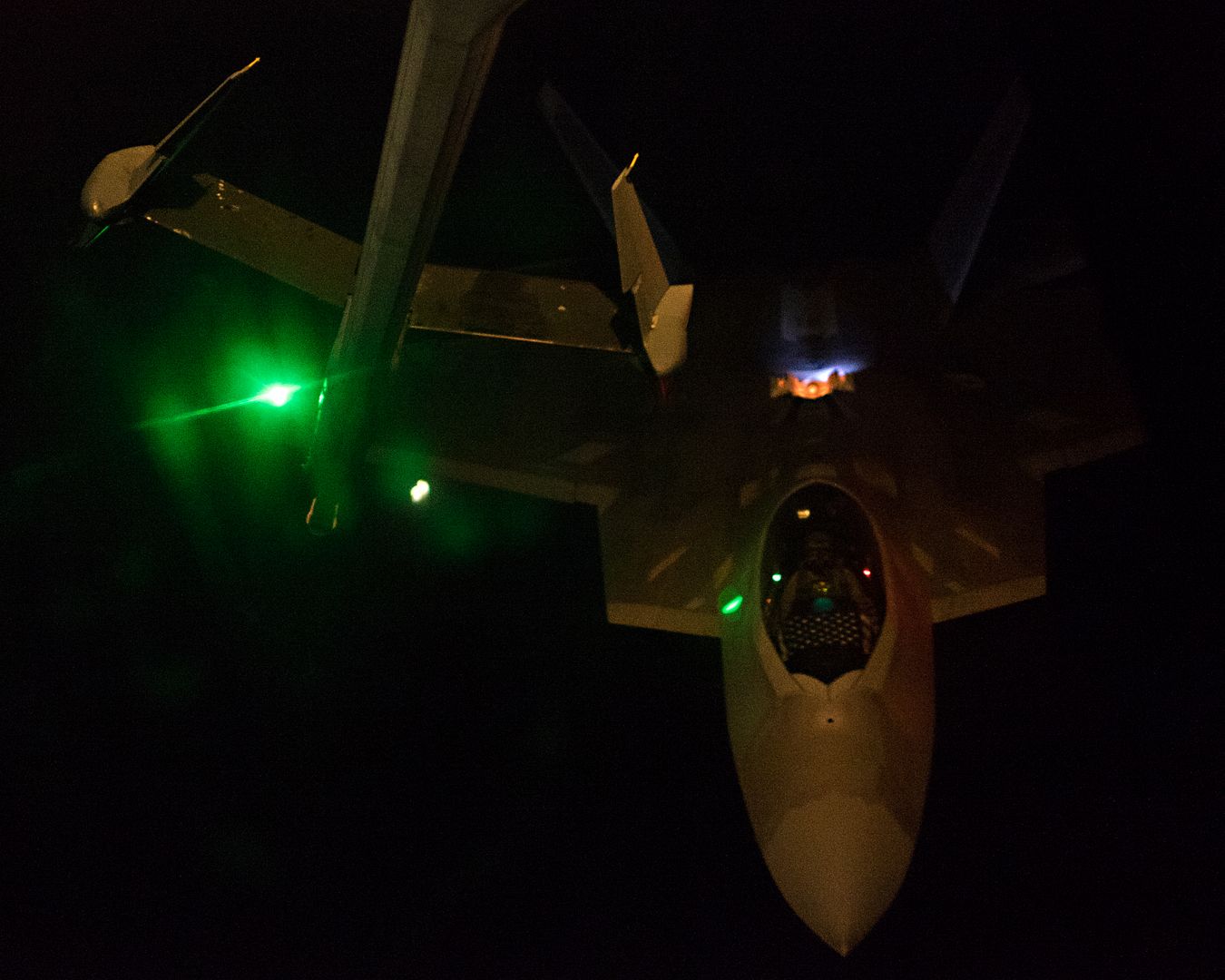
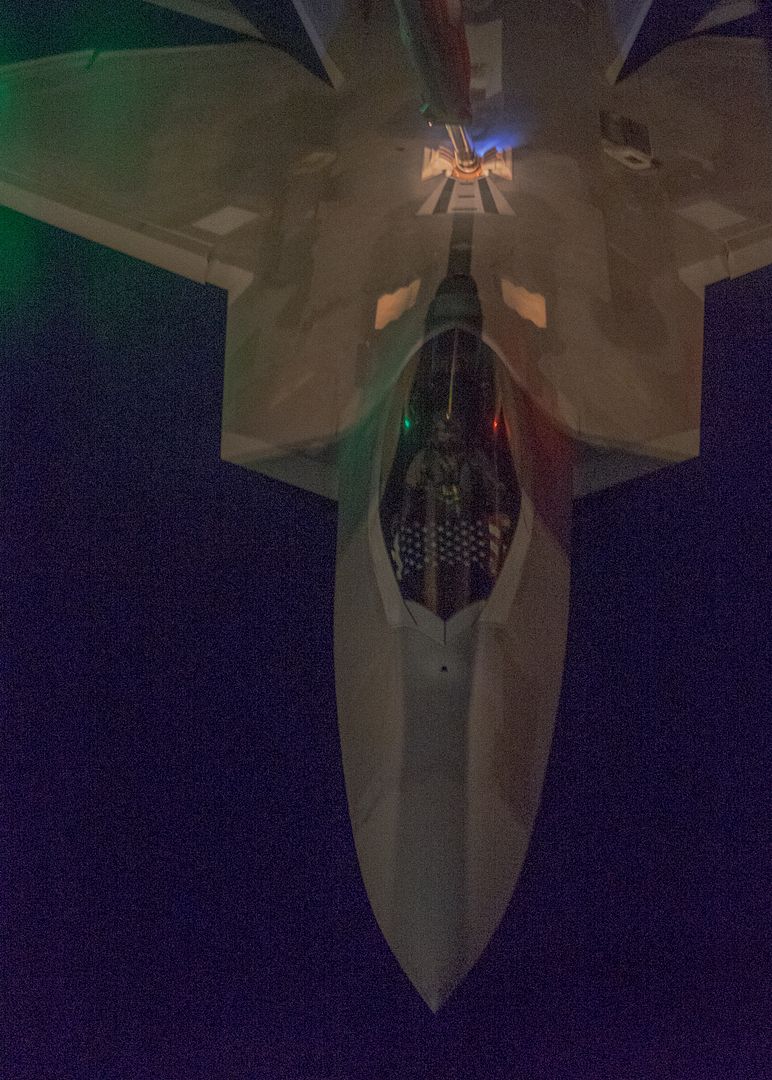
CAMERI, Italy, May 5, 2017 /PRNewswire/ -- The first Short Take-Off/Vertical Landing version of the F-35, or F-35B, assembled outside the United States rolled out of the Final Assembly and Check Out (FACO) facility here today.
The rollout exhibits the ongoing strong partnership between the Italian Ministry of Defense, industry partner Leonardo and Lockheed Martin (NYSE: LMT). The Italian FACO is owned by the Italian Ministry of Defense and is operated by Leonardo in conjunction with Lockheed Martin with a current workforce of more than 800 skilled personnel engaged in full assembly of the Conventional Take-off/Landing F-35A and F-35B aircraft variants and F-35A wing production.
Gen. Claudio Graziano, Italian chief of defense, Gen. Carlo Magrassi, secretary general of defense/director of National Armament, Adm. Mathias Winter, deputy program executive officer at the F-35 Joint Program Office, Filippo Bagnato, Leonardo Aircraft Division's Managing Director, and Doug Wilhelm, Lockheed Martin F-35 Program Management vice president, spoke at the milestone event.
"Italy is not only a valued F-35 program partner that has achieved many F-35 program 'firsts', but is also a critical NATO air component force, providing advanced airpower for the alliance for the coming decades," Wilhelm said. "Italian industry has participated in the design of the F-35 and Italian industry made components fly on every production F-35 built to date."
The jet's first flight is anticipated in late August and it is programmed to be delivered to the Italian Ministry of Defense in November. In addition, two Italian F-35A aircraft will deliver from Cameri this year, the first by July and the second in the fourth quarter. To date, seven F-35As have been delivered from the Cameri FACO; four of those jets are now based at Luke Air Force Base, Arizona, for international pilot training and three are at Amendola Air Base, near Foggio on the Adriatic coast. The Aeronautica Militare (Italian Air Force) has already flown more than 100 flight hours in its Amendola-based F-35As.
After a series of confidence flights from Cameri, an Italian pilot will fly their first F-35B jet to Naval Air Station Patuxent River, Maryland, early in 2018 to conduct required Electromagnetic Environmental Effects certification. The next Italian F-35B aircraft is scheduled for delivery in November 2018. The Cameri FACO has the only F-35B production capability outside the United States and is programmed to produce a total of 30 Italian F-35Bs and 60 Italian F-35As, along with 29 F-35As for the Royal Netherlands Air Force, and retains the capacity to deliver to other European partners in the future.
The Italian FACO is also producing 835 F-35A full wing sets to support all customers in the program. The FACO was selected by the U.S. Department of Defense in 2014 as the F-35 Lightning II Heavy Airframe Maintenance, Repair, Overhaul and Upgrade facility for the European region. The 101-acre facility includes 22 buildings and more than one million square feet of covered work space, housing 11 assembly stations, and five maintenance, repair, overhaul, and upgrade bays.
On September 7, 2015, the first Italian-produced F-35 built at the Cameri FACO made the first international flight in F-35 program history, and in February 2016, the F-35A made the program's first trans-Atlantic crossing. In December 2016, the Italian Air Force's first F-35s arrived at the first in-country base, Amendola AB.
The F-35 Lightning II is a 5th generation fighter, combining advanced stealth with fighter speed and agility, advanced mission systems, fully fused sensor information, network-enabled operations and cutting-edge sustainment. Three distinct variants of the F-35 will replace the A-10 and F-16 for the U.S. Air Force, the F/A-18 for the U.S. Navy, the F/A-18 and AV-8B Harrier for the U.S. Marine Corps, and a variety of fighters for at least 11 other countries. The Italian F-35As and Bs replace the legacy Panavia Tornado, AMX and AV-8B aircraft. More than 200 production F-35s have been delivered fleet-wide and have flown more than 90,000 flight hours.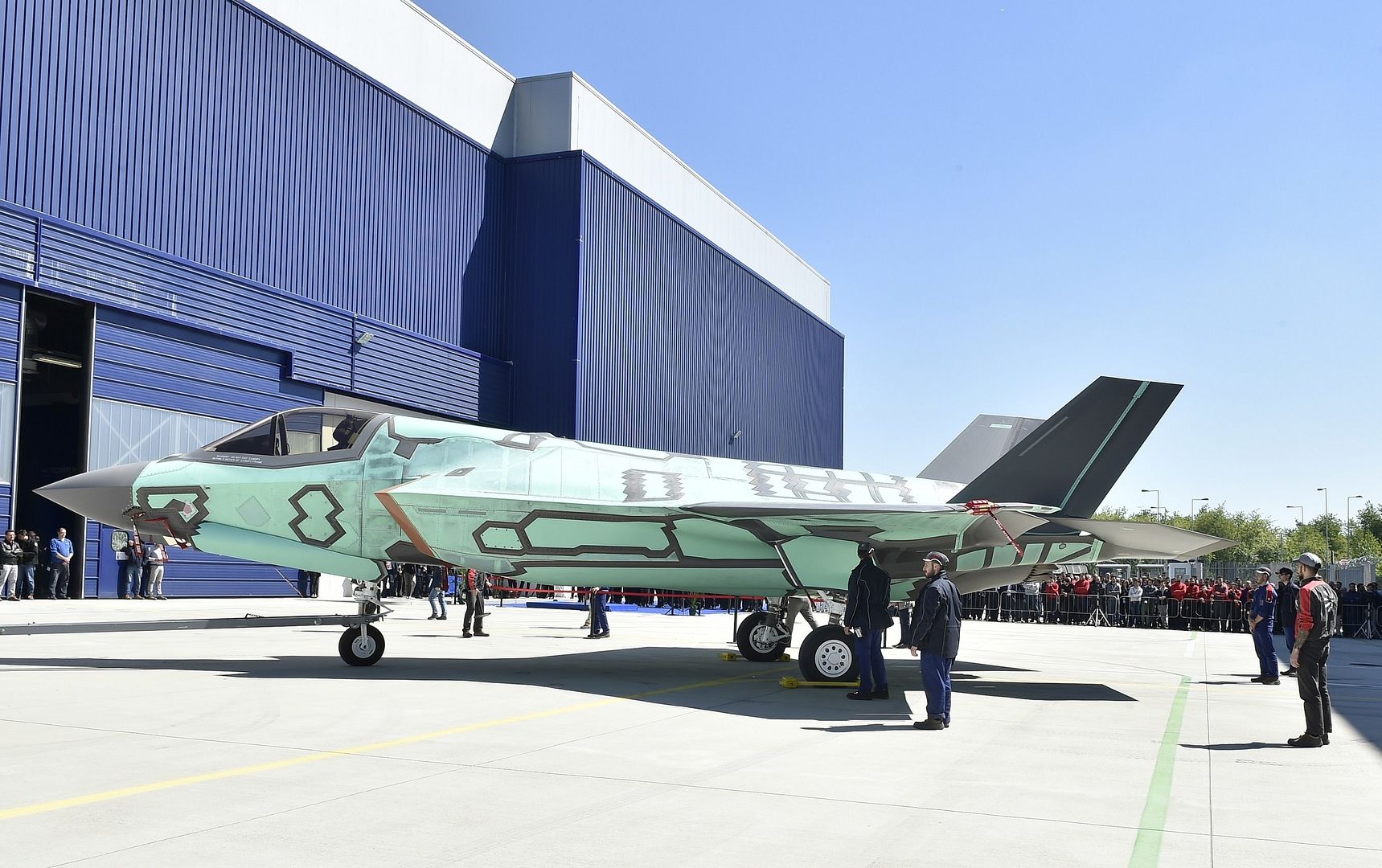
-
 Main AdminWASHINGTON (AFNS) -- The X-37B Orbital Test Vehicle mission 4 (OTV-4), the Air Force's unmanned, reusable space plane, landed at NASA?s Kennedy Space Center Shuttle Landing Facility May 7, 2017.
Main AdminWASHINGTON (AFNS) -- The X-37B Orbital Test Vehicle mission 4 (OTV-4), the Air Force's unmanned, reusable space plane, landed at NASA?s Kennedy Space Center Shuttle Landing Facility May 7, 2017.
?Today marks an incredibly exciting day for the 45th Space Wing as we continue to break barriers,? said Brig. Gen. Wayne Monteith, the 45th SW commander. ?Our team has been preparing for this event for several years, and I am extremely proud to see our hard work and dedication culminate in today?s safe and successful landing of the X-37B.?
The OTV-4 conducted on-orbit experiments for 718 days during its mission, extending the total number of days spent on-orbit for the OTV program to 2,085 days.
"The landing of OTV-4 marks another success for the X-37B program and the nation," said Lt. Col. Ron Fehlen, X-37B program manager. "This mission once again set an on-orbit endurance record and marks the vehicle's first landing in the state of Florida. We are incredibly pleased with the performance of the space vehicle and are excited about the data gathered to support the scientific and space communities. We are extremely proud of the dedication and hard work by the entire team."
The X-37B is the newest and most advanced re-entry spacecraft. Managed by the Air Force Rapid Capabilities Office, the X-37B program performs risk reduction, experimentation and concept of operations development for reusable space vehicle technologies.
"The hard work of the X-37B OTV team and the 45th Space Wing successfully demonstrated the flexibility and resolve necessary to continue the nation's advancement in space," said Randy Walden, the director of the Air Force Rapid Capabilities Office. "The ability to land, refurbish, and launch from the same location further enhances the OTV's ability to rapidly integrate and qualify new space technologies."
The Air Force is preparing to launch the fifth X-37B mission from Cape Canaveral Air Force Station, Florida, later in 2017.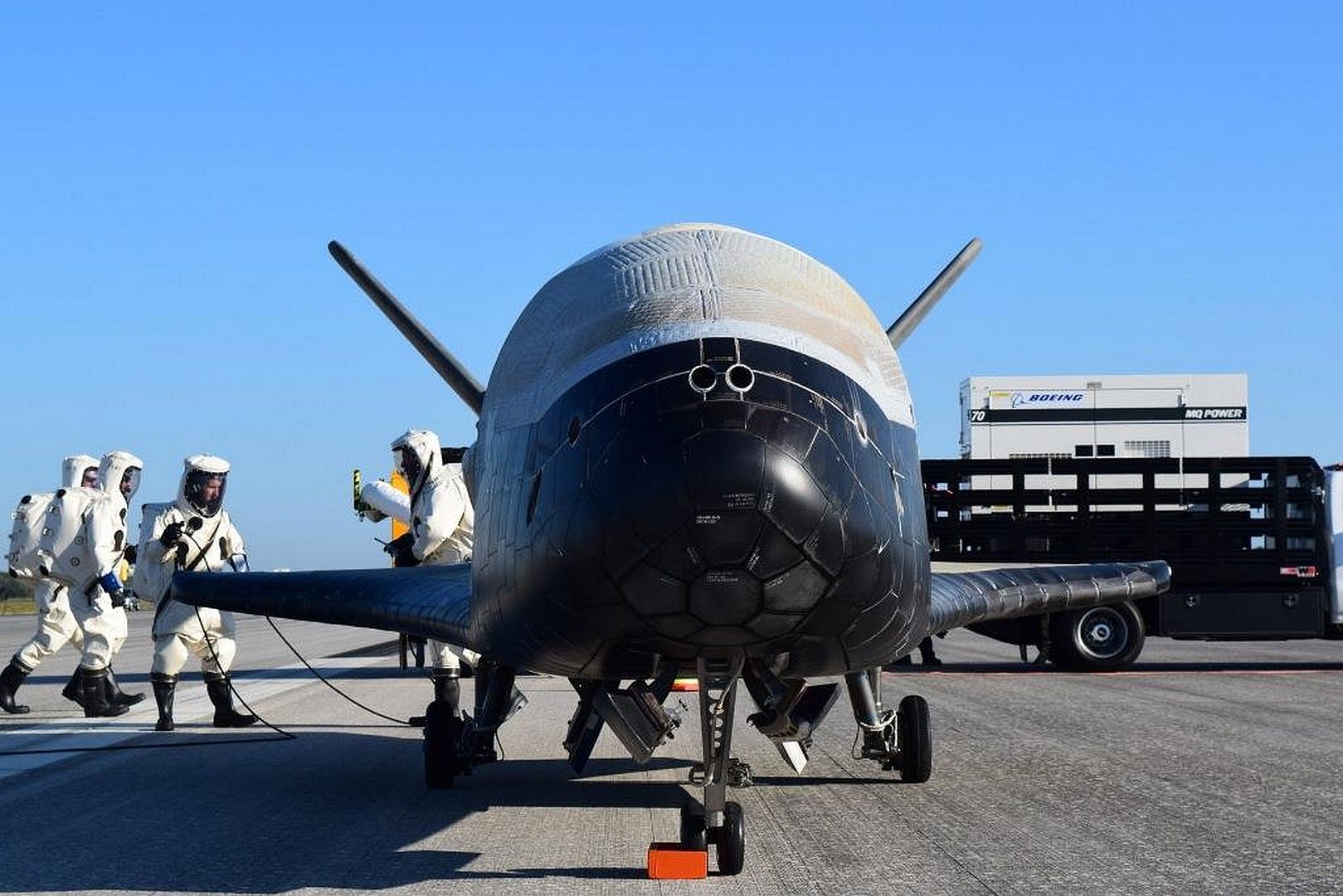
Wings Over Solano Air Show, Travis Air Force Base, Calif., May 5 & 6, 2017. The two day event featured performances by the United States Air Force Thunderbirds aerial demonstration team, U.S. Army Golden Knights parachute team, flyovers, and static displays.
(U.S. Air Force photo by David Cushman)
The Japan Air Self-Defense Force?s Blue Impulse performs aerial demonstrations during the 41st Japan Maritime Self-Defense Force ? Marine Corps Air Station Iwakuni Friendship Day at MCAS Iwakuni, Japan, May 5, 2017. Since 1973, MCAS Iwakuni has held a single-day air show designed to foster positive relationships and offer an elevating experience that displays the communal support between the U.S. and Japan. The air show also encompassed various U.S. and Japanese static aircraft displays, aerial performances and demonstrations, food and entertainment. (U.S. Marine Corps photo by Lance Cpl. Joshua Pinkney)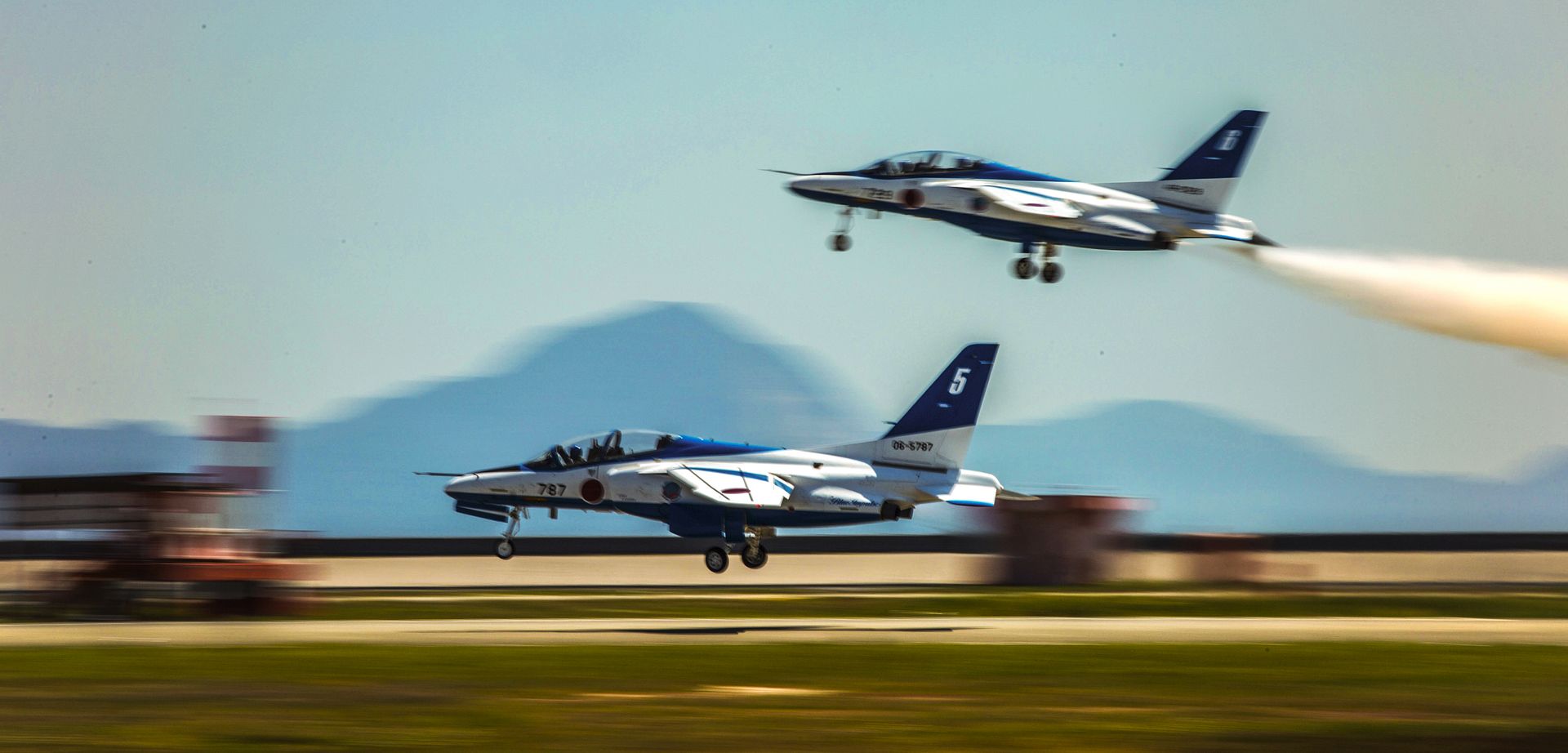
Royal Air Force Typhoon pilots have flown with their Romanian counterparts for the first time since arriving at a Black Sea airbase.
Two RAF Typhoons from 135 Expeditionary Air Wing joined a pair of Romanian Air Force MiG-21 Lancer aircraft for training at the Mihail Kogalniceanu airbase near Constanta.
The RAF is deployed to Romania as part of the UK?s contribution to the NATO ?Enhanced Air Policing? mission, one aspect of a wide range of UK support measures to reassure Allies and stand by our commitment to NATO and European security.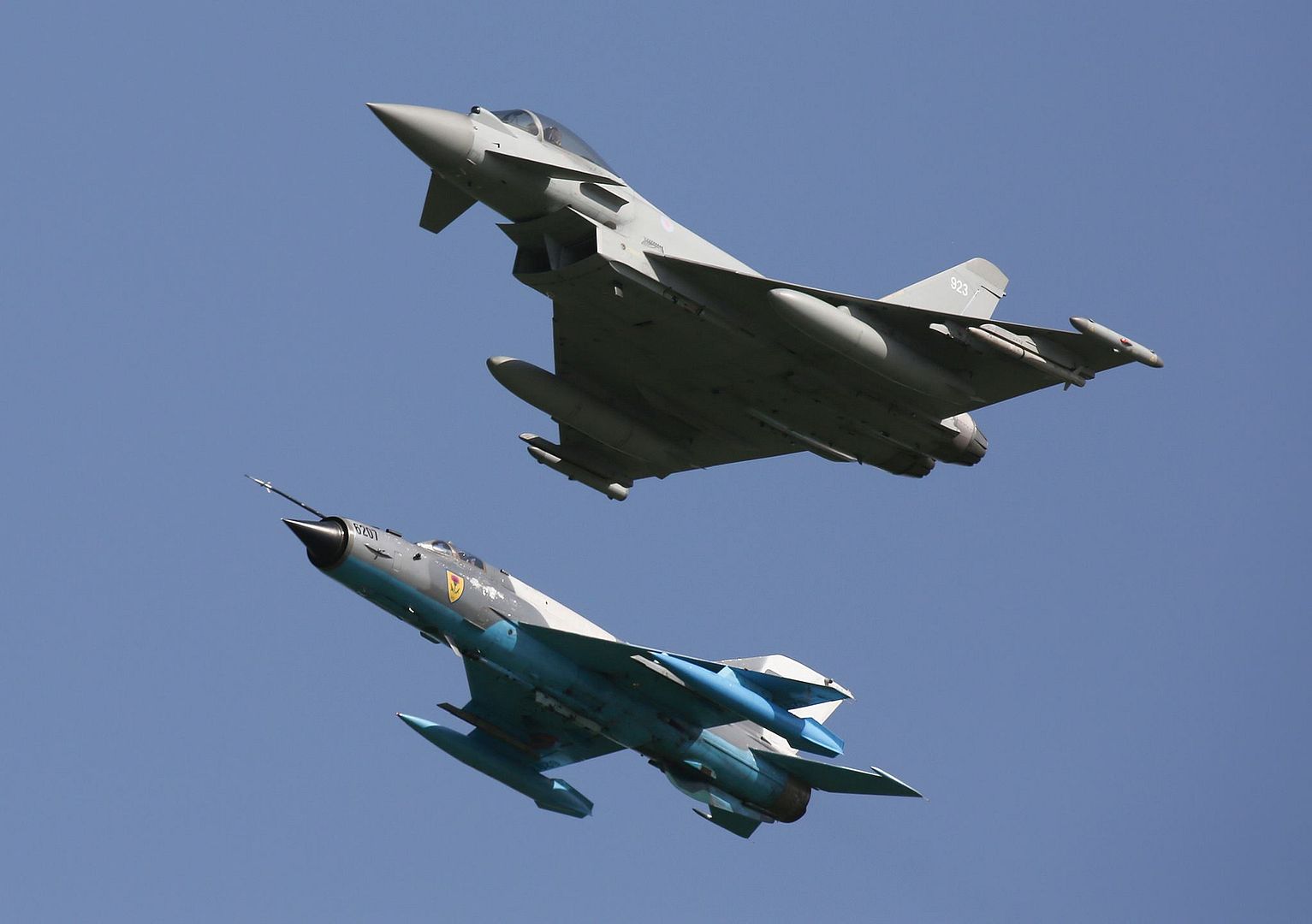
-
7 years agoTue May 09 2017, 09:07pm
 Main AdminROYAL AIR FORCE LAKENHEATH, England (AFNS) -- Eight F-35A Lightning IIs from the 34th Fighter Squadron, along with supporting units and equipment from Hill Air Force Base, Utah, completed the first F-35A training deployment to Europe, May 7, 2017.
Main AdminROYAL AIR FORCE LAKENHEATH, England (AFNS) -- Eight F-35A Lightning IIs from the 34th Fighter Squadron, along with supporting units and equipment from Hill Air Force Base, Utah, completed the first F-35A training deployment to Europe, May 7, 2017.
While at Royal Air Force Lakenheath, the squadron flew 76 sorties and tallied more than 154 flying hours alongside F-15s from the 48th Fighter Wing.
"This exercise provided our pilots with the opportunity to practice working together to solve complex tactical scenarios using integrated operations that optimized both the F-35 and F-15's capabilities,? said Lt. Col. Jason Zumwalt, the 493rd Fighter Squadron commander. ?We found that by working together, we can achieve a higher level of performance than either aircraft can achieve alone."
During the training deployment, the aircraft forward deployed to Estonia and Bulgaria to maximize training opportunities, build partnerships with allied air forces and familiarize Airmen with Europe?s broad and diverse operating conditions.
"This deployment was a great opportunity for the 34th (FS) and the 48th (FW) to practice 4th and 5th generation fighter integration tactics,? Zumwalt said. ?It was an honor to host the 34th (FS) at RAF Lakenheath, where we were able to integrate our operations in a shared workspace."
This training deployment highlighted the complementary capabilities of these different aircraft. It also assisted in validating and refining the bed-down procedures of the fifth generation, multi-role fighter aircraft in England. RAF Lakenheath is scheduled to receive its first permanent F-35A Lightning IIs in 2021.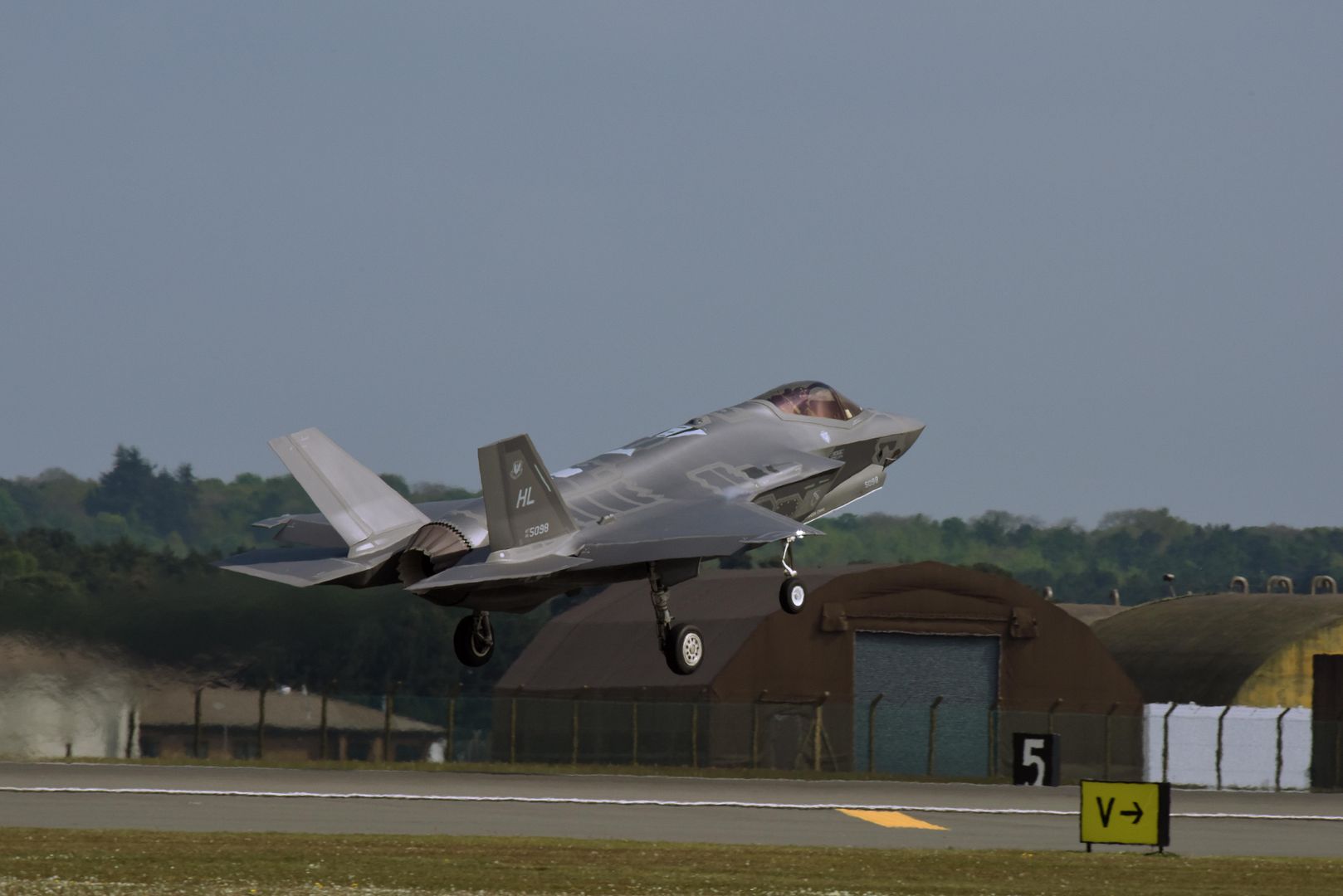
An RQ-4 Global Hawk assigned to the 69th Reconnaissance Group Detachment 1 takes off at Yokota Air Base, Japan, May 5, 2017. This was its first take-off since its arrival May 1, 2017. The Global Hawk supports U.S. intelligence, surveillance and reconnaissance priorities, operational plans, and contingency operations throughout the Pacific theater. (U.S. Air Force photo by Yasuo Osakabe)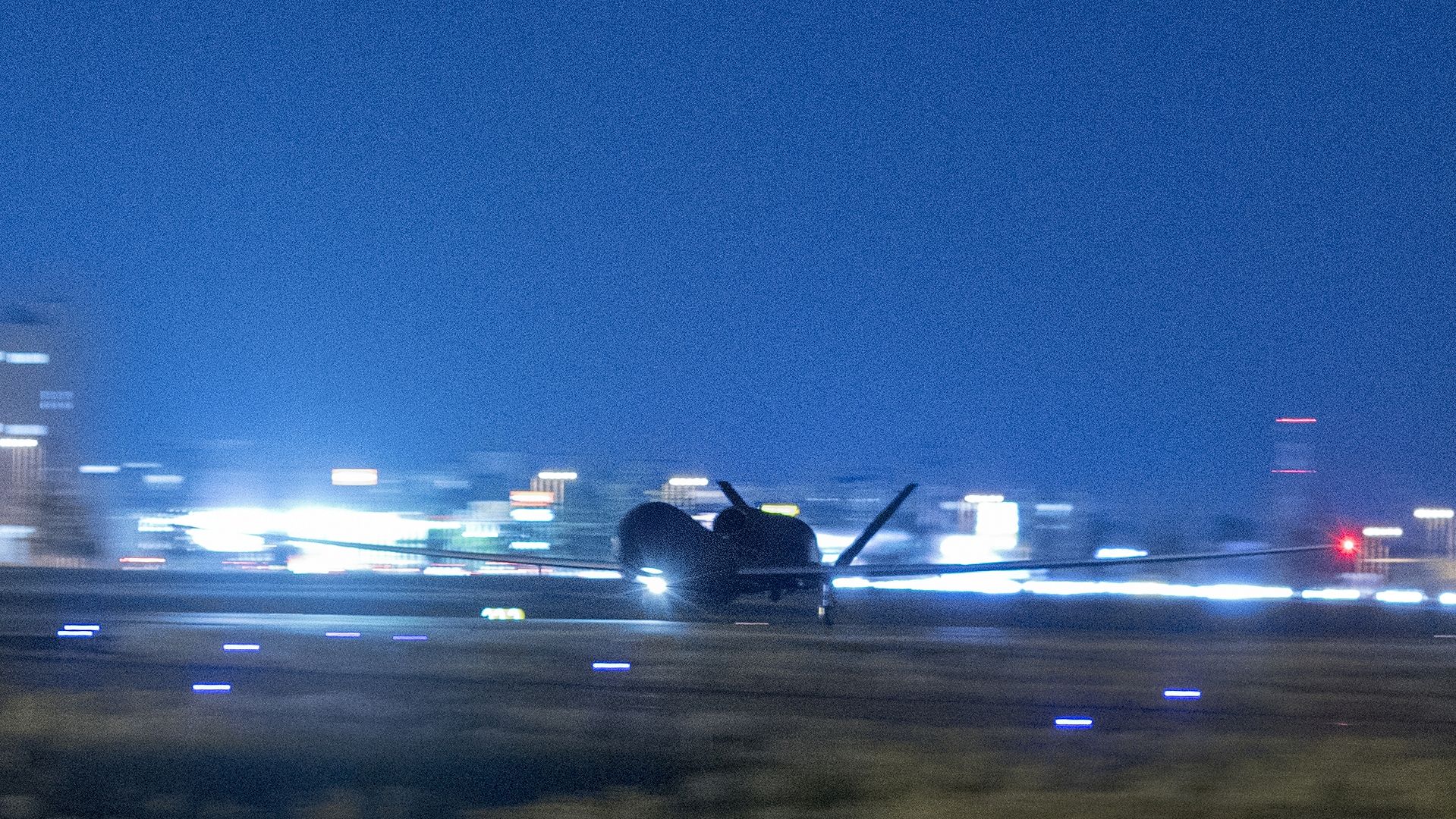
U.S. Air Force F-16 Fighting Falcons with the 14th Fighter Squadron, 35th Operations Group, 35th Fighter Wing from Misawa Air Base, stand by for take off after conducting hot pit refueling at Marine Corps Air Station Iwakuni, Japan, May 8, 2017. Hot pits are refueling stations usually used in combat to rapidly refuel aircraft while the engines are running. This allows aircraft to return to the fight with minimal delay. (U.S. Marine Corps photo by Pfc. Stephen Campbell)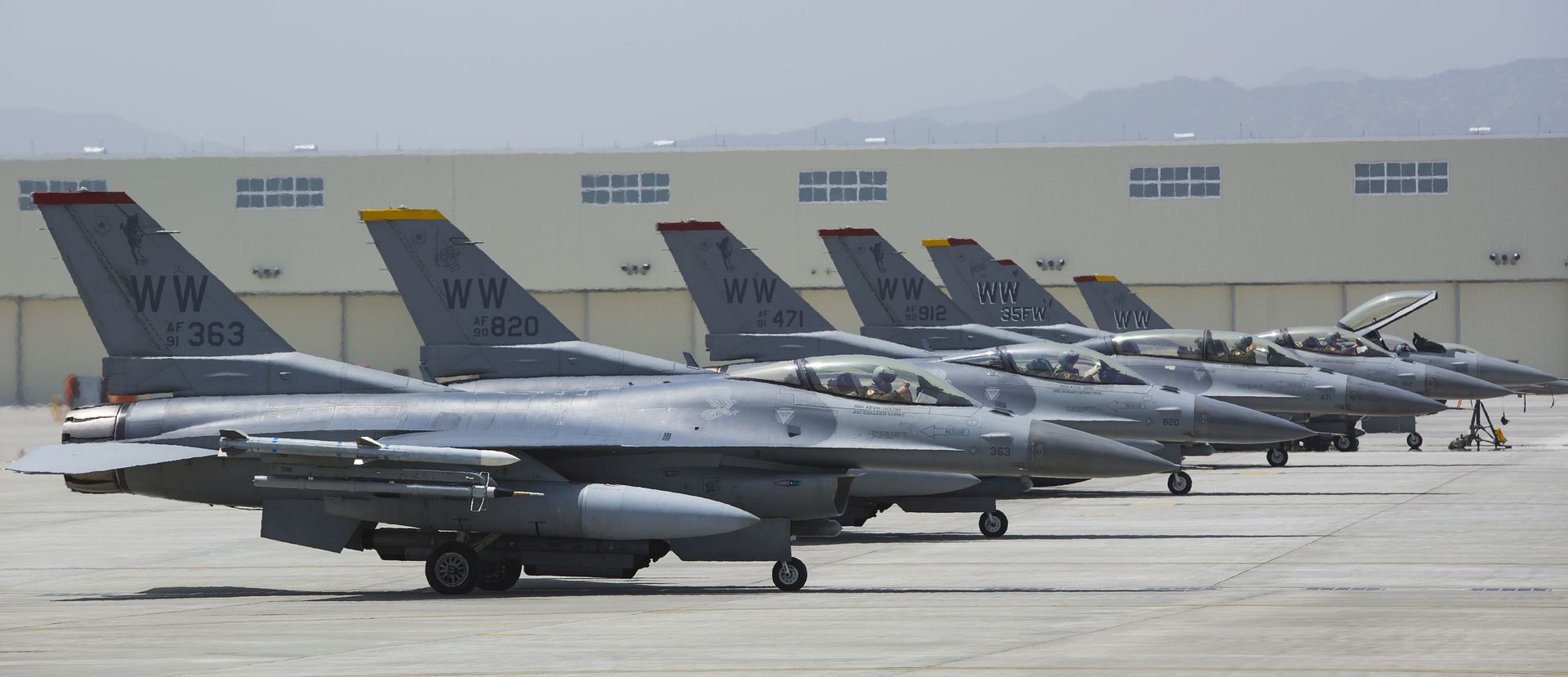
U.S. Navy F/A-18E Super Hornets from Strike Fighter Squadron (VFA) 115 and F/A-18F Super Hornets from VFA-102, with Carrier Air Wing (CVW) 5, conduct touch and go landings at Iwo To, Japan, formerly known as Iwo Jima, as part of field carrier landing practice, May 8, 2017. Field carrier landing practice helps prepare pilots to land aboard the USS Ronald Regan while out at sea. (U.S. Marine Corps photo's by Cpl. James A. Guillory)
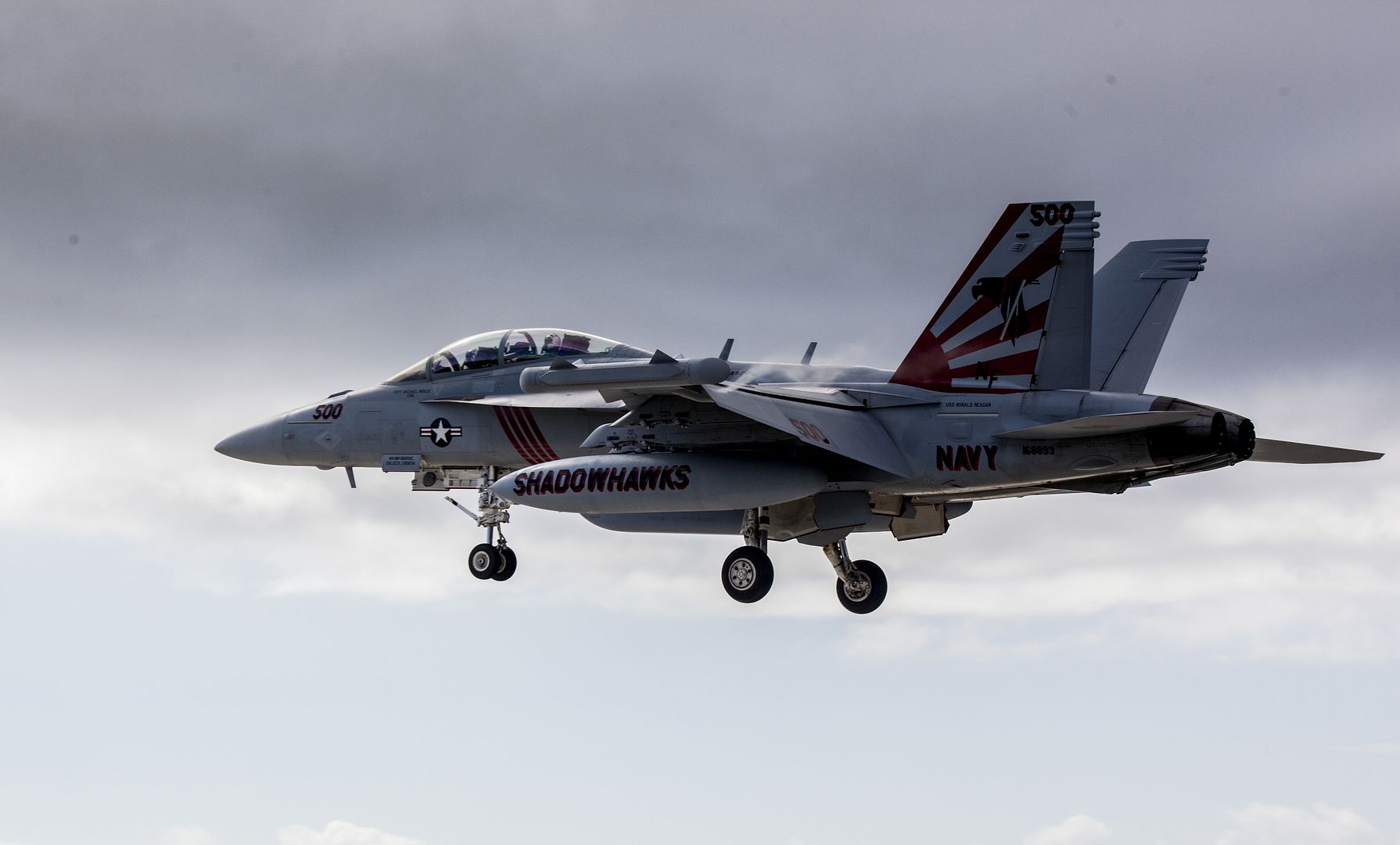

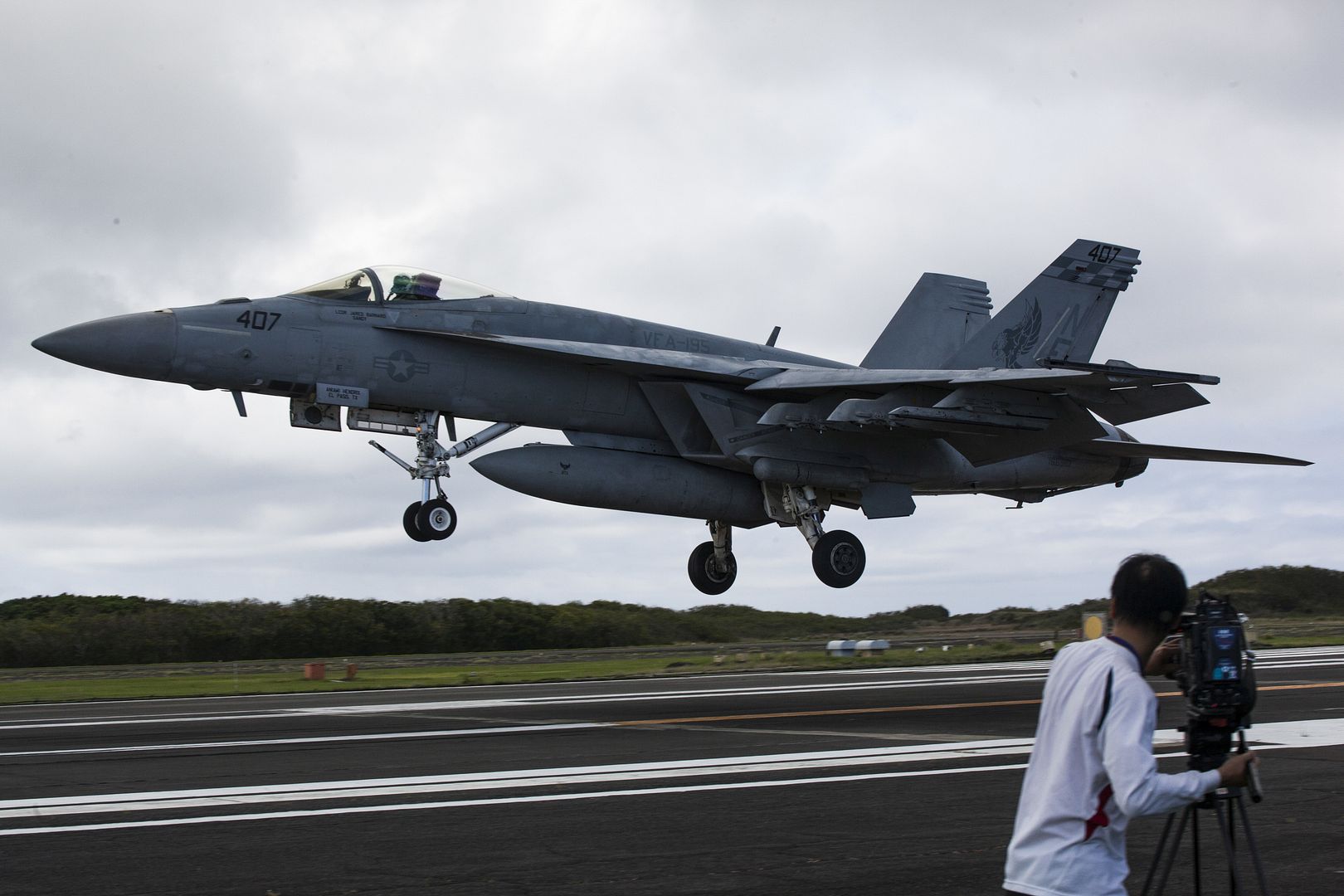
ARLINGTON, Va., May 8, 2017 ? Boeing [NYSE: BA] and the U.S. Air Force recently demonstrated that multiple aircraft and ground stations can efficiently and securely communicate using the Boeing-developed Talon HATE airborne networking system.
During flight testing at Nellis Air Force Base, Nev., Talon HATE pods on two F-15C aircraft enabled test pilots to share information through the military?s Link 16, Common Data Link and Wideband Global SATCOM satellites.
The tests also validated intra-flight datalink network capabilities used by F-22 aircraft.
Pilots using the system can transmit information quickly between the F-15C and other Air Force aircraft and weapon systems, enabling efficient information sharing in real time.
?We?ve completed developmental flight test,? said Lt. Col. Christopher Bradley, Air Force Talon HATE manager. ?We look forward to fielding this system, not only to immediately provide aircrews with actionable information faster and at a higher quality, but also to help the Air Force learn important lessons for the employment of tactical gateway systems in the future.?
?This aerial network is a giant leap forward in tactical fighter capability with real-time connectivity and expanded information sharing,? said Paul Geery, vice president, Phantom Works Mission Solutions and Boeing?s Talon HATE program manager. ?We are now demonstrating secure datalink connections between F-15Cs and F-22s in a way that integrates information for the pilot into a common operating picture.?
Boeing will conduct additional tests later this year with advanced sensors, which will offer improved aircraft targeting capabilities.
-
 Main AdminA U.S. Air Force F-15 Strike Eagle departs after receiving fuel from a 340th Expeditionary Air Refueling Squadron KC-135 Stratotanker during a flight in support of Operation Inherent Resolve May 9, 2017. The KC-135 provides aerial refueling capabilities as it supports U.S. and coalition forces as they work to liberate territory and people under the control of ISIS. (U.S. Air Force photo's by Staff Sgt. Michael Battles)
Main AdminA U.S. Air Force F-15 Strike Eagle departs after receiving fuel from a 340th Expeditionary Air Refueling Squadron KC-135 Stratotanker during a flight in support of Operation Inherent Resolve May 9, 2017. The KC-135 provides aerial refueling capabilities as it supports U.S. and coalition forces as they work to liberate territory and people under the control of ISIS. (U.S. Air Force photo's by Staff Sgt. Michael Battles)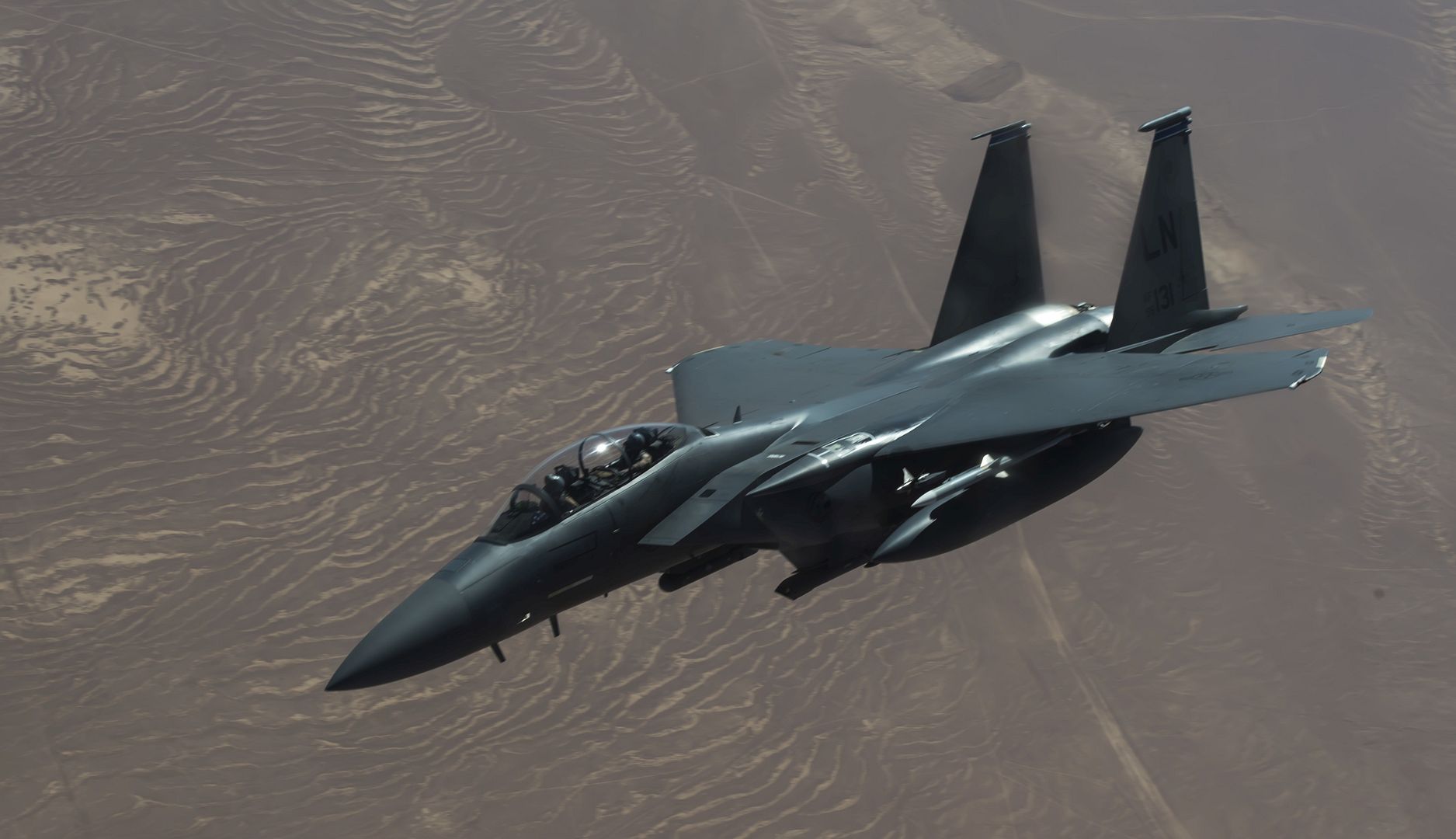
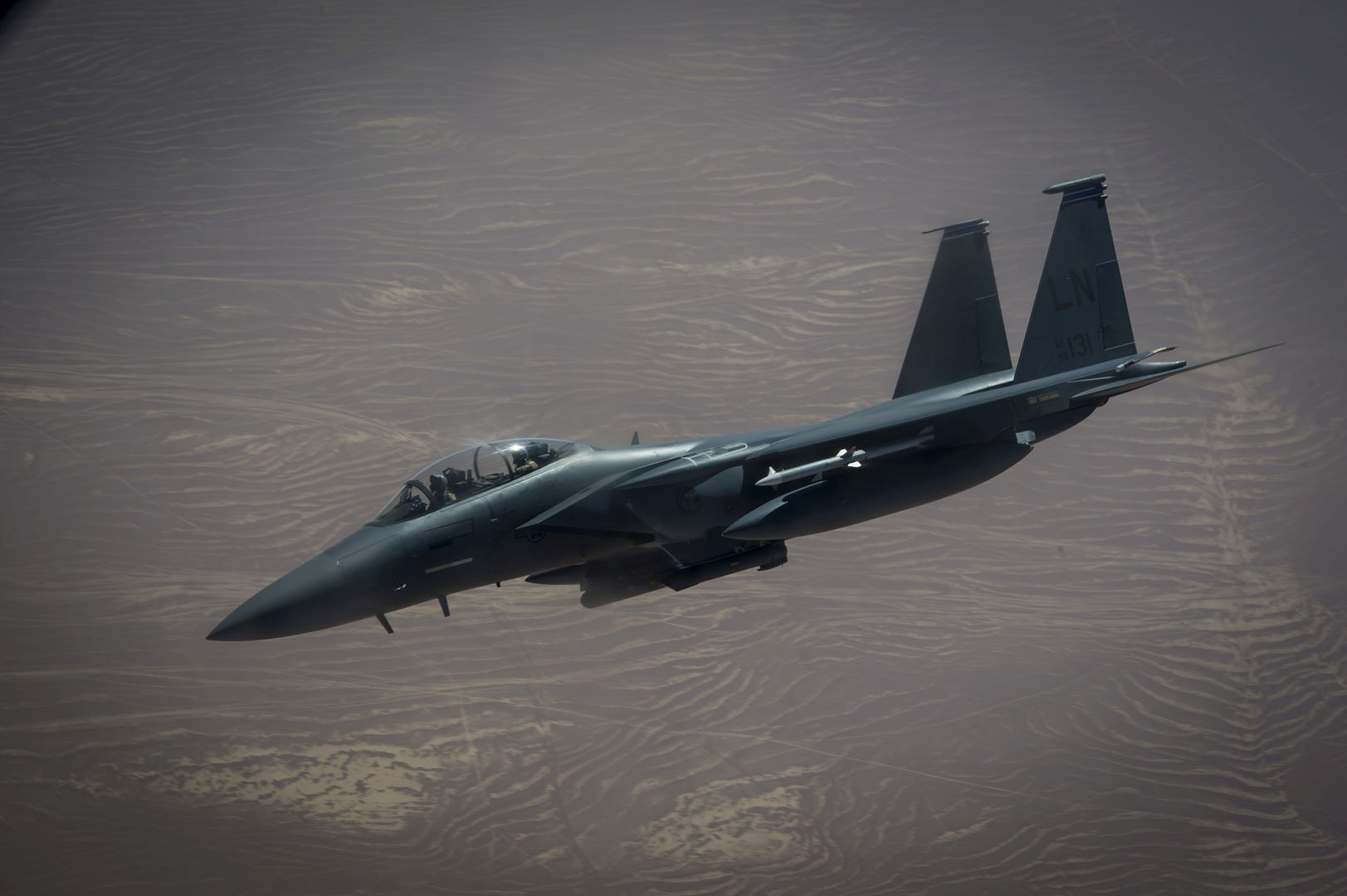
A U.S. Air Force A-10 Thunderbolt II departs after receiving fuel from a 340th Expeditionary Air Refueling Squadron KC-135 Stratotanker during a flight in support of Operation Inherent Resolve May 9, 2017. The KC-135 provides aerial refueling capabilities as it supports U.S. and coalition forces as they work to liberate territory and people under the control of ISIS. (U.S. Air Force photo by Staff Sgt. Michael Battles)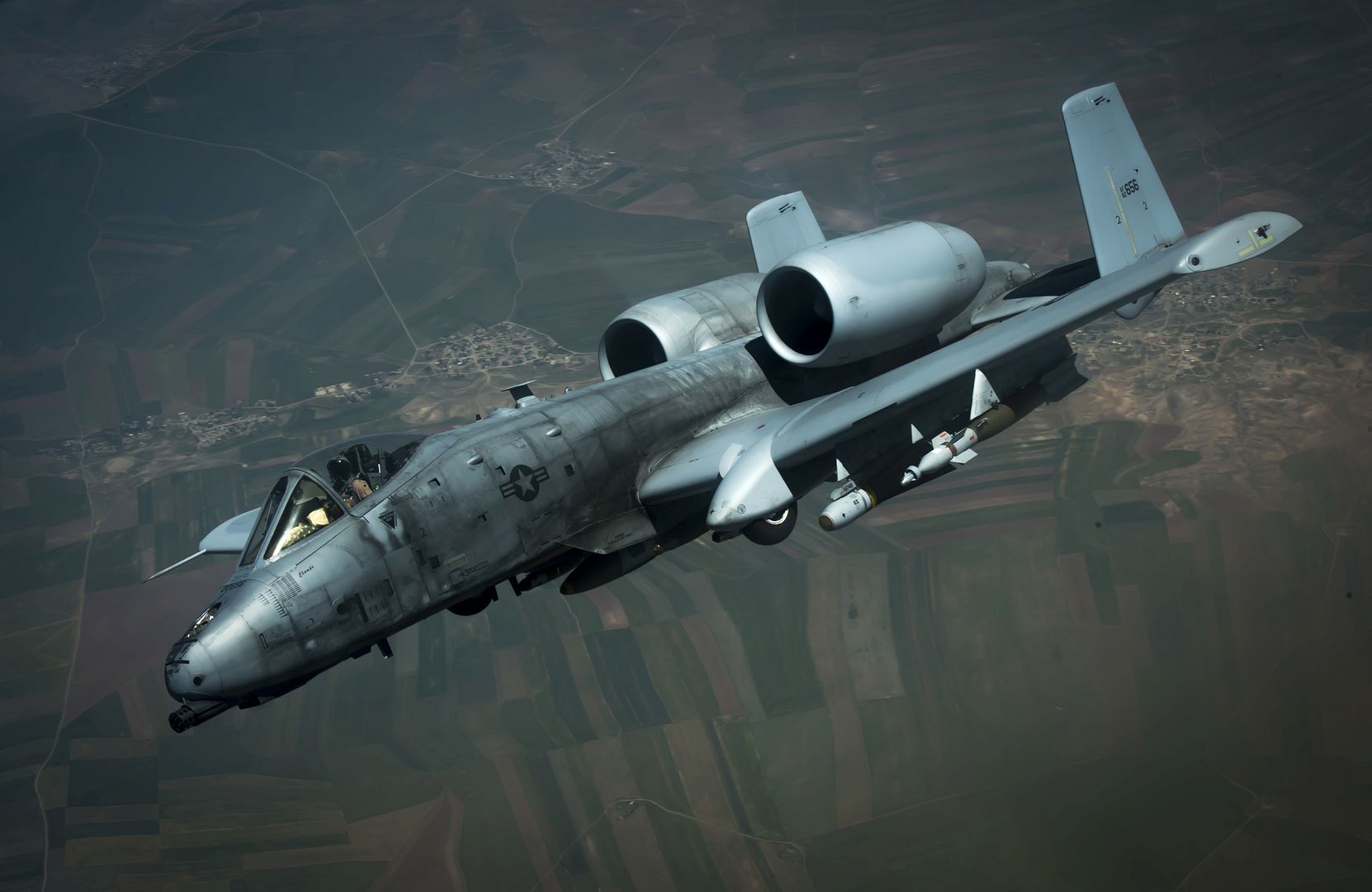
Two U.S. Air Force KC-135 Stratotanker pilots, assigned to the 340th Expeditionary Air Refueling Squadron, perform in-flight checklists during a flight in support of Operation Inherent Resolve May 9, 2017. The KC-135 provides aerial refueling capabilities as it supports U.S. and coalition forces as they work to liberate territory and people under the control of ISIS. (U.S. Air Force photo by Staff Sgt. Michael Battles)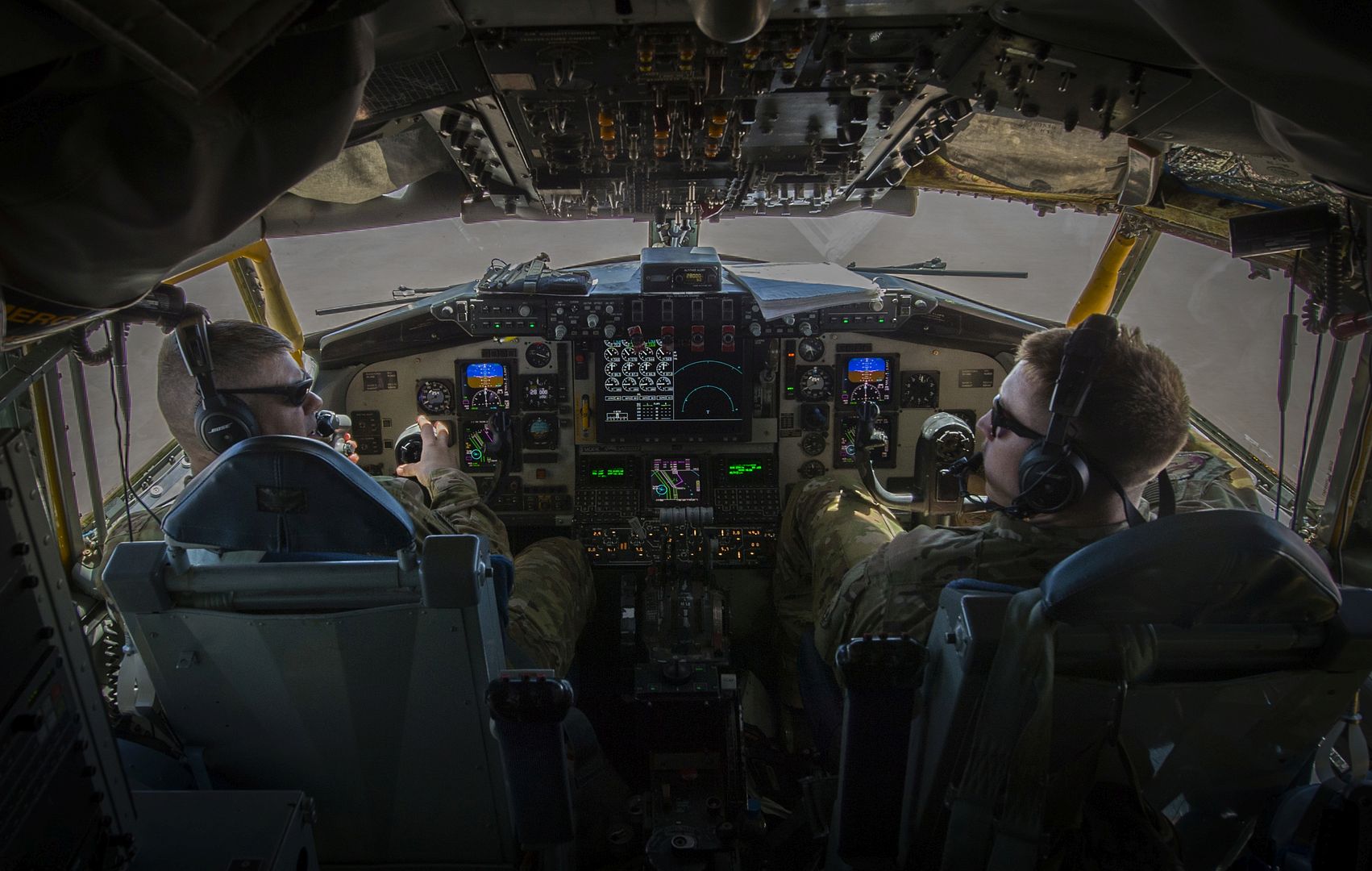
Two French fighter jets receive fuel from a KC-10 Extender during a flight in support of Operation Inherent Resolve May 9, 2017. The KC-135 provides aerial refueling capabilities as it supports U.S. and coalition forces as they work to liberate territory and people under the control of ISIS. (U.S. Air Force photo by Staff Sgt. Michael Battles)
A U.S. Air Force F-15 Strike Eagle prepares to receive fuel from a 340th Expeditionary Air Refueling Squadron KC-135 Stratotanker during a flight in support of Operation Inherent Resolve May 9, 2017. The KC-135 provides aerial refueling capabilities as it supports U.S. and coalition forces as they work to liberate territory and people under the control of ISIS. (U.S. Air Force photo by Staff Sgt. Michael Battles)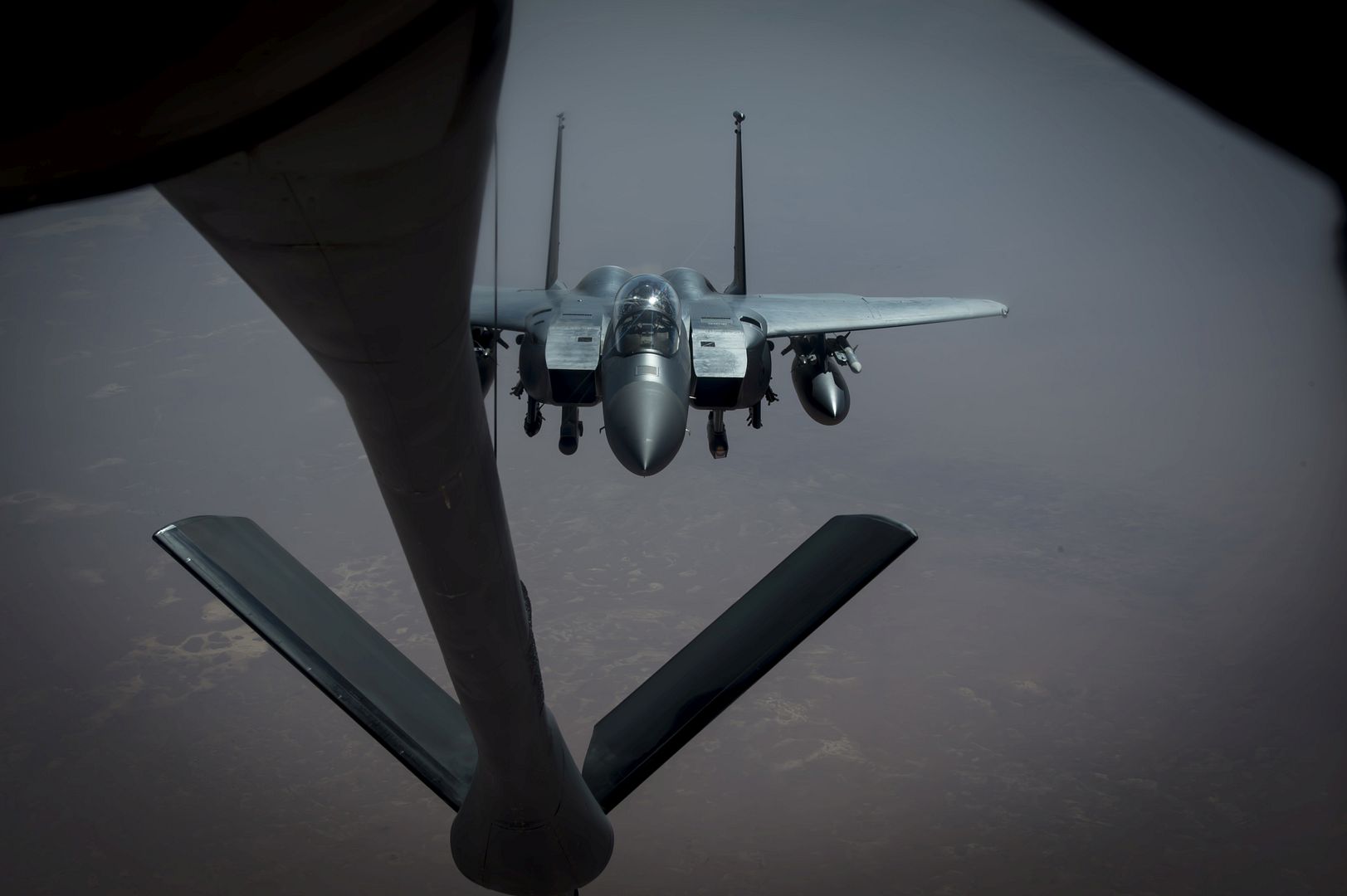
A U.S. Air Force F-15 Strike Eagle receives fuel from a 340th Expeditionary Air Refueling Squadron KC-135 Stratotanker during a flight in support of Operation Inherent Resolve May 9, 2017. The KC-135 provides aerial refueling capabilities as it supports U.S. and coalition forces as they work to liberate territory and people under the control of ISIS. (U.S. Air Force photo by Staff Sgt. Michael Battles)
8 May 2017 Press Release
The Airbus U.S. Manufacturing Facility in Mobile, Alabama, has received the major component assemblies for the first A320 that will be produced in the U.S. The 27 aircraft delivered from the facility thus far have been A321s.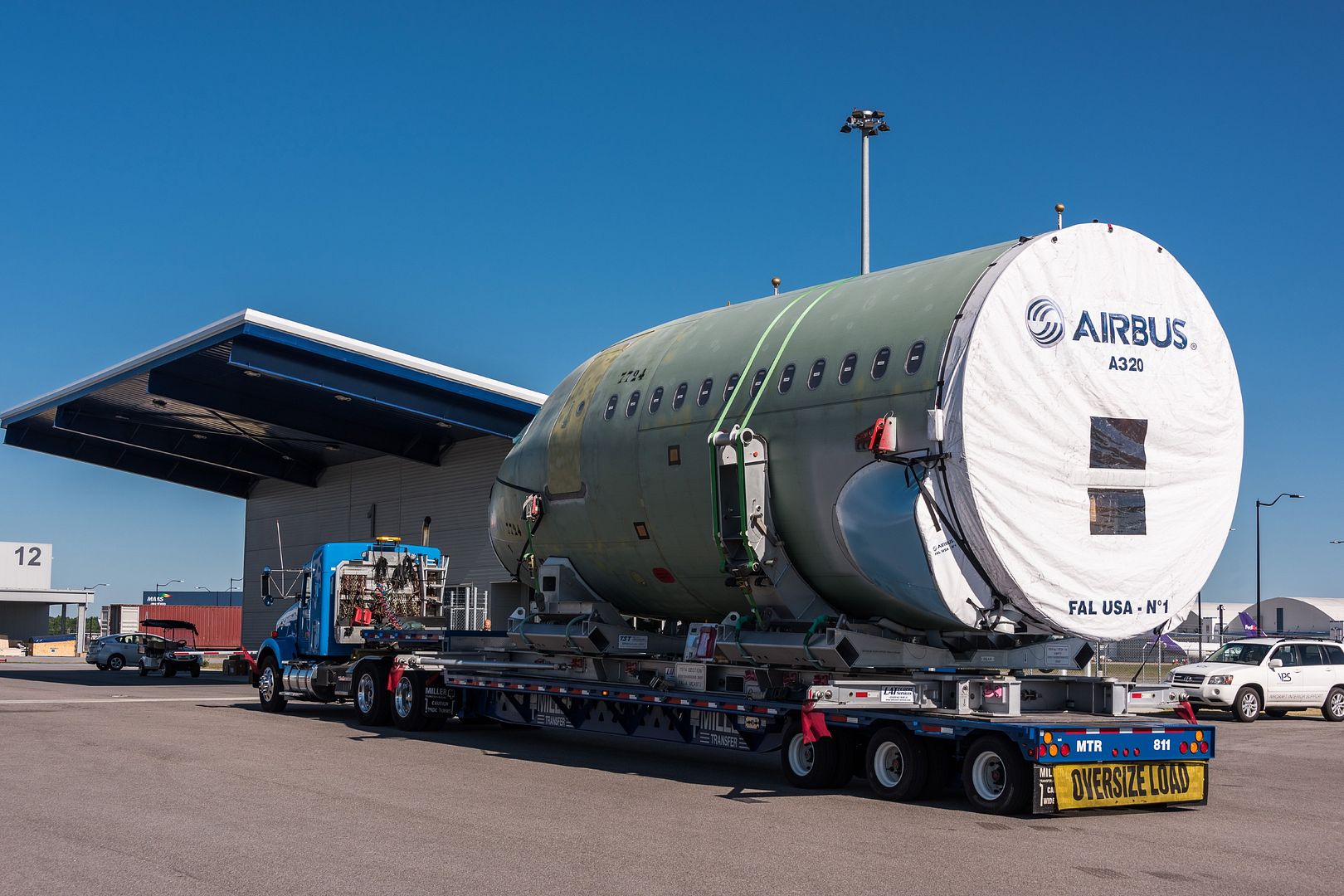
This marks another important milestone for the manufacturing facility, which began production in July 2015 and is equipped to build three members of the A320 Family: A319, A320 and A321.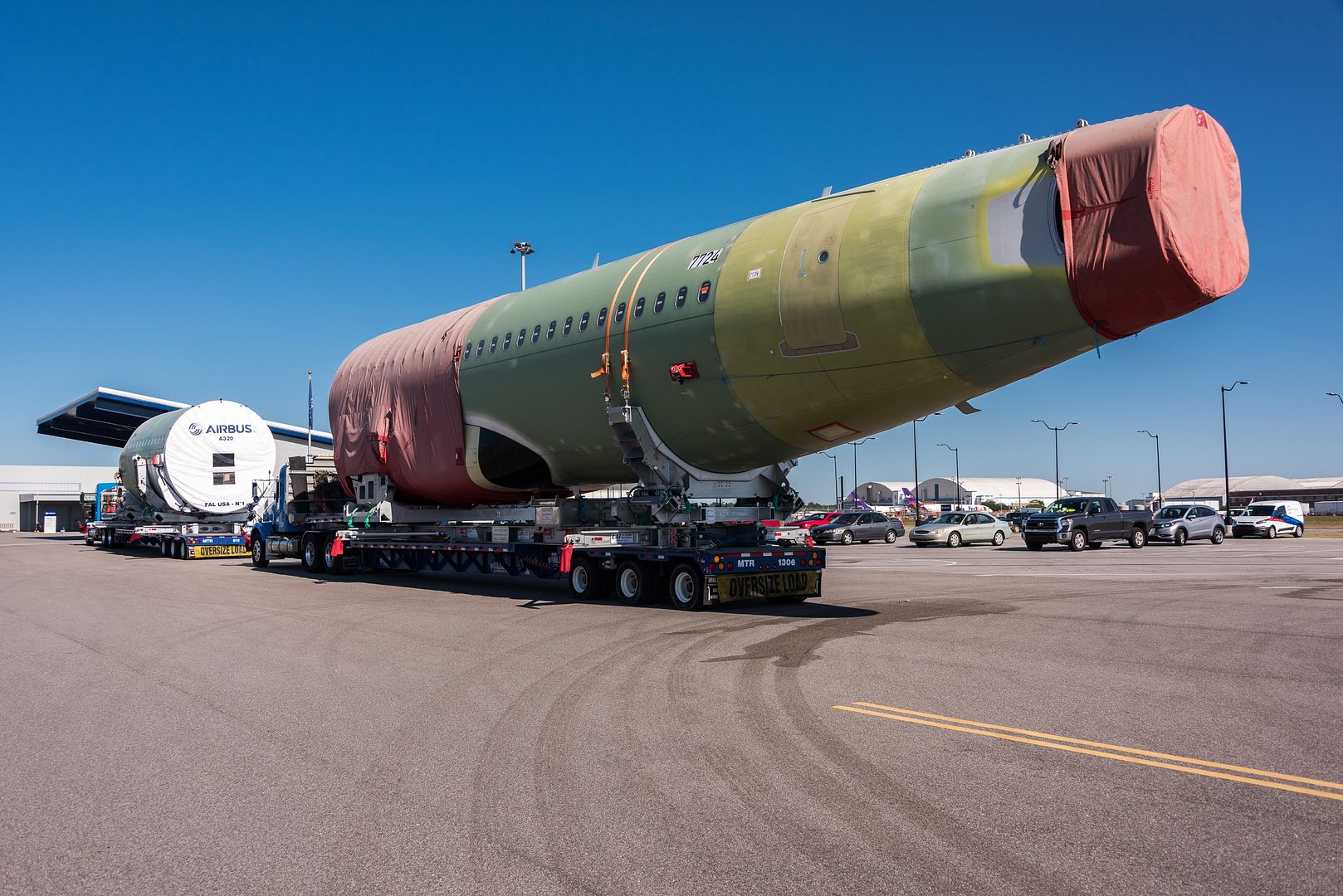
This A320 is destined to be delivered to Spirit Airlines this summer.
The Red Arrows have arrived in Tanagra, Greece to complete the team's annual pre-season training exercise known as Springhawk.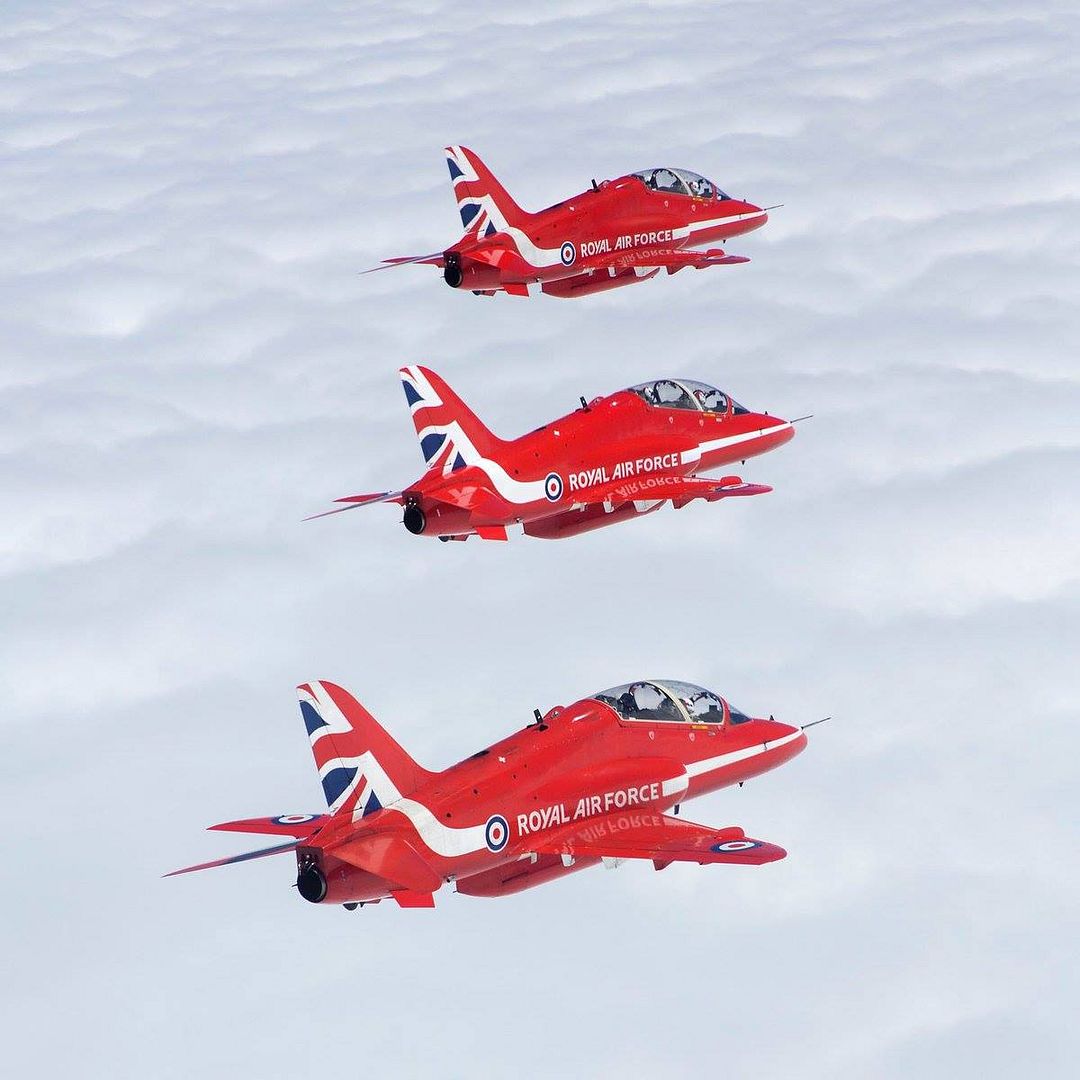
Post a reply
- Go to Previous topic
- Go to Next topic
- Go to Welcome
- Go to Introduce Yourself
- Go to General Discussion
- Go to Screenshots, Images and Videos
- Go to Off topic
- Go to Works in Progress
- Go to Skinning Tips / Tutorials
- Go to Skin Requests
- Go to IJAAF Library
- Go to Luftwaffe Library
- Go to RAF Library
- Go to USAAF / USN Library
- Go to Misc Library
- Go to The Ops Room
- Go to Made in Germany
- Go to Campaigns and Missions
- Go to Works in Progress
- Go to Juri's Air-Raid Shelter
- Go to Campaigns and Missions
- Go to Works in Progress
- Go to Skinpacks
- Go to External Projects Discussion
- Go to Books & Resources
